How to Get My Website More Traffic? (40+ ideas)

How to Use This Guide
Do you want more website traffic? Of course, you do! Who doesn’t?
In this blog post, we will discuss 40+ marketing tactics that you can use to increase traffic to your website, and increase people visiting your pop-up, retail store, or restaurant. We will cover a wide range of tactics, including both online and offline methods. So whether you are just starting out or have been in business for a while, there is something here for everyone!
There is something for every business.
Let’s get started.
Table of Contents
Why do you need to get attention?
If you are in business, whether you are a solopreneur, small business owner, or part of a larger company, one of your primary goals is to get more attention for your business. You want people to know about your products or services so that they can buy from you.
Don’t worry! There are many things you can do to increase traffic to your website and get more attention for your business
Best Way to Use this Post
There’s no such thing as a one-size-fits-all answer for the best traffic driving tactic. The best tactic for your business depends on your business goals, resources, and audience. However, all tactics can be classified into two general categories: short-term and long-term.
Short-term tactics usually see results quicker but require more maintenance or reinvestment. Long-term tactics take longer to see results but are more evergreen and require little maintenance.
Choose 1-3 tactics that feel easy & you believe will have a high ROI (return on investment) to focus on first.
The table below compares the effort, time to ROI, and cost of common traffic-driving tactics so you can decide which category is right for your business.
Tactic :
Effort:
ROI (return on investment):
Cost:
Traffic and Lead Generation:
I’ve broken the tactics into five categories:
- Hang with Your Customer
- Make it Easier to be Found
- Sweeten the Deal
- Let Others Speak for You
- Build Community
Effort
The categories under “effort” refer to the level of time, work, and resources required to implement and manage specific marketing tactics. Here’s a breakdown of what each effort category means:
Low Effort
Requires relatively minimal time and resources. They are typically easier to set up and manage, making them suitable for businesses with limited resources or those looking for quick and straightforward marketing solutions.
Medium Effort
Involves moderate time, work, and resources. They may require some planning, content creation, and ongoing management but are generally manageable for businesses willing to invest a reasonable amount of effort into their marketing efforts.
High Effort
Demands significant time, work, and resources. They often involve complex planning, extensive content creation, and ongoing monitoring and optimization. These tactics can be more resource-intensive and may require a dedicated team or external assistance.
These effort categories help businesses assess the practicality of implementing specific marketing strategies based on their available resources, skills, and objectives. Choosing tactics that align with the level of effort, you can commit to is essential for creating an effective and sustainable marketing plan.
ROI (return on investment)
ROI (return on investment):
Here’s an explanation of what each category means in regards to expected results:
Quick ROI (Short-term tactics)
Quick ROI marketing tactics, designed for immediate customer responses. Strategies like discounts, text message marketing, and PPC advertising are used to boost sales or leads quickly, usually within weeks or months.
Moderate ROI (Medium-term tactics)
Medium-term marketing tactics offer ROI within a few months to six months. These include hosting events, running contests, engaging in sponsorships, and participating in local events or fairs. They demand more effort but yield sustainable results, enhancing lead generation and brand awareness.
Longer-term ROI (Requires patience and consistency)
Tactics like SEO, content refresh, guest podcasting, and developing memberships or partnerships emphasize long-term growth. They require consistent effort and patience, often taking months to yield substantial results. These strategies focus on building a robust online presence and trust with audiences, gradually paying off over time.
It’s important to note that the effectiveness of each tactic can vary based on various factors, including industry, target audience, and the specific implementation of the strategy. Small businesses should consider their goals, resources, and timelines when choosing which tactics to prioritize within these categories.
Cost
The categories under “cost” in the context of marketing tactics refer to the approximate financial investment required to implement and execute those tactics. Here’s what each cost category means:

Highest Cost
Requires a substantial financial investment. These tactics often involve significant expenses for advertising, sponsorships, or other marketing initiatives. They are typically suited for businesses with larger budgets or those prioritizing high-impact, costly strategies. Monthly Cost Range: $5,000 and above

High Cost
Requires a notable financial investment, but they are generally more manageable than the highest-cost tactics. These strategies may involve expenses such as event hosting, paid advertising, or premium content creation. Small and mid-sized businesses with moderate budgets may consider these tactics. Monthly Cost Range: $2,000 to $5,000

Medium Cost
Involves a moderate financial investment. They typically include expenses like content creation, promotions, or event participation. These tactics are often suitable for businesses with limited budgets but are willing to allocate a reasonable amount of funds to marketing efforts. Monthly Cost Range: $500 to $2,000

Low Cost
Requires minimal financial investment. They are budget-friendly and can include social media marketing, email marketing, and content creation without significant expenses. These tactics are accessible to most businesses, especially those with limited budgets. Monthly Cost Range: $100 to $500

Lowest Cost
Incurs minimal to no financial expenses. They rely on organic efforts, personal time, and creativity. While they may not require a direct financial investment, they still demand effort and dedication. Small businesses with limited budgets or resource constraints can explore these tactics. Monthly Cost Range: Minimal to no ongoing cost, mainly time and effort
These cost categories help businesses assess the financial feasibility of various marketing strategies and align them with their budget constraints and marketing goals. Choosing tactics within the appropriate cost category ensures businesses can maximize their resources while achieving their desired outcomes.
Please note that these cost ranges are general estimates and can vary significantly depending on factors such as location, industry, and the scale of the marketing efforts. Small business owners should carefully budget and allocate resources based on specific circumstances and goals.
Traffic and Lead Generation
The five categories under “traffic and lead generation” describe how effective different marketing tactics are at driving website traffic and generating leads for your business. Here’s what each of these categories means:

High Traffic
Highly effective at driving a significant volume of website traffic and generating leads. They often produce immediate and substantial results, making them powerful tools for businesses looking to boost their online presence and capture leads quickly. Examples of tactics in this category include pay-per-click (PPC) advertising, search engine optimization (SEO), and social media advertising.

Moderate Traffic
Moderately effective at driving website traffic and generating leads. While they may not produce as high a volume of traffic and leads as the "High Traffic/Lead Generation" tactics, they can still provide valuable results over time. This category includes tactics like webinars, hosting events, and content contests.

Medium Traffic
Expected to provide a moderate website traffic and lead generation level. They may not produce significant results immediately but can steadily contribute to your online presence and lead generation efforts. Examples include surveys, quizzes, and user-generated content campaigns.

Low Traffic
Generate a relatively low volume of website traffic and leads. These tactics can still be valuable for specific goals but are not the primary drivers of traffic and lead generation. Examples in this category may include guest podcasting, guest speaking at industry events, and cold calling.

Minimal Traffic
Are not primarily focused on driving traffic or generating leads. They may have other purposes, such as building brand authority or community engagement. These tactics are not typically used as the primary website traffic sources or lead generation. An example could be listed on directories like Substack or Patreon.
Understanding these categories can help you prioritize your marketing efforts based on your specific goals, available resources, and desired outcomes. Depending on your business objectives, you may choose to use tactics from different categories to create a well-rounded marketing strategy.
Industries Covered

- Real Estate
- Charity Organizations
- Marketing Agencies
- Healthcare Services
- Hospitality
- Travel
- B2B (Business-to-Business)
- B2C (Business-to-Consumer)
- Education
- Finance/Insurance
- Consumer Goods
- Construction
- Restaurants
- Craft Food Products
- Retail Companies
- E-commerce
- Fitness and Wellness
- Technology and IT Services
- Event Planning and Management
- Art and Creative Services
- Legal Services
- Home Improvement and Renovation
- Pet Services
- Transportation and Logistics
- Environmental Services
- Entertainment and Event Services
- Personal Services
- Manufacturing
- Health and Beauty
- Agriculture and Farming
- Nonprofit and Social Services
- Legal and Financial Services
- Interior Design and Home Decor
- Childcare and Early Education
- Fitness and Sports Equipment
Table of Contents
Hang with Your Customer
Email Marketing
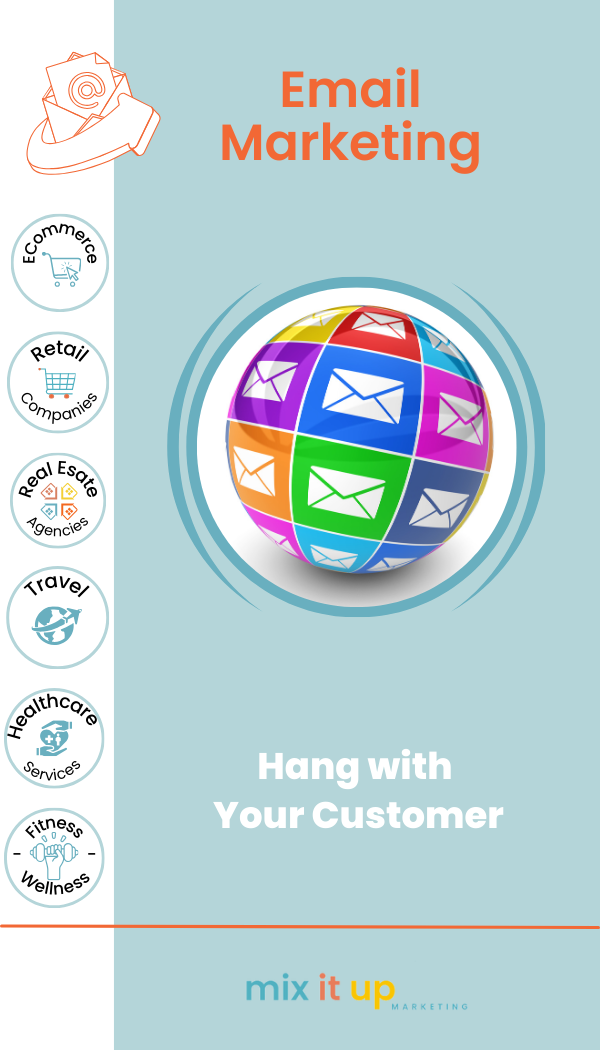
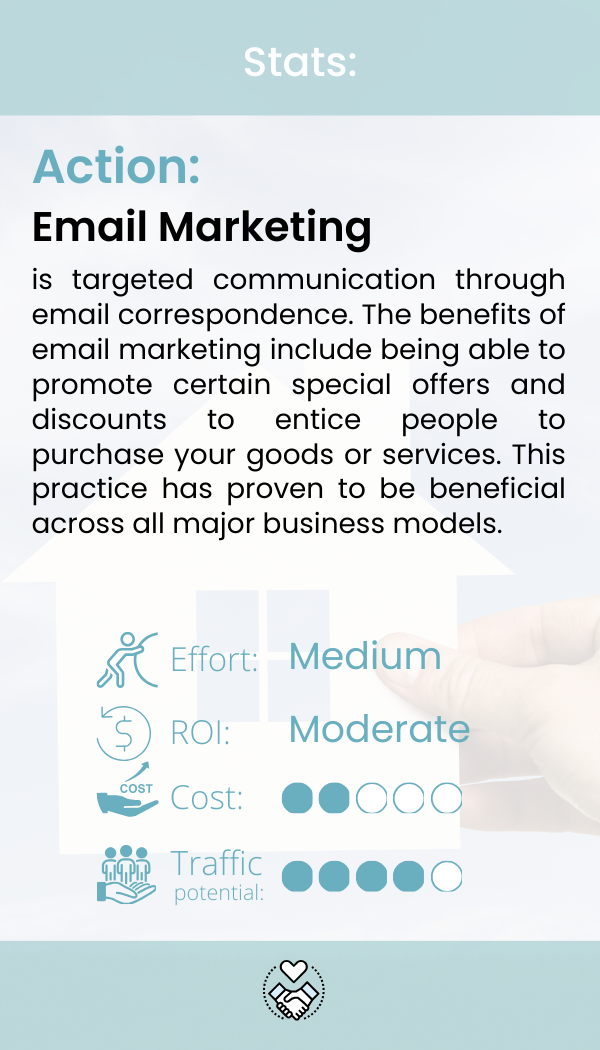
Email marketing is targeted communication through email correspondence. The benefits of email marketing include being able to promote certain special offers and discounts to entice people to purchase your goods or services. This practice has proven to be beneficial across all major business models.
Rating for Email Marketing:
Effort: Medium Effort – Email marketing involves a moderate level of effort, including creating content, managing mailing lists, and analyzing responses.
Return on Investment: Moderate ROI – Email marketing often yields sustainable results over a few months, enhancing brand awareness and customer loyalty.
Cost: Low Cost – Generally requires a minimal financial investment, primarily for email marketing software and perhaps content creation.
Website Traffic/Lead Generation: Moderate Traffic – Effective at driving website traffic and generating leads, but not as high as some other tactics like PPC advertising.
Industries Who Most Benefit
Business Categories Benefiting from Email Marketing:
- Real Estate: Sharing listings, market updates, and home-buying tips can keep clients engaged and prompt action when the time is right.
- Healthcare Services: Providing health tips, updates on services, and special offers can encourage repeat visits and referrals.
- Travel: Regular newsletters with travel deals and destination insights can trigger bookings and repeat business.
- Education: Updates about courses, educational tips, and special offers can keep learners engaged and promote course enrollments.
- Retail Companies: Sharing product updates, special offers, and shopping tips can drive sales and customer loyalty.
- E-commerce: Tailored offers and product recommendations based on user history can significantly boost sales.
- Fitness and Wellness: Tips, member success stories, and special class offers can increase engagement and memberships.
- Technology and IT Services: Providing tech tips, industry updates, and service promotions can build long-term client relationships.
- Event Planning and Management: Sharing success stories, event tips, and service promotions can attract new clients.
- Health and Beauty: Tips, product information, and special offers can drive repeat purchases and client loyalty.
Social Media


- FB,
- Instagram,
- LinkedIn,
- YouTube,
- Pinterest,
- Reddit,
- Twitter,
- Tik Tok
Social media marketing is the promotion of a good or service on social media channels. The benefits of this include increased brand awareness and promotion for your brand. All industries should use social media marketing; however, fast food chains have been incredibly successful in recent years such as Wendy’s famous Twitter marketing campaign.
Ratings for Social Media Marketing Tactic:
Effort: Medium Effort – Social media requires consistent content creation, engagement, and monitoring, but is generally manageable with a planned approach.
Return on Investment: Moderate ROI – While immediate results can be seen, the real value of social media grows over time, enhancing brand awareness and lead generation.
Cost: Low Cost – Generally requires minimal financial investment unless opting for paid advertising. Main costs are time and creative effort.
Traffic Potential: High Traffic – Social media is highly effective at driving website traffic and generating leads, especially with targeted content and engagement strategies.
Industries Who Most Benefit
The “Social Media” marketing tactic can benefit a wide range of industries. Here are the industries that would most benefit from utilizing social media marketing:
Restaurants: Sharing enticing images of dishes, behind-the-scenes content, and promoting special events on platforms like Instagram and Facebook can attract local customers.
Health and Beauty: Utilizing visual platforms like Instagram and YouTube for tutorials and product showcases can effectively engage potential customers.
Fitness and Wellness: Sharing workout videos on YouTube and motivational posts on Instagram can help in building a community and promoting services.
E-commerce: Leveraging Instagram and Facebook for showcasing products and using TikTok for viral marketing campaigns can drive significant traffic and sales.
Real Estate: Utilizing platforms like Instagram and YouTube for property showcases and market insights can attract potential buyers and sellers.
Travel: Sharing travel tips, destination highlights, and user-generated content on platforms like Instagram and Pinterest can inspire and attract travelers.
Event Planning and Management: Showcasing successful events on Instagram and Facebook can help in attracting new clients looking for event organization services.
Art and Creative Services: Platforms like Instagram and Pinterest are ideal for showcasing artwork and creative projects to a broader audience.
Technology and IT Services: Using LinkedIn for B2B networking and YouTube for product demos can effectively reach potential clients and partners.
Education: Educational content, tutorials, and student engagement on platforms like YouTube and Instagram can attract students and promote educational services.
These are just some examples; virtually any industry can benefit from a well-executed social media marketing strategy. The key is to tailor the approach to the specific industry, audience, and goals.
Listed on directories
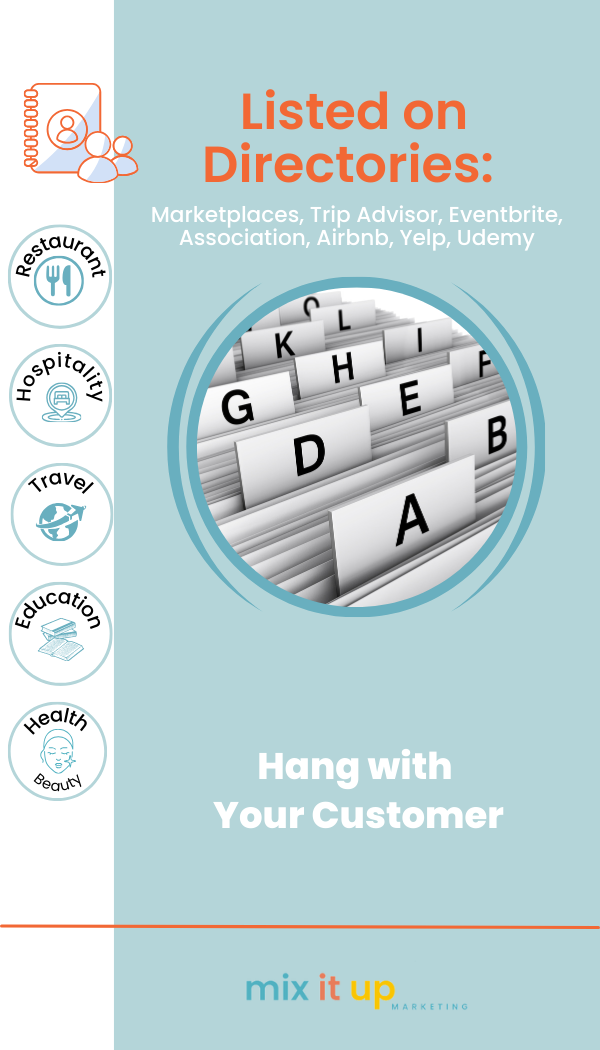
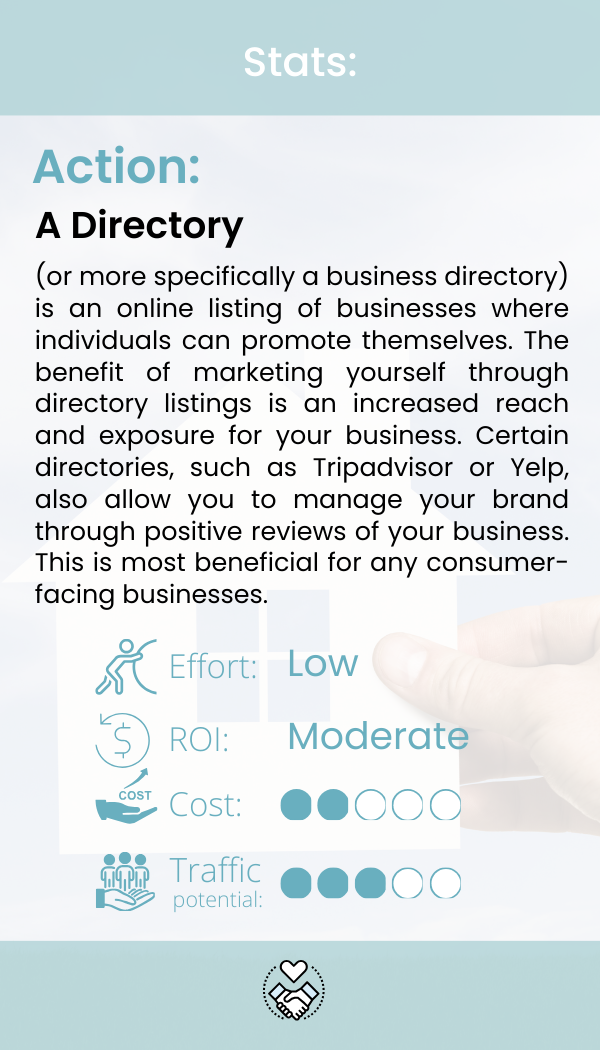
- Marketplaces
- Trip Advisor
- Eventbrite
- Association
- Airbnb
- Yelp
- Udemy
A directory (or more specifically, a business directory) is an online listing of businesses where individuals can promote themselves. The benefit of marketing yourself through directory listings is an increased reach and exposure for your business. Certain directories, such as Tripadvisor or Yelp, also allow you to manage your brand through positive reviews of your business. This is most beneficial for any consumer-facing business.
Ratings for Listing on Directories Tactic:
Effort: Low Effort – Listing on directories typically requires minimal effort, primarily involving setting up a profile and updating it periodically.
Return on Investment: Moderate ROI – This tactic offers medium-term benefits by increasing visibility and credibility, which can lead to gradual increases in customer engagement and sales.
Cost: Lowest Cost – Most directory listings are free or have a minimal cost, making them accessible for businesses of all sizes.
Traffic Potential: Medium Traffic – Being listed on directories can drive a moderate amount of traffic, especially if the business is in a niche with less competition or in directories with high user engagement.
Overall, listing on directories is a valuable tactic for businesses looking to increase their online presence, attract potential customers, and expand their reach within their respective industries.
Industries Who benefit Most
Listing on directories such as marketplaces, TripAdvisor, Eventbrite, associations, Airbnb, Yelp, and Udemy can benefit various industries, but it tends to be particularly advantageous for the following:
- Restaurants: Ideal for Yelp and TripAdvisor, to attract local diners and tourists looking for dining options.
- Travel Agencies: Listings on Trip Advisor and Eventbrite can showcase travel packages and special tours.
- Hospitality Businesses (Hotels, B&Bs): Airbnb and TripAdvisor listings can significantly boost visibility to travelers.
- Event Planning and Management: Eventbrite listings can help showcase events and attract attendees.
- Education Providers (like Tutoring Services): Udemy allows for offering online courses, expanding their reach.
- Health and Beauty Services: Yelp listings can help locals discover salons and spas.
- Real Estate Agencies: Marketplaces and association directories can increase visibility to potential clients.
- Legal Services: Being listed in relevant association directories can enhance professional credibility and visibility.
- Home Improvement and Renovation Services: Yelp and other local directories can help homeowners find their services.
- Fitness and Wellness Centers: Listing on Yelp and niche directories can attract individuals interested in health and fitness services.
These businesses would most benefit from directory listings due to the high relevance of customer reviews, local search visibility, and the nature of their services, which often rely on local or tourist traffic.
QR codes
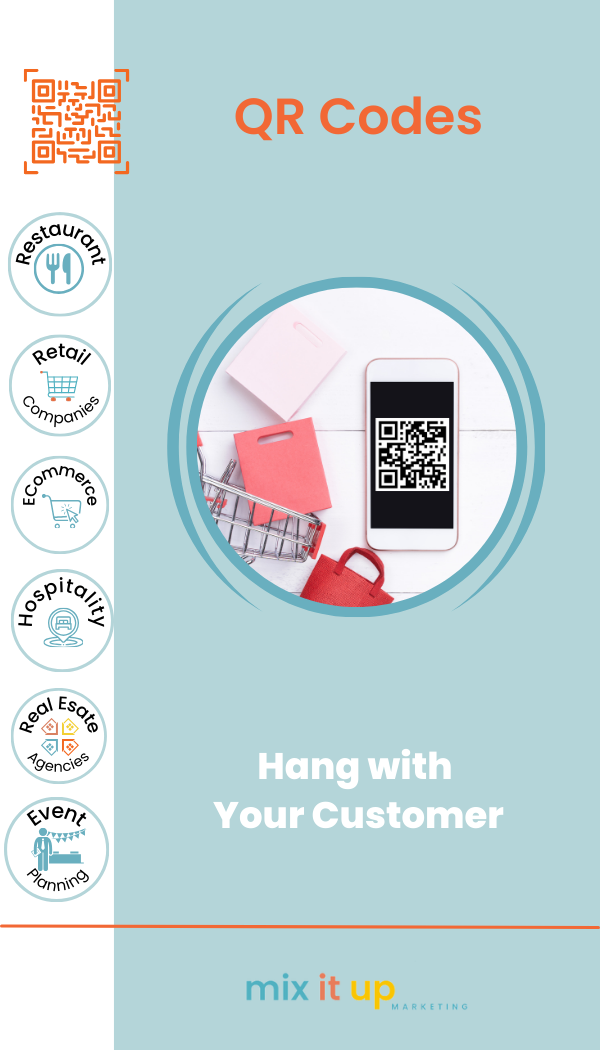
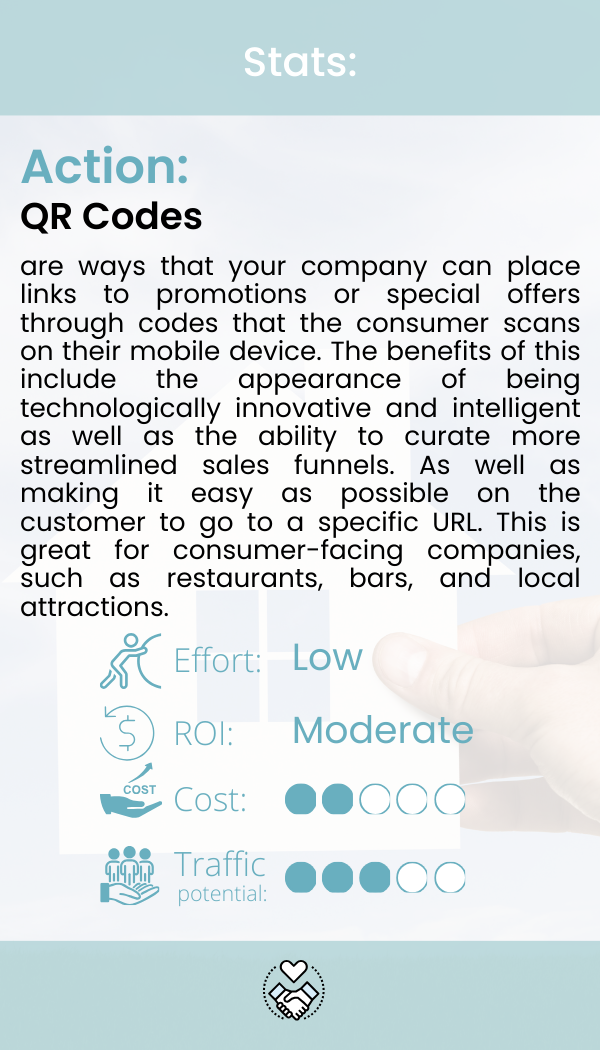
QR codes are ways that your company can place links to promotions or special offers through codes that the consumer scans on their mobile device. The benefits include the appearance of being technologically innovative and intelligent and the ability to curate more streamlined sales funnels. As well as making it as easy as possible for the customer to go to a specific URL. This is great for consumer-facing companies like restaurants, bars, and local attractions.
Ratings for QR Code Marketing Tactic:
Effort: Low Effort – QR codes are relatively easy to create and can be integrated into various marketing materials with minimal effort.
Return on Investment: Moderate ROI – QR codes can provide a good ROI, especially when they link to compelling content or offers, but it usually takes some time to see significant results.
Cost: Lowest Cost – Generally, QR codes are inexpensive to generate and can be printed on existing marketing materials, incurring minimal additional costs.
Website Traffic/Lead Generation: Medium Traffic – QR codes can effectively drive traffic to specific web pages, promotions, or digital content, leading to moderate traffic and lead generation.
Overall, QR codes are a versatile and effective marketing tool for a range of industries, offering low effort, quick ROI, and the potential for high traffic and lead generation when implemented thoughtfully.
Industries That Most Benefit
QR codes can be beneficial for a variety of industries. Here are some industries that can benefit from using QR codes as a marketing tactic:
- Restaurants: QR codes for menus or promotions directly at tables.
- Retail Companies: In-store QR codes linking to online product details or exclusive offers.
- E-commerce: QR codes in packaging for easy reordering or to direct customers to related products.
- Event Planning and Management: QR codes on event materials for schedules, maps, or feedback forms.
- Hospitality: In-room QR codes in hotels for services, feedback, or local attractions.
- Healthcare Services: QR codes in waiting rooms for health information or appointment booking.
- Real Estate: QR codes on property listings for virtual tours or detailed property information.
- Fitness and Wellness: QR codes in gyms for class schedules or health tips.
- Technology and IT Services: QR codes on products for quick access to support or setup guides.
- Education: QR codes in educational materials for additional resources or interactive content.
These are just some examples, and QR codes can be applied creatively across industries to enhance marketing efforts and provide valuable information or interactions to customers and clients.
Engage in sponsorships (school auctions, sports teams, conferences, association events, events & gala fundraisers)
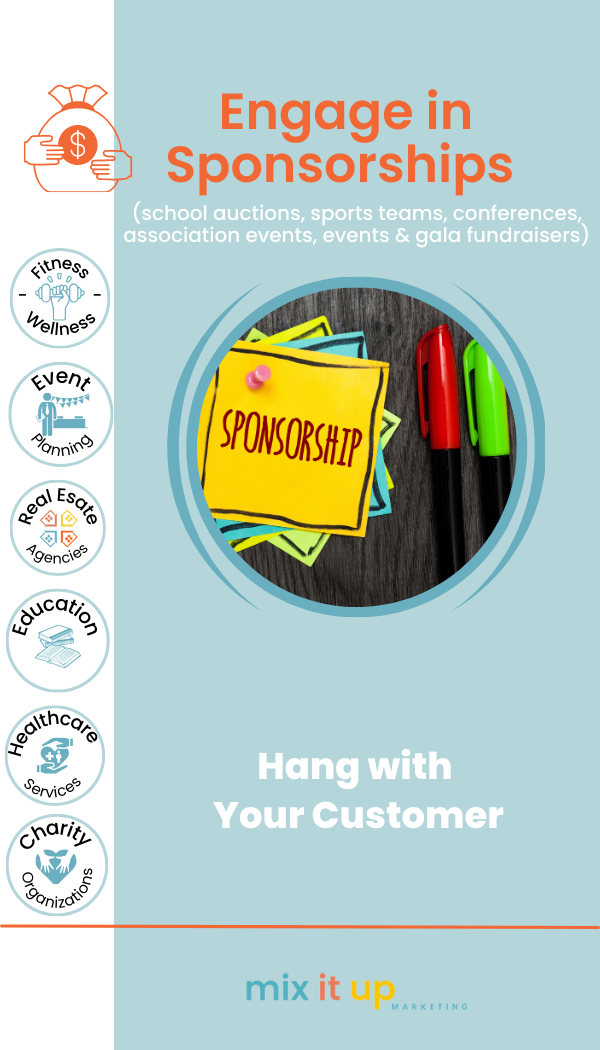
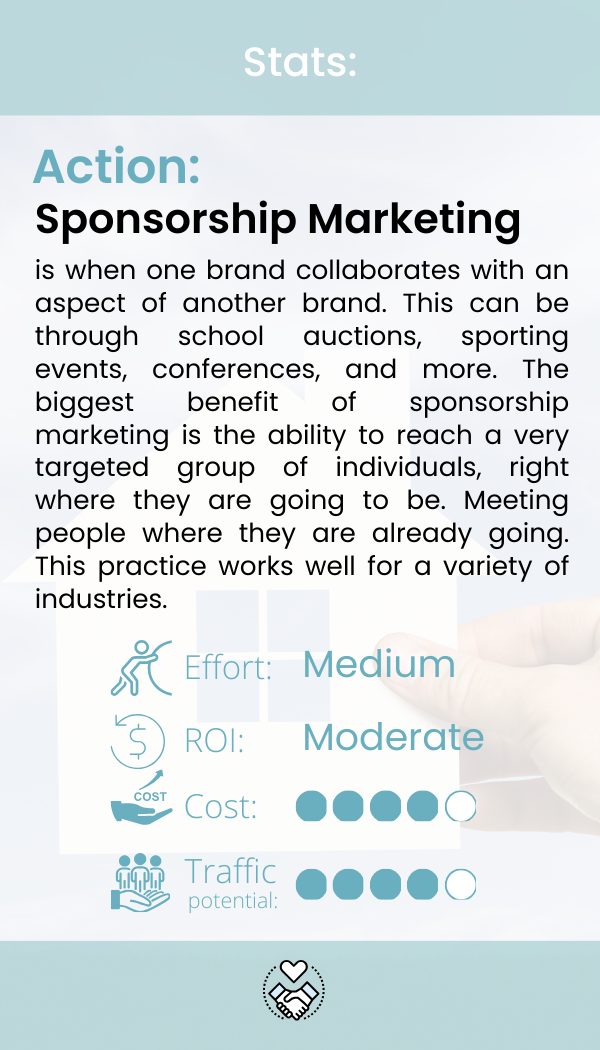
Sponsorship marketing is when one brand collaborates with an aspect of another brand. This can be through school auctions, sporting events, conferences, and more. The most significant benefit of sponsorship marketing is reaching a very targeted group of individuals right where they will be, meeting people where they are already going. This practice works well for a variety of industries.
Ratings for Sponsorship Marketing Tactic:
Effort: Medium Effort – Engaging in sponsorships involves identifying relevant events, negotiating terms, and creating marketing materials, which demands moderate planning and resources.
Return on Investment: Moderate ROI – Sponsorships can enhance brand visibility and reputation over a few months, offering medium-term benefits in terms of brand recognition and networking.
Cost: Medium to High Cost – Depending on the scale and type of event, sponsorships can require a significant financial investment, particularly for more prominent events or teams.
Website Traffic/Lead Generation: Moderate Traffic – While not directly driving website traffic, sponsorships can increase brand awareness, leading to indirect traffic increases and lead generation.
Industries That Would Benefit
The marketing tactic “Engage in sponsorships (school auctions, sports teams, conferences, association events, events & gala fundraisers)” can benefit various industries. Here are the industries that can benefit from this tactic:
Real Estate: Sponsoring local events can elevate a real estate agency’s community profile, fostering trust and recognition.
Charity Organizations: Sponsoring events aligns with their mission, increases exposure, and can attract more donors and volunteers.
Healthcare Services: Sponsorships at health and wellness events can help healthcare providers reach potential patients and partners.
Travel Agencies: Sponsoring travel expos or local festivals can position them as go-to experts for travel planning.
Education Services: Sponsoring educational events or school functions can build goodwill and increase visibility among families.
Fitness and Wellness: Sponsoring sports events or wellness fairs can directly connect them with their target market.
Legal Services: Sponsoring community or professional events can enhance their reputation and professional network.
Event Planning and Management: Sponsoring local events can showcase their capabilities and attract new clients.
Technology and IT Services: Sponsoring tech conferences or local business events can increase their visibility in the business community.
Entertainment and Event Services: Sponsoring community events can directly showcase their services and attract new clients.
Remember that the effectiveness of this tactic can vary based on the specific event or sponsorship opportunity, the industry’s goals, and the local community’s dynamics. Choosing sponsorships that align with your business objectives and target audience is essential.
Farmers Markets, Fairs/ Festivals, Pop-ups

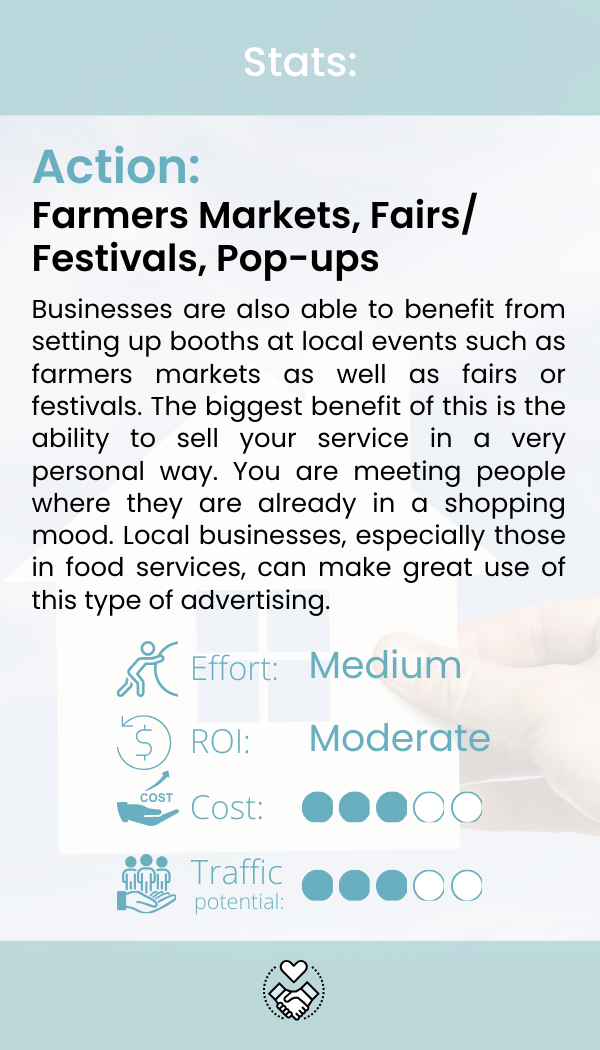
Businesses can also benefit from setting up booths at local events such as farmers markets and fairs or festivals. The most significant benefit of this is the ability to sell your service in a very personal way. You are meeting people who are already in a shopping mood. Local businesses, especially those in food services, can significantly use this type of advertising.
Ratings for Farmers Markets or Pop Ups Marketing Tactic:
Effort: Medium Effort – This involves moderate planning, setting up stalls or booths, and engaging with customers face-to-face.
Return on Investment: Moderate ROI – These events offer potential for good sales and brand exposure, yielding ROI typically within a few months.
Cost: Medium Cost – Costs include booth rental, materials for setup, product samples, and travel. Monthly Cost Range: $500 to $2,000.
Website Traffic and Lead Generation: Medium Traffic – These events can drive moderate traffic to a website, especially if promotional materials encourage online engagement.
Industries That Would Benefit the Most
The marketing tactic of participating in Farmers’ Markets, Fairs, and Festivals or setting up Pop-up shops is particularly beneficial for the following industries:
- Craft Food Products: Great for showcasing unique food products; encourages local and community support.
- Retail Companies: Opportunity to display products directly to consumers, enhancing brand visibility.
- E-commerce: Physical presence at events can complement online sales, creating a tangible brand experience.
- Fitness and Wellness: Showcase health-related products or services, like wellness workshops or fitness gear.
- Art and Creative Services: Ideal for artists and creatives to display and sell their work directly.
- Health and Beauty: Opportunity to demo products and gain direct customer feedback.
- Home Improvement and Renovation: Showcase DIY tools, home decor, or renovation services.
- Pet Services: Good venue for pet-friendly products or services.
- Consumer Goods: Direct consumer interaction helps understand market needs and preferences.
- Agriculture and Farming: Perfect for farmers to sell produce or homemade goods directly to consumers.
Answer questions HARO, Quora, Groups, Reddit
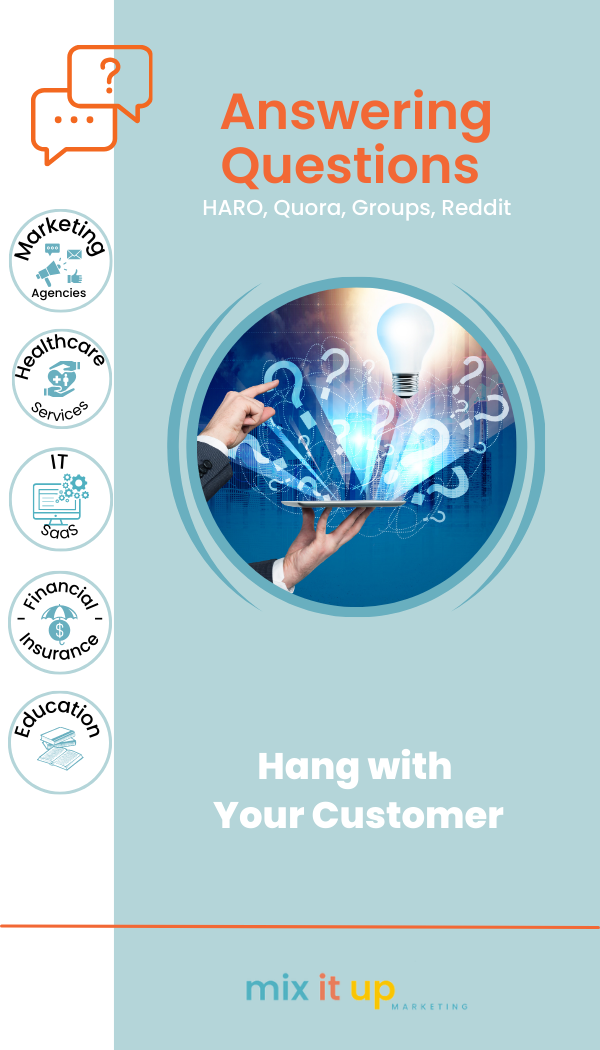
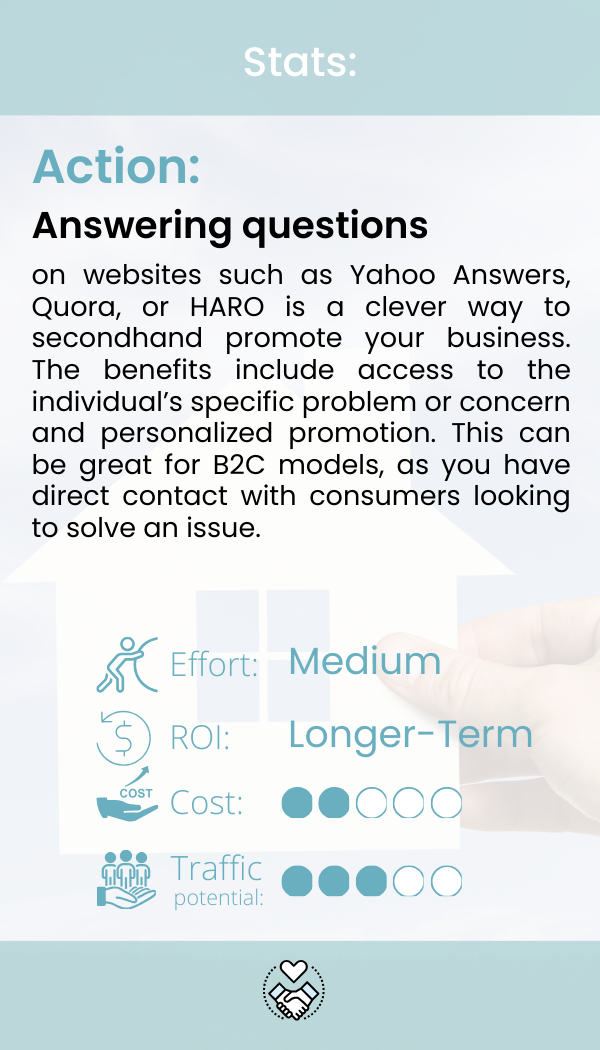
Answering questions on websites such as Yahoo Answers, Quora, or HARO is a clever way to promote your business secondhand. The benefits include access to the individual’s specific problem or concern and personalized promotion. This can be great for B2C models, as you have direct contact with consumers looking to solve an issue.
Ratings for Answering Questions Marketing Tactic:
Effort: Medium Effort- This tactic requires regular participation and thoughtful, well-researched answers to be effective.
Return on Investment: Longer-term ROI- While it may not yield immediate results, consistently providing valuable answers can build authority and trust over time, leading to long-term benefits.
Cost: Lowest Cost – Primarily demands time and expertise with minimal financial investment.
Traffic Potential: Medium Traffic – This approach can drive moderate website traffic and lead generation, especially if answers gain visibility and credibility.
Industries That Would Benefit
The marketing tactic “Answering questions on HARO, Quora, Groups, and Reddit” can benefit many industries. Here are the industries that would most benefit from this tactic:
Marketing Agencies: By answering industry-specific questions, they can demonstrate their expertise and attract businesses looking for marketing services.
Healthcare Services: Healthcare professionals can provide valuable advice on health-related queries, establishing trust and attracting patients.
Legal Services: Lawyers can answer legal questions, showcasing their knowledge and attracting potential clients.
Technology and IT Services: Tech companies can offer solutions to technical problems, positioning themselves as knowledgeable in their field.
Education: Educational institutions or tutors can provide insights on academic topics, attracting students or parents.
Finance/Insurance: Financial advisors can offer advice on financial queries, drawing in clients who need financial planning services.
Fitness and Wellness: Fitness experts can answer health and wellness questions, building a reputation and attracting health-conscious individuals.
Craft Food Products: By engaging in relevant food communities, they can share knowledge about unique ingredients or cooking techniques, appealing to food enthusiasts.
E-commerce: E-commerce businesses can answer queries related to online shopping, product selection, or industry trends.
Environmental Services: By providing insights on environmental issues, these businesses can demonstrate their commitment and expertise in this field.
Direct Mail Marketing
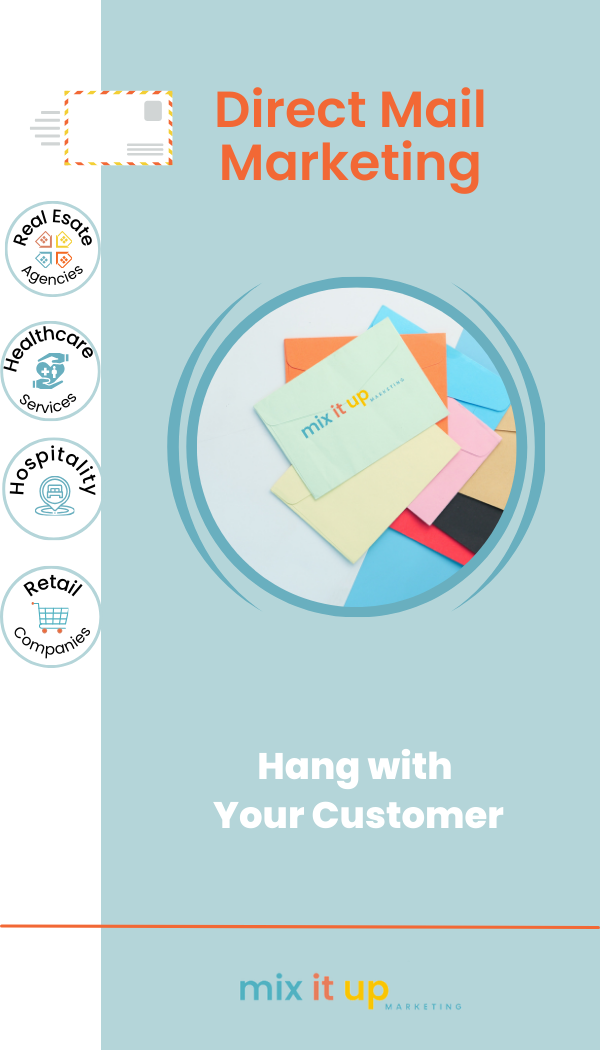
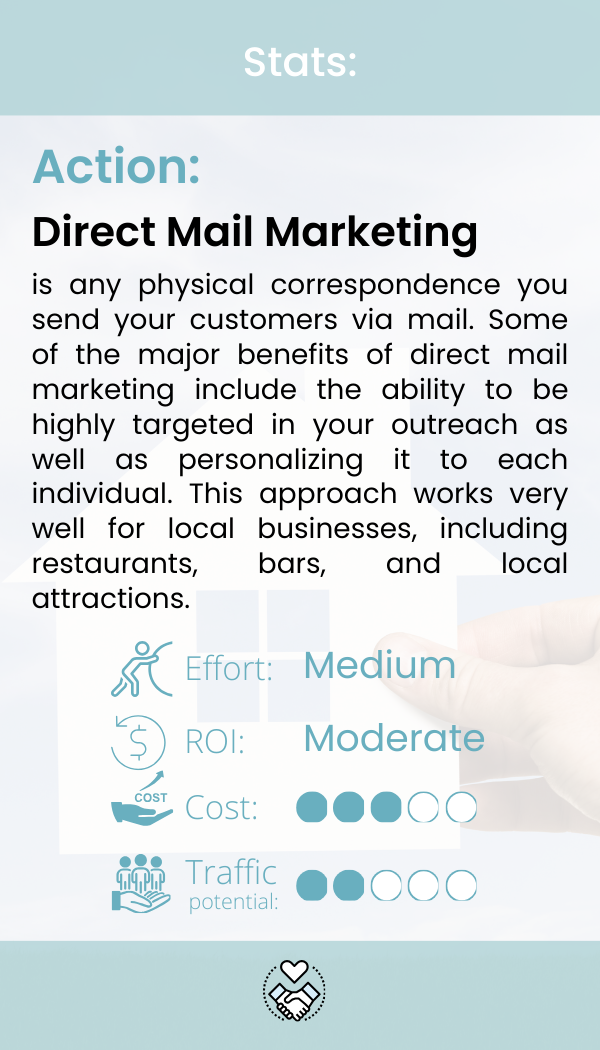
Direct mail marketing is any physical correspondence you send your customers via mail. Some significant benefits of direct mail marketing include being highly targeted and personalizing your outreach to each individual. This approach works well for local businesses, including restaurants, bars, and attractions.
Ratings for Direct Mail Marketing Tactic:
Effort: Medium Effort -Direct Mail requires a moderate level of effort, including designing, printing, and distributing the materials. It demands planning and coordination but is manageable.
Return on Investment: Moderate ROI (Medium-term tactics) -Direct Mail can offer a return on investment over a few months. It’s effective for targeted marketing, leading to sustainable results in brand awareness and customer engagement.
Cost: Medium Cost – Involves costs like design, printing, and postage. While not the cheapest, it’s a viable option for businesses with a modest marketing budget.
Website Traffic/Lead Generation: Low Traffic – Direct Mail is more about direct engagement than driving website traffic. It’s effective for personalized communication but not primarily aimed at generating online leads or traffic.
Industries That Would Benefit
- Real Estate: Sending out personalized property listings or open house invitations to potential clients in specific areas.
- Healthcare Services: Mailing informational brochures about services or health tips to local residents.
- Hospitality: Sending special offers or event announcements to previous guests or targeted demographics.
- Travel Agencies: Mailing customized travel packages or special deal flyers to frequent travelers.
- Education: Sending course catalogs or enrollment information to potential students or their families.
- Finance/Insurance: Mailing information about new services, financial advice, or policy updates to clients.
- Restaurants: Sending menus or special discount coupons to local residents.
- Retail Companies: Mailing catalogs or exclusive offers to loyal customers or a targeted customer base.
- Fitness and Wellness Centers: Sending membership offers, health tips, or event information to local residents.
- Legal Services: Mailing information about legal services or free consultation offers to targeted demographics.
These industries can benefit from direct mail marketing when they have a target audience that can be effectively reached through physical mailings. The success of direct mail campaigns often depends on creating compelling and personalized content that resonates with the recipients.
In-person Networking
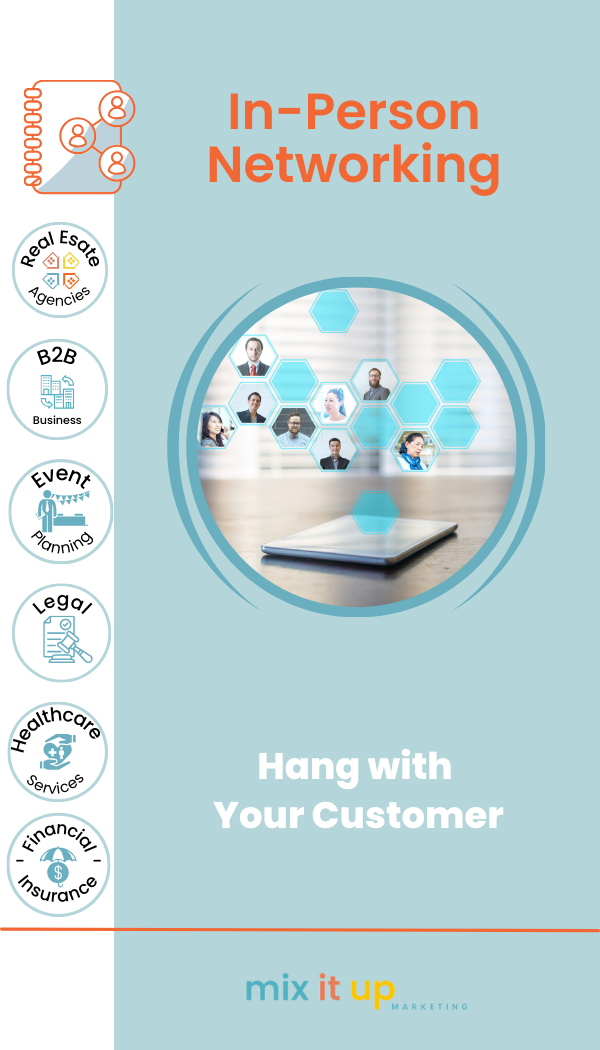
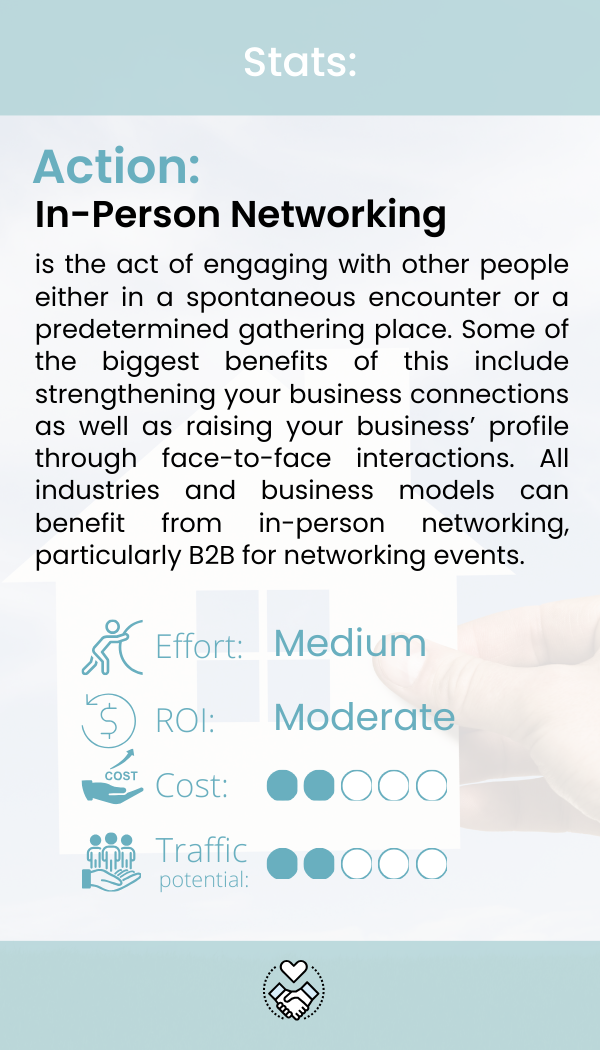
In-person networking is engaging with other people in a spontaneous encounter or a predetermined gathering place. Some of the most significant benefits of this include strengthening your business connections and raising your business profile through face-to-face interactions. All industries and business models can benefit from in-person networking, particularly B2B, for networking events.
Ratings for In Person Networking Marketing Tactic:
Effort: Medium Effort – In-person networking involves moderate time and resources, including attending events, preparing materials, and following up with contacts.
Return on Investment: Moderate ROI – The benefits of in-person networking, like relationship building and potential partnerships, usually manifest in the medium term.
Cost: Low Cost – The financial investment is generally minimal, primarily covering event attendance fees and travel expenses.
Website Traffic/Lead Generation: Low Traffic – While effective for building connections and brand awareness, in-person networking isn’t a primary driver for website traffic or immediate lead generation.
Industries That Would Benefit Most
“In-person Networking” can benefit various industries, especially those that build strong professional relationships and trust with potential clients or partners. Here are the industries that would most benefit from this tactic:
- Real Estate: Agents can build a local network, leading to referrals and partnership opportunities.
- Healthcare Services: Professionals can connect with potential partners and stay informed about industry trends.
- Hospitality: Networking can open opportunities for collaborations and event hosting.
- Travel: Establishing connections with local businesses can enhance service offerings and create referral systems.
- B2B Services: Crucial for building long-term client relationships and understanding market needs.
- Education: Opportunities for partnerships with other educational entities and resource sharing.
- Finance/Insurance: Building trust and credibility through personal connections is vital in this sector.
- Restaurants: Chefs and owners can network with suppliers, event planners, and other restaurateurs.
- Event Planning and Management: Essential for sourcing clients, vendors, and venues.
- Legal Services: Personal networking helps in building a client base and professional reputation.
Cold Calling
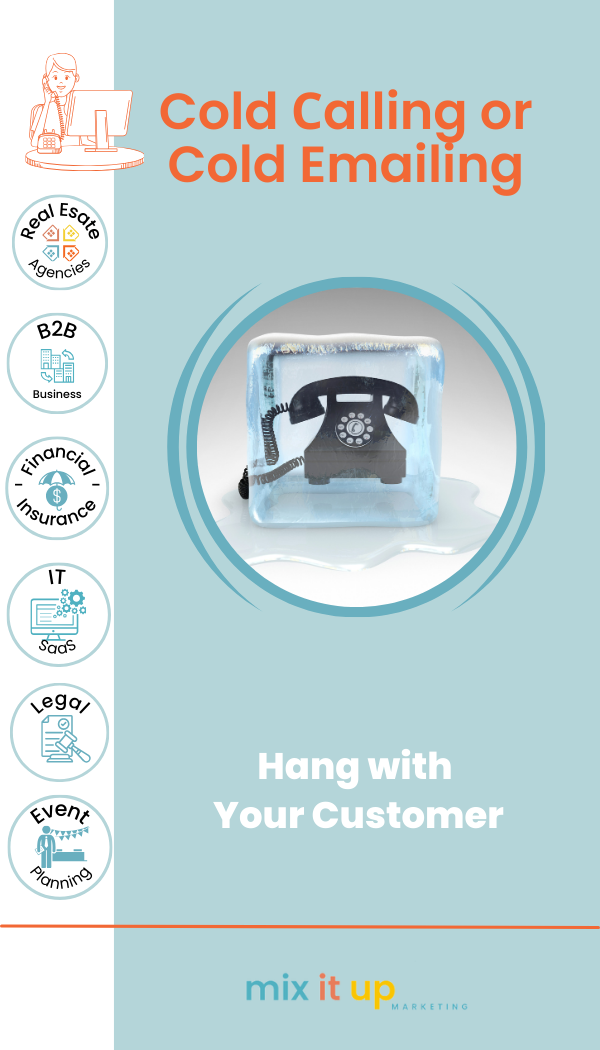
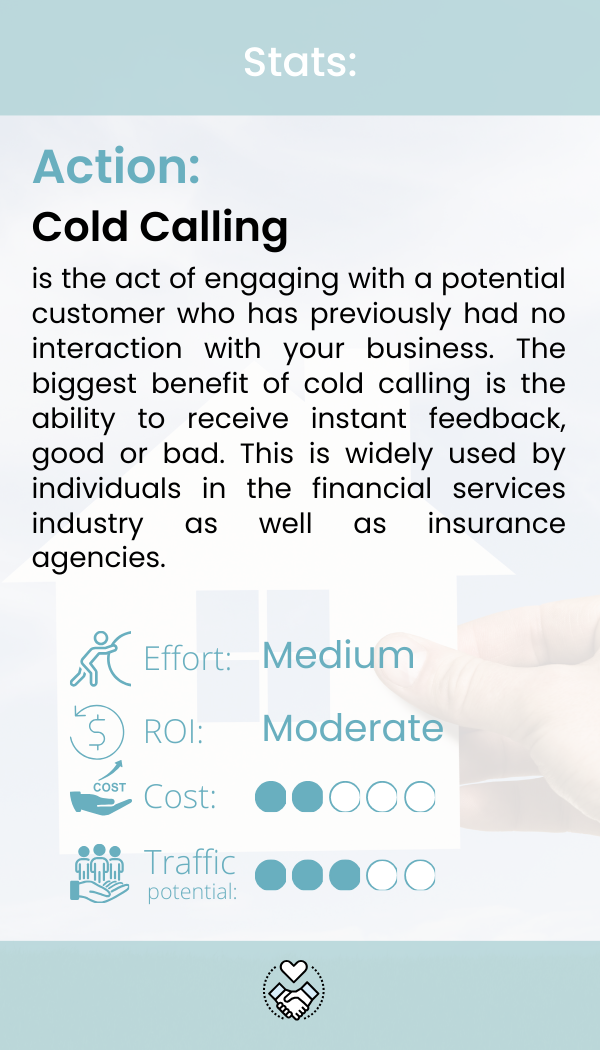
Cold calling engages with a potential customer who has not interacted with your business. The most significant benefit of cold calling is receiving instant feedback, good or bad. Individuals in the financial services industry and insurance agencies widely use this.
Ratings for Cold Calling or Emailing Marketing Tactic:
Effort: Medium Effort. Cold calling and emailing require moderate effort, including creating a contact list, script or email template, and dedicated time for calls or sending emails.
Return on Investment: Moderate ROI. These tactics can lead to medium-term results, as building relationships and trust through these methods may take time.
Cost: Low Cost. The financial investment for cold calling or emailing is minimal, primarily involving time and possibly some costs for email marketing tools or phone services.
Website Traffic and Lead Generation: Medium Traffic. While not directly driving high traffic, cold calling and emailing can effectively generate leads, eventually leading to increased website traffic.
Industries That Would Most Benefit
- Real Estate: Personalized emails or calls to potential clients can build trust and showcase properties effectively.
- Healthcare Services: Reaching out to potential patients or partners can increase awareness and appointment bookings.
- B2B (Business-to-Business): Direct outreach to other businesses can establish partnerships or sales opportunities.
- Financial/Insurance Services: Personalized communication can help in explaining complex services and gaining client trust.
- Technology and IT Services: Cold calling/emailing can effectively reach businesses needing tech solutions.
- Legal Services: Direct outreach can build relationships with potential clients needing legal assistance.
- Home Improvement and Renovation: Reaching homeowners directly can generate leads for services.
- Event Planning and Management: Building connections with potential clients or vendors through personal outreach.
- Education: Reaching out to potential students or partners for educational programs or services.
- Manufacturing: Establishing connections with suppliers, distributors, or potential clients through direct contact.
It’s essential to note that the effectiveness of cold calling can vary depending on factors like industry-specific regulations, target audience, and the quality of leads and scripts used. It may not be as well-received in industries where customers prefer other communication channels.
Guest Podcasting
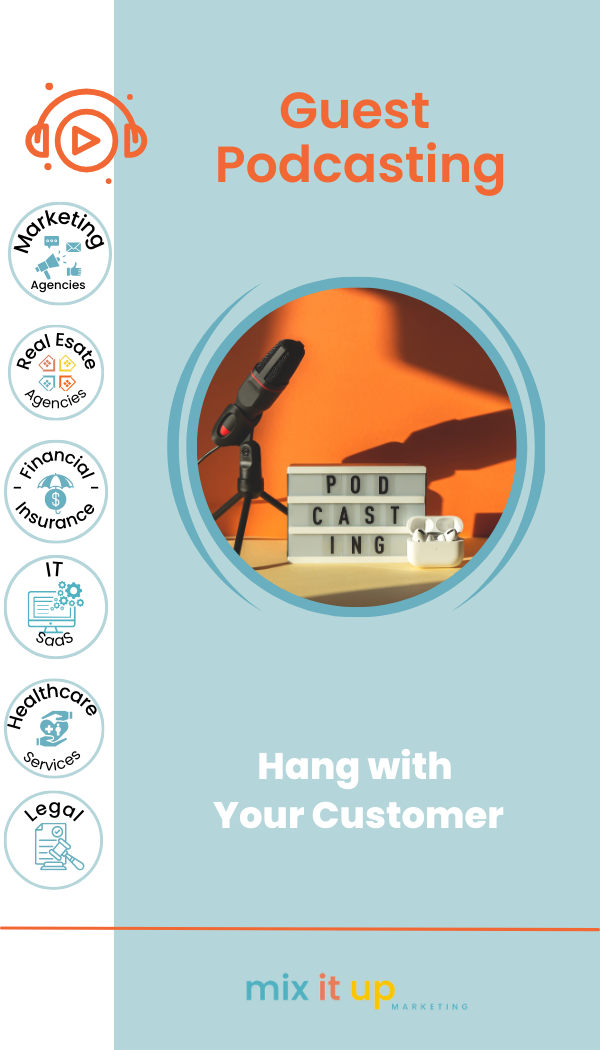
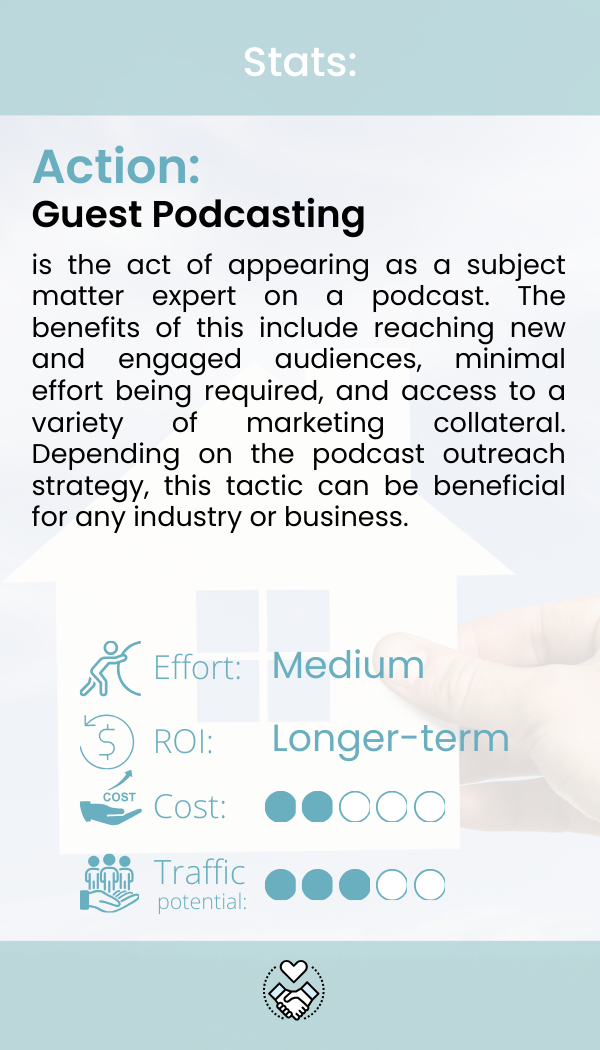
Guest podcasting is appearing as a subject matter expert on a podcast. The benefits of this include reaching new and engaged audiences, minimal effort being required, and access to various marketing collateral. Depending on the podcast outreach strategy, this tactic can benefit any industry or business.
Ratings for Guest Podcasting Marketing Tactic:
Effort: Medium Effort – Guest podcasting involves moderate effort, including finding relevant podcasts, preparing content, and participating in recordings.
Return on Investment: Longer-term ROI – The ROI from guest podcasting is generally seen over a longer period. It builds authority and brand recognition gradually.
Cost: Low Cost – Typically involves minimal financial investment, mainly time and resources for research and content preparation.
Website Traffic and Lead Generation: Medium Traffic –Guest podcasting can drive a moderate level of traffic and lead generation, primarily through audience engagement and brand exposure.
Industries That Would Benefit
- Real Estate: Real estate professionals can share market insights and investment tips, enhancing their credibility.
- Healthcare Services: Healthcare experts can discuss wellness trends and healthcare advancements, establishing thought leadership.
- Finance/Insurance: Financial advisors can offer advice on investment, insurance, and personal finance, building trust.
- Technology and IT Services: Tech professionals can discuss industry trends and innovations, showcasing expertise.
- Legal Services: Lawyers can discuss legal topics relevant to their specialization, enhancing their professional profile.
- Fitness and Wellness: Fitness experts can share health and wellness tips, appealing to a health-conscious audience.
- Education: Educators can discuss teaching methods, learning trends, and educational technology, reaching parents and educators.
- Marketing Agencies: Marketing professionals can share industry insights and marketing tips, attracting potential clients.
- Environmental Services: Experts can discuss sustainability and environmental issues, targeting environmentally conscious audiences.
- Entertainment and Event Services: Professionals can share behind-the-scenes insights into event planning and entertainment, attracting relevant clientele.
The key is to find podcasts that align with the industry’s expertise and target audience to effectively share knowledge, build authority, and reach potential customers or clients.
Guest Posting
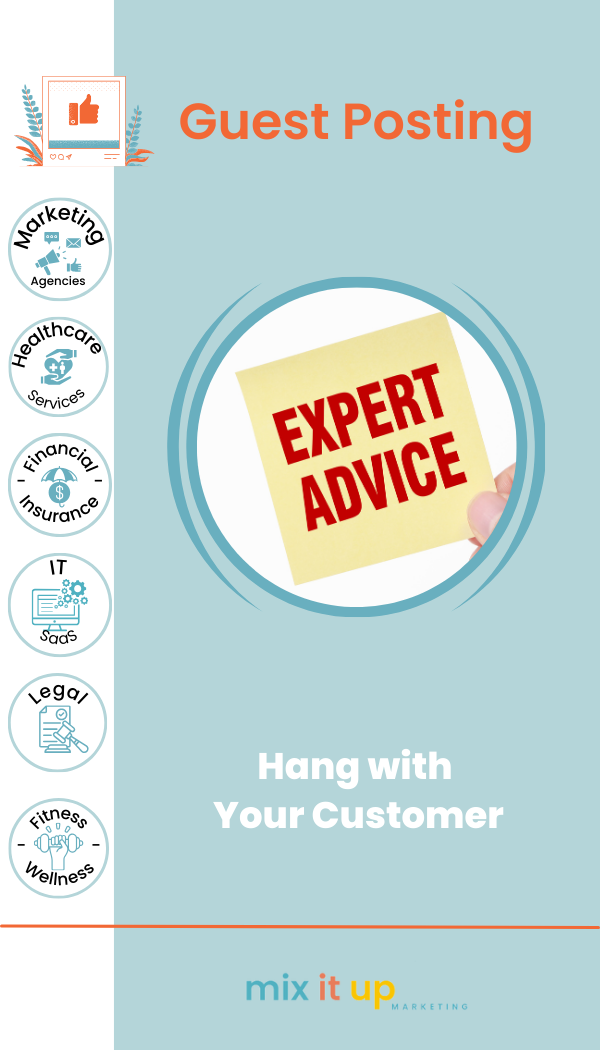
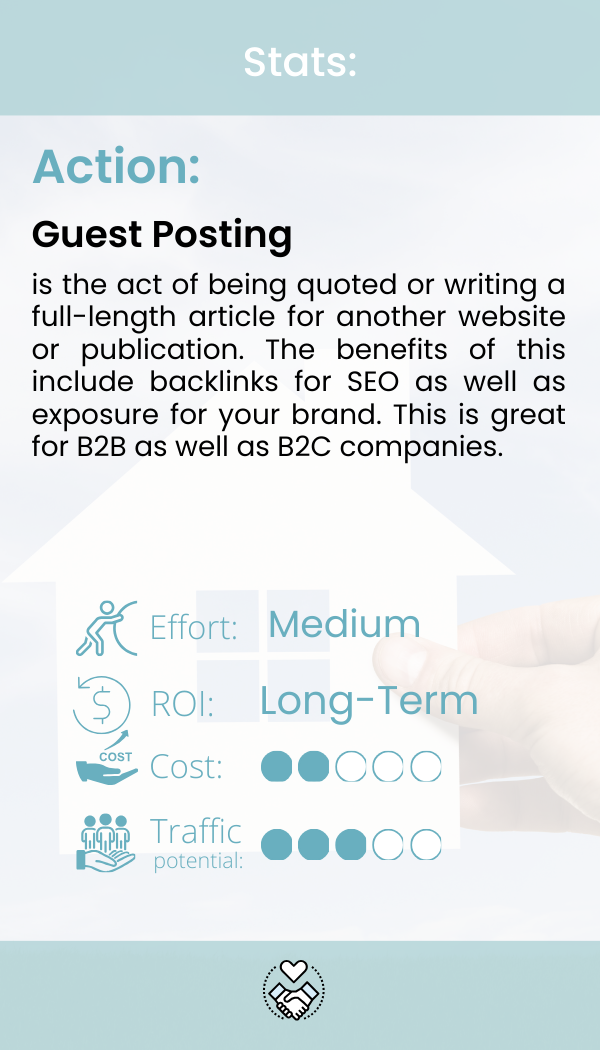
Guest posting is being quoted or writing a full-length article for another website or publication. The benefits of this include backlinks for SEO as well as exposure for your brand. This is great for B2B as well as B2C companies.
Ratings for Guest Posting Marketing Tactic:
Effort: Medium Effort – Guest posting involves researching suitable platforms, creating tailored content, and often engaging with the audience post-publication.
Return on Investment: Longer-term ROI – Guest posting builds brand authority and audience trust over time, contributing to a robust online presence.
Cost: Low Cost – Usually, the cost is minimal, primarily involving time and creative effort unless paid opportunities are pursued.
Website Traffic and Lead Generation: Medium Traffic – Guest posting can drive moderate traffic and lead generation, especially if posts are on well-trafficked sites with engaged audiences.
Industries That Would Benefit
Guest Posting can be a valuable marketing tactic for industries and businesses that aim to establish authority, build backlinks, and expand their online presence through content marketing. Here are the industries that would most benefit from guest posting:
- Marketing Agencies: Showcase expertise on industry blogs; enhance credibility.
- Healthcare Services: Share expert health tips or patient stories on wellness sites; build trust.
- Education: Contribute educational methods or success stories on academic platforms; increase outreach.
- Finance/Insurance: Write about financial planning or insurance advice on finance blogs; establish authority.
- Technology and IT Services: Share tech insights or case studies on tech blogs; demonstrate innovation.
- Legal Services: Offer legal tips or case analysis on legal forums; grow professional reputation.
- Fitness and Wellness: Write about fitness trends or wellness tips on health blogs; connect with health-conscious audiences.
- Environmental Services: Share sustainability practices or environmental studies on eco-friendly platforms; raise awareness.
- Health and Beauty: Contribute beauty tips or health product reviews on lifestyle websites; enhance brand visibility.
- Childcare and Early Education: Write about child development or parenting tips on family-oriented blogs; engage with parents.
Tailoring the guest post content to each industry’s specific needs and interests is essential.
Guest Speaker
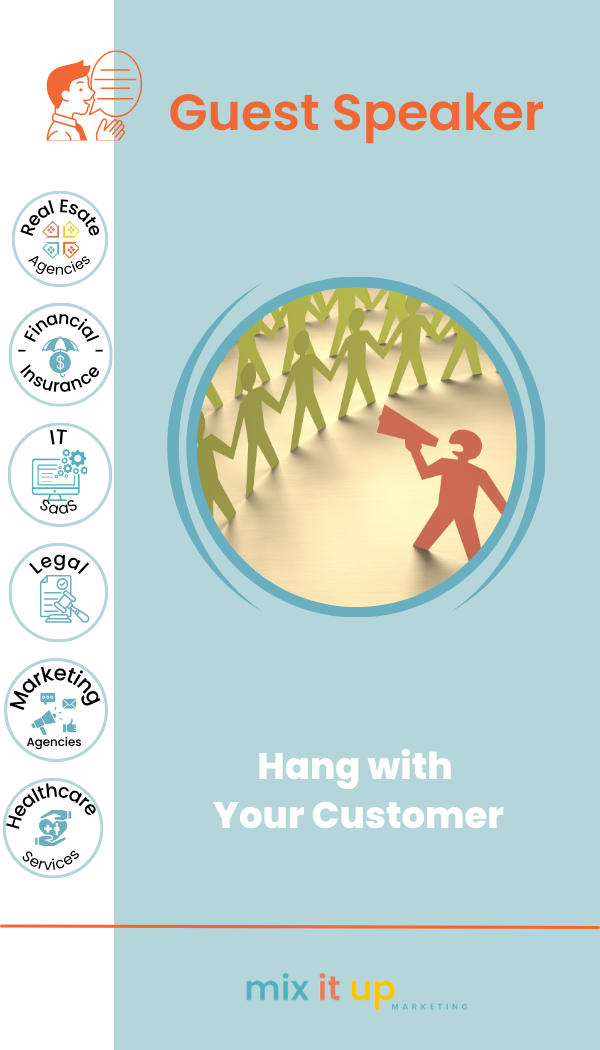
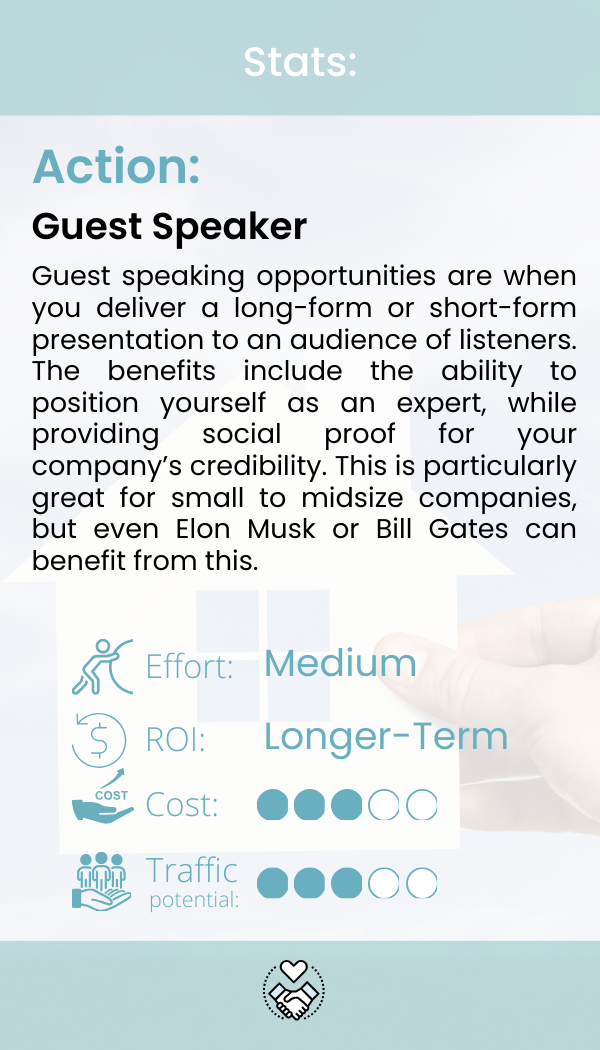
Guest speaking opportunities are when you deliver a long-form or short-form presentation to an audience of listeners. The benefits include positioning yourself as an expert while providing social proof for your company’s credibility. This is particularly great for small to midsize companies, but even Elon Musk or Bill Gates can benefit.
Ratings for Guest Speaker Marketing Tactic:
Effort: Medium Effort – Guest speaking involves preparation of content, understanding the audience, and potentially traveling to the venue, making it a moderately demanding task in terms of effort.
Return on Investment: Longer-term ROI – As a brand-building and networking strategy, guest speaking often provides longer-term benefits in terms of establishing authority and building professional relationships.
Cost: Low to Medium Cost – While there might be some travel or preparation costs involved, typically, the financial investment is not substantial unless it involves high-profile events or extensive travel.
Website Traffic and Lead Generation: Medium Traffic – Guest speaking can enhance a business’s visibility and credibility, leading to moderate increases in website traffic and lead generation, especially if the speaking engagement is well-publicized or includes a call to action.
Industries That Would Benefit
- Real Estate – Real estate agents can establish themselves as local market experts, providing insights at housing seminars or real estate conferences.
- Healthcare Services – Professionals can speak at health and wellness events or medical conferences to build credibility and network with potential clients.
- Education – Educational service providers can offer expert insights in educational seminars or school functions, enhancing their visibility.
- Finance/Insurance – Financial advisors can speak at investment seminars or community events to establish trust and expertise.
- Technology and IT Services – Tech companies can offer insights at tech expos or webinars, highlighting their expertise and innovations.
- Event Planning and Management – Speaking at industry conferences or bridal expos can showcase expertise and attract new clients.
- Legal Services – Lawyers can enhance their reputation and attract clients by speaking at legal seminars or public forums on relevant topics.
- Fitness and Wellness – Fitness experts can build their personal brand by speaking at health and wellness events or fitness expos.
- B2B Services – Speaking at industry-specific conferences or trade shows can help in networking and establishing authority in the field.
- Marketing Agencies – Sharing insights at marketing seminars or business events can showcase expertise and attract potential clients.
This tactic’s effectiveness depends on the speaker’s expertise and the relevance of their message to the target audience within each industry.
Text message
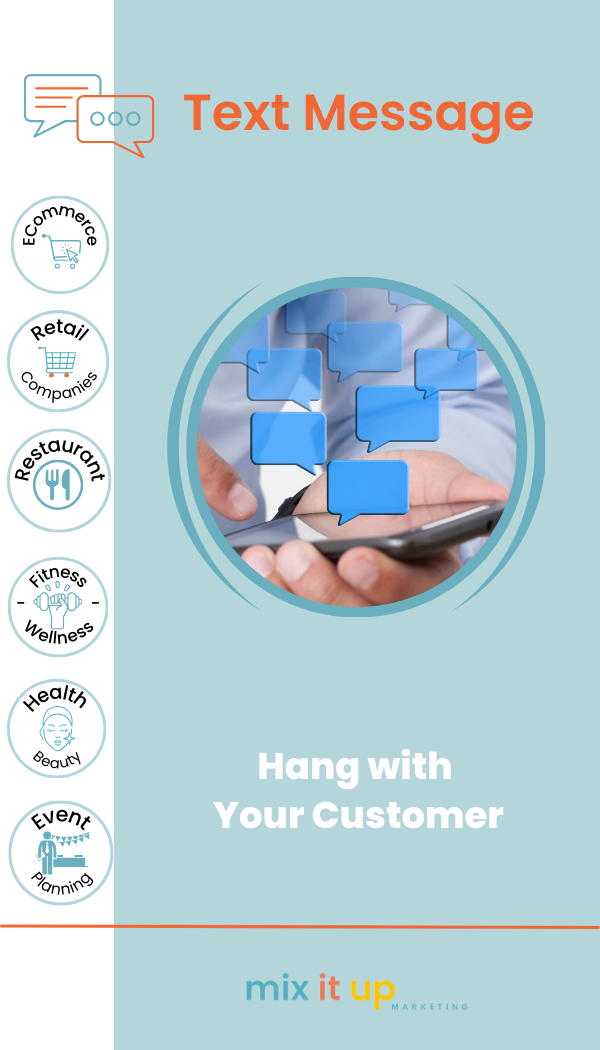
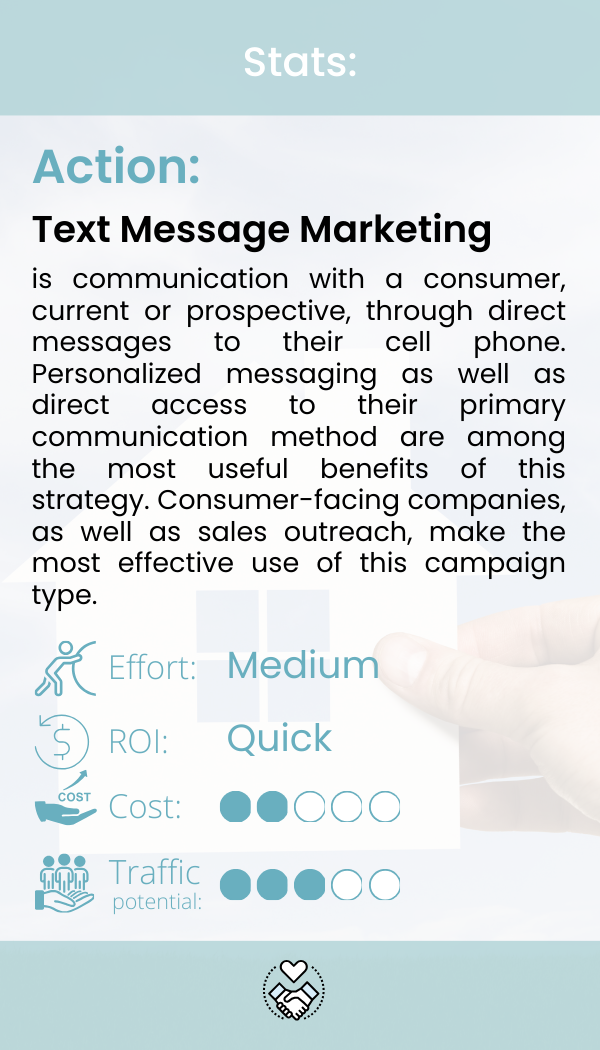
Text message marketing is communication with a consumer, current or prospective, through direct messages to their cell phone. Personalized messaging and direct access to their primary communication method are among the most valuable benefits of this strategy. Consumer-facing companies, as well as sales outreach, make the most effective use of this campaign type.
Ratings for Text Messaging Marketing Tactic:
Effort: Medium Effort – Setting up and maintaining a text messaging campaign requires a moderate level of effort, including segmenting audiences, crafting messages, and managing responses.
Return on Investment: Quick ROI – Text messaging often leads to immediate customer engagement and can produce quick responses, making it suitable for short-term tactics.
Cost: Low Cost – Generally, text messaging involves a minimal financial investment compared to other digital marketing strategies. Monthly costs can range from $100 to $500, depending on the scale and tools used.
Traffic Potential: Medium Traffic – Text messaging can effectively drive moderate website traffic and lead generation, particularly when messages include links or calls to action.
Industries That Would Benefit
- Restaurants: Offer exclusive deals or alert customers about daily specials. Useful for promoting last-minute reservations or takeout options.
- Fitness and Wellness: Send workout tips, class schedules, or motivational messages. Helps in retaining customer engagement and promoting new programs.
- Retail Companies: Update customers on new arrivals, sales, or exclusive offers. Enhances customer retention and increases in-store visits or online purchases.
- E-commerce: Notify customers about order statuses, shipping updates, and flash sales. Direct and immediate communication can boost repeat purchases.
- Health and Beauty: Appointment reminders and special offers on services/products. Improves customer experience and reduces no-shows.
- Event Planning and Management: Updates about event details, reminders, or special announcements. Keeps attendees informed and engaged.
- Legal Services: Appointment reminders and follow-ups. Maintains a professional and organized client relationship.
- Personal Services: Confirm bookings and send personalized offers or reminders. Enhances client satisfaction and loyalty.
- Technology and IT Services: Alert customers about service updates, maintenance schedules, or new product launches. Efficient for B2B and B2C communication.
- Real Estate: Property updates, open house reminders, or market news. Keeps potential buyers or renters informed and engaged.
Keep in mind that the effectiveness of text message marketing can also depend on compliance with relevant regulations, such as obtaining consent from recipients and providing opt-out options.
Content Marketing

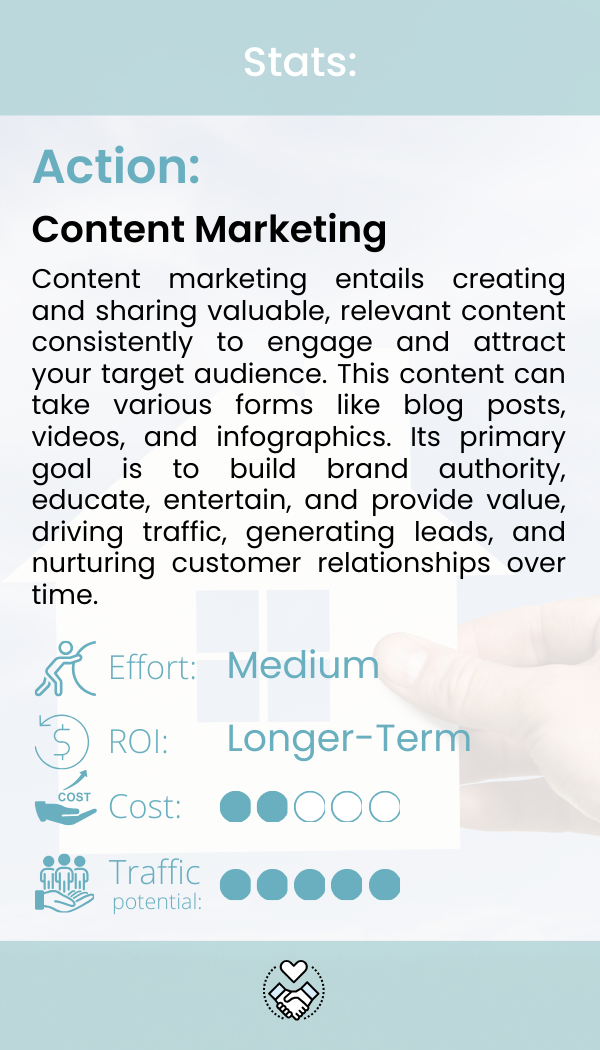
Content marketing involves creating and distributing valuable, relevant, consistent content to attract and engage a target audience. This content can take various forms, including blog posts, articles, videos, infographics, podcasts, etc. The primary goal is to build brand authority, educate, entertain, and provide value to the audience, ultimately driving traffic, generating leads, and nurturing customer relationships over time.
Ratings for Content Marketing Tactic:
Effort Level: Medium – Content marketing involves creating valuable and relevant content consistently, which requires planning, research, content creation, and distribution. While it may not be as resource-intensive as some high-effort tactics, it still demands a sustained effort to produce quality content that engages the target audience.
ROI: Longer-term ROI (Requires patience and consistency) – Content marketing often takes time to build authority, visibility, and a loyal audience. While it can yield long-term benefits and significant ROI, the results accumulate gradually. Consistency in producing high-quality content is critical to achieving substantial returns.
Cost: Low to Medium – The cost of content marketing can vary widely based on factors such as content quality, publishing frequency, and whether you outsource content creation. It ranges from low (if you produce content in-house) to medium (if you hire content creators or agencies).
Traffic and Lead Generation: High – Content marketing is a highly effective strategy for driving organic website traffic and generating leads. Quality content that provides value to your audience can attract and engage potential customers, guiding them through the sales funnel. It can lead to high traffic and substantial lead generation, especially with SEO and promotion strategies.
Industries that would benefit
Marketing Agencies: Marketing agencies can use content marketing to showcase their expertise and attract potential clients through informative blog posts, case studies, and eBooks.
B2B (Business-to-Business): B2B companies can create valuable content like whitepapers and webinars to educate other businesses about their products or services.
B2C (Business-to-Consumer): Retailers and consumer goods companies can engage customers with product guides, how-to videos, and lifestyle blog content.
Healthcare Services: Healthcare providers can use content marketing to share health tips, medical news, and success stories to build trust and educate patients.
Finance/Insurance: Financial institutions and insurance companies can publish informative articles, infographics, and videos to demystify complex financial topics for their clients.
Real Estate: Real estate professionals can use content marketing to showcase property listings, neighborhood guides, and market trends to attract homebuyers and sellers.
Education: Educational institutions can leverage content marketing to promote courses, share academic insights, and engage students with informative content.
Hospitality: Hotels and travel companies can create travel guides, destination highlights, and customer testimonials to inspire and inform potential guests.
Home Services: Home service providers like plumbers and electricians can use content marketing to offer homeowners DIY tips, safety guides, and service explanations.
Restaurants: Restaurants can showcase their menu items, share recipes, and engage diners with mouthwatering photos and culinary insights.
Make It Easier to be Found
Blogging
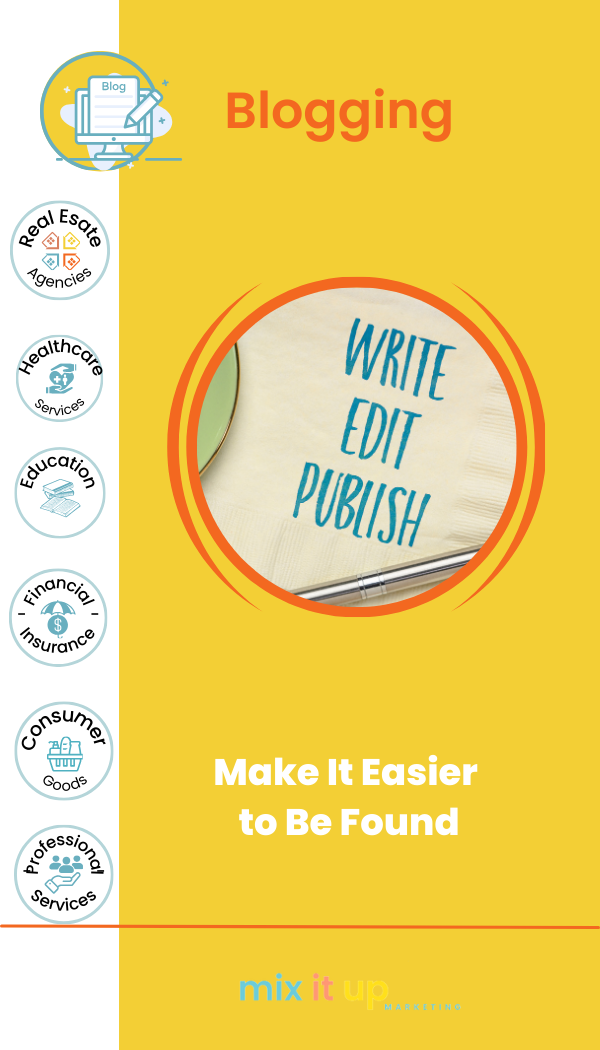
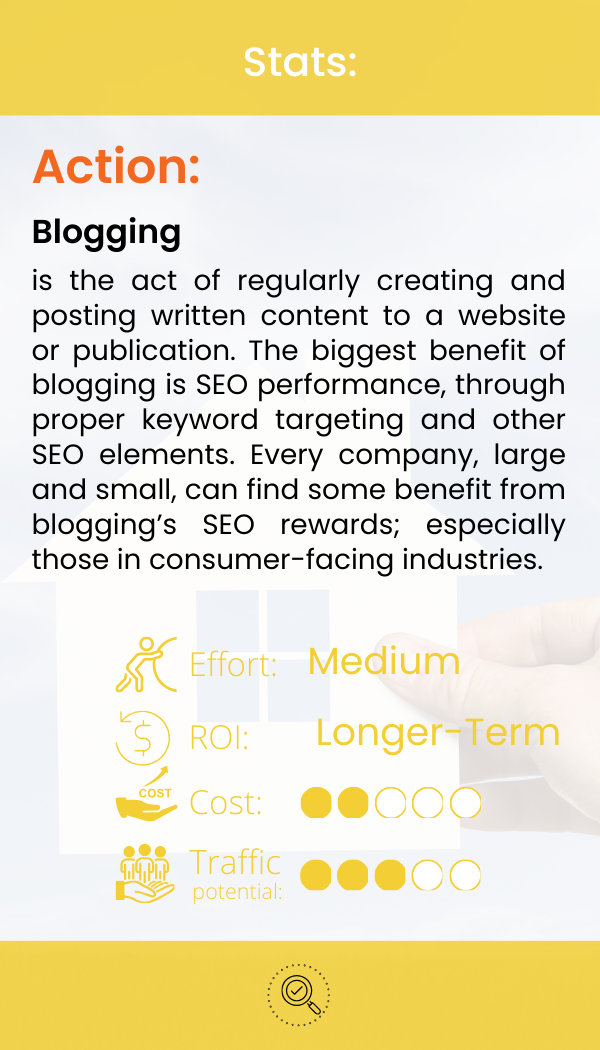
Blogging is regularly creating and posting written content to a website or publication. The most significant benefit of blogging is SEO performance through proper keyword targeting and other SEO elements. Every company, large and small, can find some benefit from blogging’s SEO rewards, especially those in consumer-facing industries.
Ratings for Blogging Marketing Tactic:
Effort: Medium Effort – Blogging requires a moderate level of time, work, and resources, including planning, content creation, and ongoing management.
Return on Investment: Longer-term ROI – Blogging is a long-term strategy that takes months to yield substantial results but focuses on building a robust online presence and trust with audiences.
Cost: Low Cost – Blogging generally requires minimal financial investment, mainly involving time and effort for content creation.
Traffic Potential: Medium Traffic – Blogging can provide a moderate level of website traffic and lead generation, contributing steadily to online presence over time.
Industries That Would Benefit
Healthcare Services: Sharing health tips, industry news, and wellness advice to engage patients and establish expertise.
Education: Blogging about educational trends, learning tips, and student success stories to attract students and parents.
Real Estate: Offering market insights, home buying tips, and neighborhood highlights to engage potential buyers and sellers.
Legal Services: Discussing legal changes, providing advice, and highlighting case studies to build credibility and attract clients.
Technology and IT Services: Sharing tech trends, product reviews, and how-to guides to engage tech-savvy customers.
Personal Services: Providing lifestyle tips, customer stories, and service explanations to connect with and grow their customer base.
Fitness and Wellness: Offering workout tips, nutrition advice, and wellness trends to engage and motivate clients.
Craft Food Products: Sharing recipes, product origins, and food industry insights to create a community of food enthusiasts.
Environmental Services: Blogging about sustainability practices, environmental news, and green living tips to engage eco-conscious audiences.
Art and Creative Services: Showcasing portfolio pieces, industry insights, and creative processes to attract clients and collaborators.
Google Business Profile (formally Google My Business)
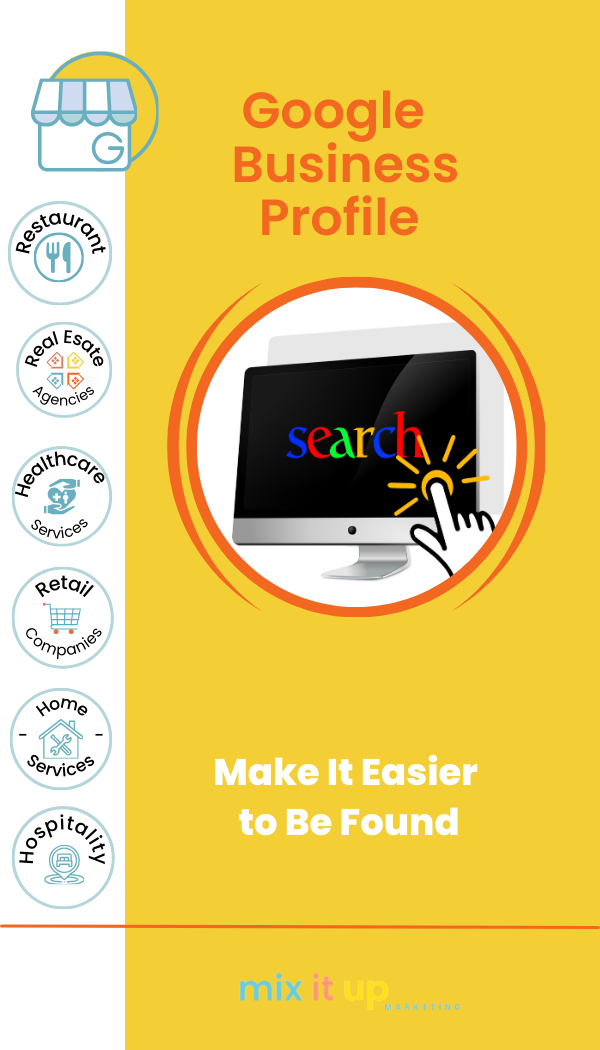

Google Business Profile is an internal software where businesses can claim ownership of their business profile. The benefits of this include the ability to provide details and photos of your business, such as your location, services, and products. Local businesses can use this to their advantage to compete with the large companies. Everyone should have a Google Business Profile account in today’s modern age.
Ratings for Google Business Profile Marketing Tactic:
Effort: Medium Effort – Setting up and optimizing a Google Business Profile requires some initial effort, including accurate information input, regular updates, and responding to reviews.
Return on Investment: Longer-term ROI – Offers significant ROI over time by enhancing local SEO, improving visibility, and establishing credibility.
Cost: Lowest Cost – It’s free to set up a Google Business Profile, with costs primarily in terms of time and effort for maintenance.
Website Traffic/Lead Generation: High Traffic – Highly effective in driving local search traffic, especially for businesses reliant on local customers.
Industries That Would Benefit
The “Google Business Profile” tactic, which involves creating and optimizing a business’s listing on Google Business Profile, can benefit many industries. It’s particularly effective for companies that rely on local visibility and attracting nearby customers.
- Real Estate: Enhances local visibility for realtors and listings.
- Healthcare Services: Patients often search for local healthcare providers.
- Hospitality: Crucial for hotels and B&Bs to appear in local searches.
- Restaurants: Helps attract local diners and tourists.
- Home Improvement and Renovation: Ideal for showcasing services and past projects.
- Retail Companies: Essential for local customers to find store locations.
- Fitness and Wellness: Great for local gyms and wellness centers to be discovered.
- Legal Services: Helps local clients find legal assistance nearby.
- Pet Services: Useful for pet owners seeking local services.
- Childcare and Early Education: Assists parents in finding local childcare options.
Remember that while Google Business Profile is valuable for many industries, its effectiveness also depends on the completeness and accuracy of the information provided and how well it is optimized for local search.
Refresh Content
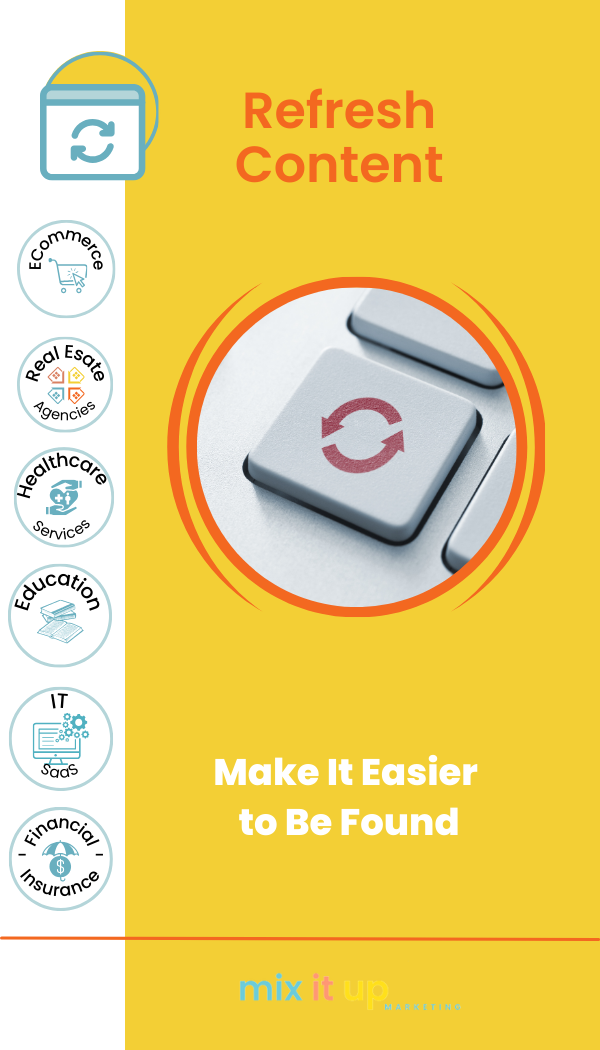
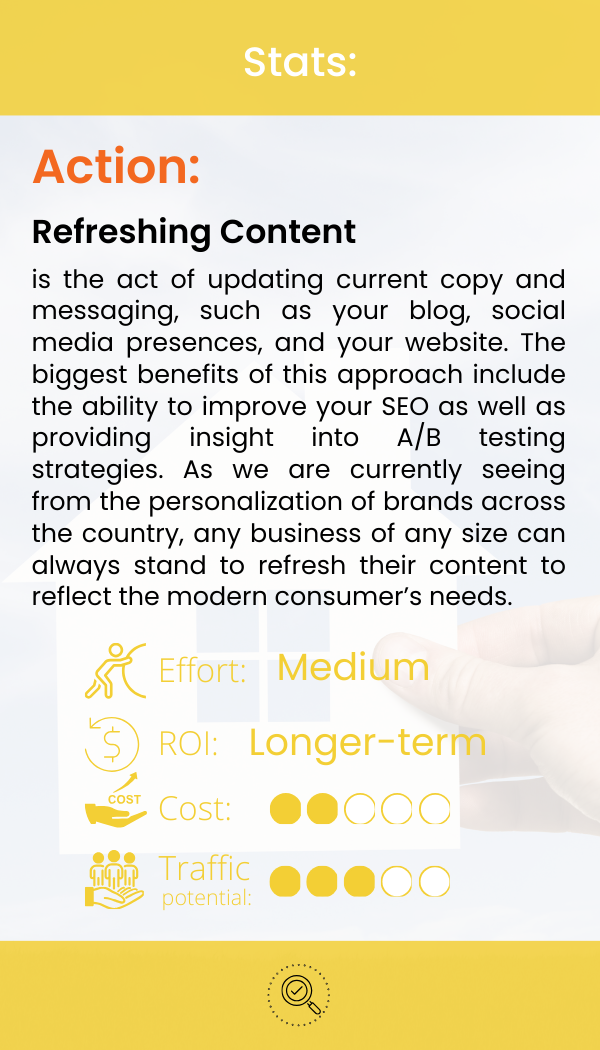
Refreshing content is updating current copy and messaging, such as your blog, social media presence, and website. The most significant benefits of this approach include the ability to improve your SEO as well as providing insight into A/B testing strategies. As we are currently seeing from the personalization of brands across the country, any business of any size can always stand to refresh its content to reflect the modern consumer’s needs.
Ratings for Refresh Content Marketing Tactic:
Effort: Medium Effort – Refreshing content requires a moderate amount of time and resources, including updating existing materials, ensuring relevance, and maintaining quality.
Return on Investment: Longer-term ROI – This tactic is about enhancing existing content to stay relevant and valuable over time, yielding results gradually as it improves SEO and user engagement.
Cost: Low Cost – It generally involves a minimal financial investment as it’s more about updating and optimizing what already exists rather than creating new content from scratch.
Website Traffic/Lead Generation: Medium Traffic – Refreshed content can drive a steady increase in website traffic and lead generation by improving SEO and user experience.
Industries That Would Benefit
- Real Estate: Updating property listings and market insights to keep potential buyers engaged.
- Healthcare Services: Keeping health information, blog posts, and service descriptions current and accurate.
- Education: Regularly updating course materials and educational content to reflect the latest trends and data.
- Finance/Insurance: Refreshing financial advice, market trends, and policy details to maintain trust and authority.
- Restaurants: Updating menus, specials, and customer reviews to attract new and repeat patrons.
- E-commerce: Keeping product descriptions, customer testimonials, and FAQ sections fresh and relevant.
- Fitness and Wellness: Updating workout guides, health tips, and success stories to keep content engaging.
- Technology and IT Services: Keeping up with tech trends and updating service offerings and case studies.
- Event Planning and Management: Regularly updating portfolios and service offerings to showcase the latest events.
- Legal Services: Refreshing legal advice, blog posts, and service descriptions to reflect current laws and cases.
SEO
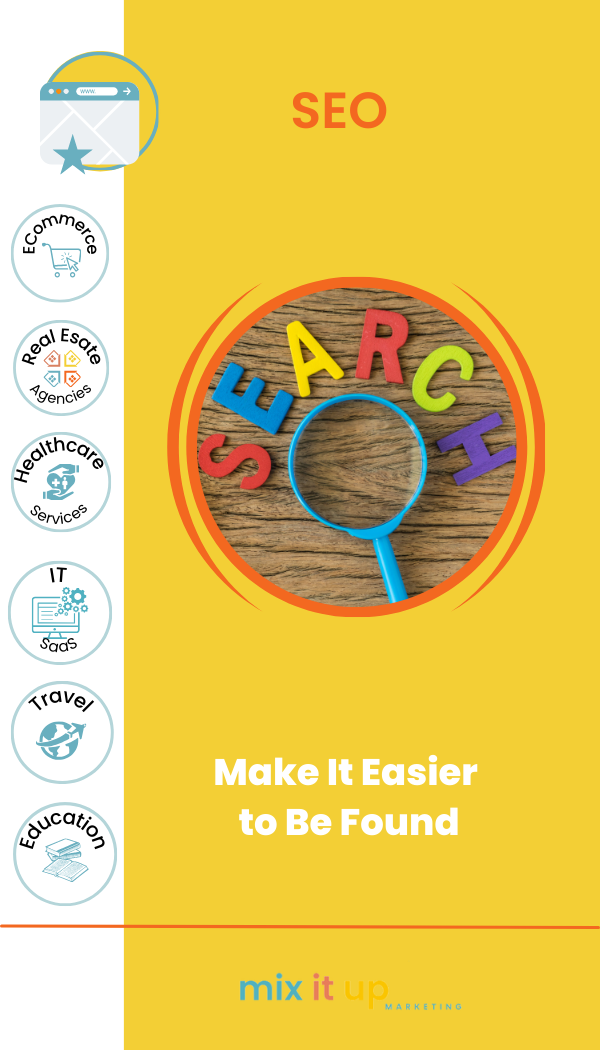
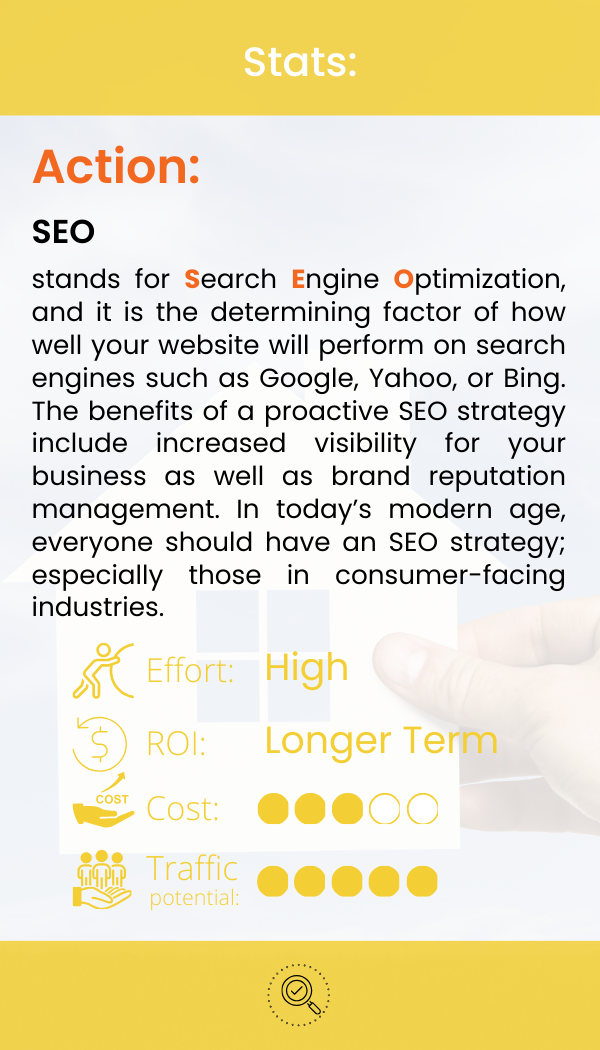
SEO stands for Search Engine Optimization, which determines how well your website will perform on search engines such as Google, Yahoo, or Bing. The benefits of a proactive SEO strategy include increased visibility for your business as well as brand reputation management. In today’s modern age, everyone should have an SEO strategy, especially those in consumer-facing industries.
Ratings for SEO Marketing Tactic:
Effort: High Effort – SEO demands significant time and resources for keyword research, content creation, website optimization, and continuous monitoring and updates.
Return on Investment: Longer-term ROI – SEO is a long-term strategy that builds online presence and trust with audiences, often taking months to yield significant results.
Cost: Medium Cost – While it can be initiated with minimal costs, effective SEO typically involves expenses for content creation, tools, and potentially expert consultation.
Website Traffic and Lead Generation: High Traffic – When done effectively, SEO drives a significant volume of targeted website traffic and leads due to higher visibility on search engines.
Industries That Would Benefit
- Real Estate: Attract potential buyers or renters through localized keyword optimization.
- Healthcare Services: Increase visibility for specific medical services or specialties.
- E-commerce: Drive traffic to product pages through targeted keywords.
- Fitness and Wellness: Rank for health and fitness-related queries to attract interested clients.
- Technology and IT Services: Optimize for tech-related keywords to reach a tech-savvy audience.
- Legal Services: Attract clients by ranking for legal advice and service-related terms.
- Travel: Optimize for destination-specific and travel service keywords.
- Education: Rank for educational content, courses, and institutional queries.
- Hospitality: Improve visibility for hotels, B&Bs, and other accommodations.
- Home Improvement and Renovation: Target homeowners looking for renovation ideas and services.
Website

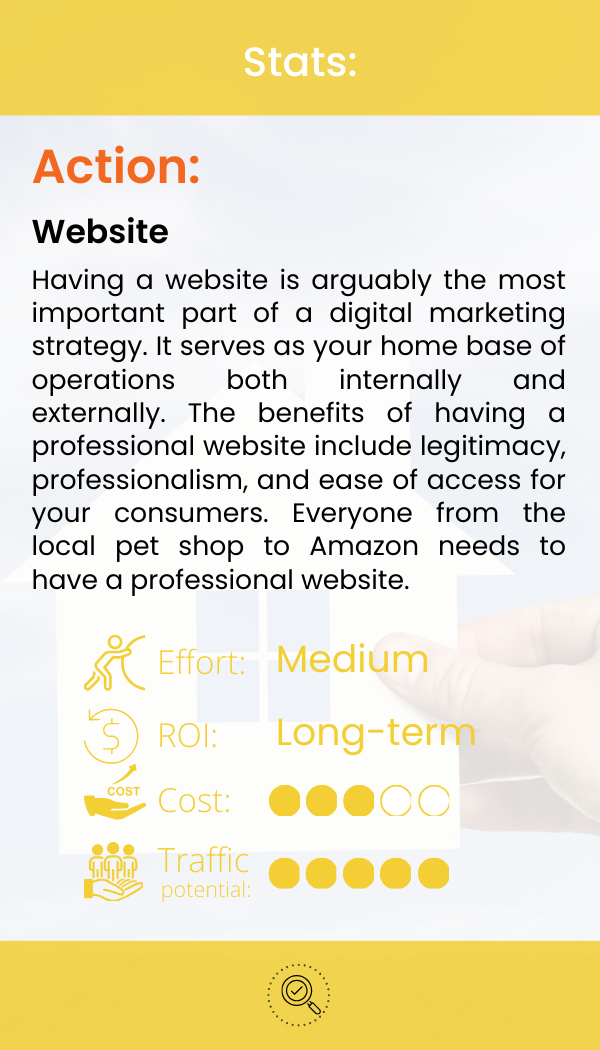
A website is arguably the most essential part of a digital marketing strategy. It serves as your home base of operations both internally and externally. The benefits of having a professional website include legitimacy, professionalism, and ease of access for your consumers. Everyone from the local pet shop to Amazon must have a professional website.
Ratings for Website Marketing Tactic:
Effort: Medium Effort – Setting up and maintaining a website involves a moderate level of effort, including design, content creation, and regular updates.
Return on Investment: Longer-term ROI – Websites are a long-term investment, gradually building a brand’s online presence and trust with audiences.
Cost: Medium Cost – Initial setup and ongoing maintenance, including hosting and possibly design services, typically fall in the $500 to $2,000 range.
Traffic Potential: High Traffic – A well-optimized website can significantly drive website traffic and lead generation, especially with SEO and content marketing.
Industries That Would Benefit
The marketing tactic of having a website can benefit virtually all industries listed. In today’s digital age, having a well-designed and informative website is essential for businesses across various sectors.
- Real Estate: Showcase property listings and provide valuable resources for buyers and sellers.
- Healthcare Services: Offer online appointment booking and detailed information about services and staff.
- E-commerce: Essential for online sales, product displays, and customer interaction.
- Fitness and Wellness: Share class schedules, health tips, and online booking for appointments or classes.
- Restaurants: Display menus, allow for online reservations and orders, and showcase the ambiance.
- Educational Institutions: Provide course information, enrollment options, and educational resources.
- Travel Agencies: Feature travel packages, customer reviews, and online booking options.
- Event Planning and Management: Portfolio of past events, services offered, and client testimonials.
- Legal Services: Detail services offered, lawyer bios, and case studies or testimonials.
- Technology and IT Services: Showcase tech solutions, client case studies, and service descriptions.
A website is a fundamental tool for establishing an online presence, regardless of the industry, as it helps businesses reach and engage with their target audiences, provide information, and facilitate transactions.
PPC Advertising
- FB ads
- Instagram ads
- Pinterest ads
- LinkedIn ads
- Google ads (including YouTube)
- Tik Tok
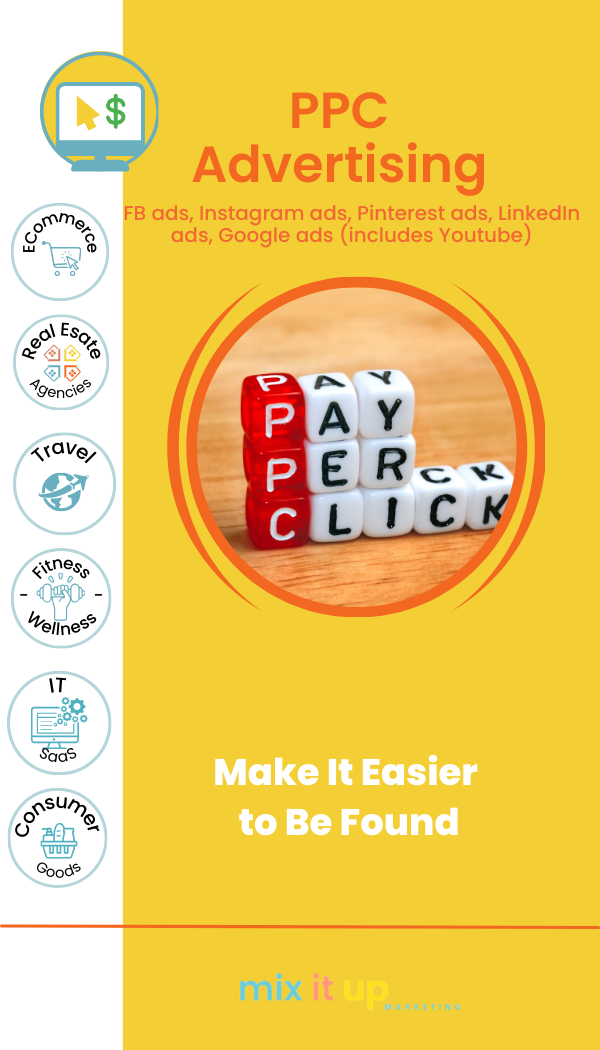
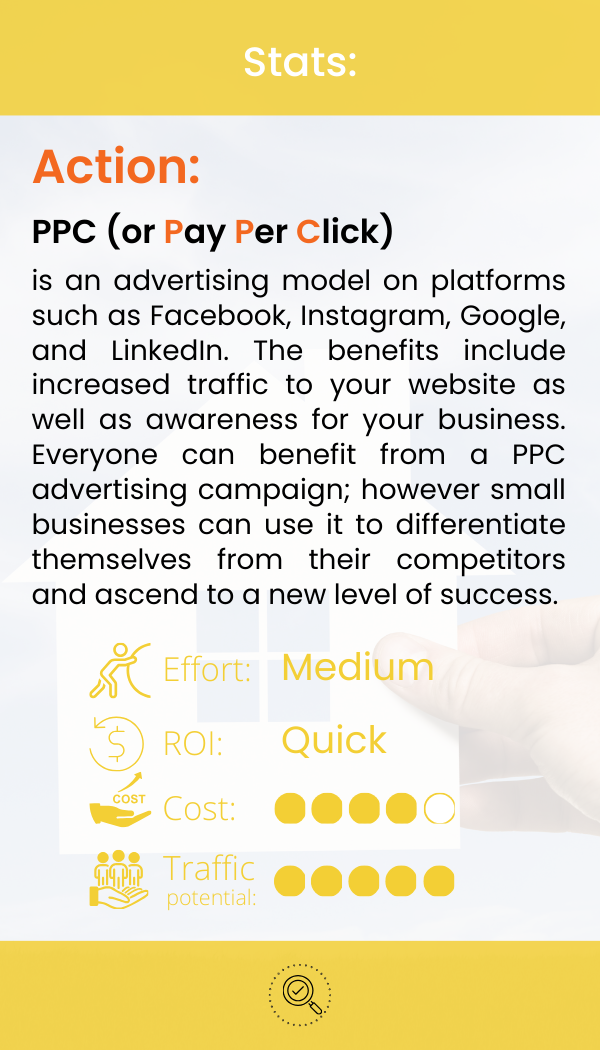
PPC (or Pay Per Click) is an advertising model on platforms like Facebook, Instagram, Google, and LinkedIn. The benefits include increased traffic to your website as well as awareness for your business. Everyone can benefit from a PPC advertising campaign; however, small businesses can use it to differentiate themselves from their competitors and ascend to a new level of success.
Ratings for PPC Ads Tactic:
Effort: Medium Effort – PPC campaigns require strategic planning, targeting, ad creation, continuous monitoring, and optimization.
Return on Investment: Quick ROI – PPC campaigns, particularly on platforms like Google and Facebook, can yield immediate results regarding lead generation and sales.
Cost: High Cost – While PPC allows for budget control to be competitive and reach a substantial audience, a significant investment is often necessary.
Website Traffic and Lead Generation: High Traffic – PPC advertising effectively drives substantial website traffic and generates leads.
Industries That Would Benefit
- Real Estate: Targeting local homebuyers or sellers with region-specific ads.
- Healthcare Services: Reaching patients looking for specialized healthcare solutions.
- Travel Agencies: Showcasing attractive travel deals to specific demographic groups.
- Education: Advertising online courses or educational materials to relevant audiences.
- Fitness and Wellness: Promoting gym memberships or wellness programs.
- E-commerce: Displaying product ads to users who have visited similar product pages.
- Technology and IT Services: Targeting businesses or individuals in need of tech solutions.
- Event Planning and Management: Advertising services to people searching for event-related keywords.
- Consumer Goods: Targeting ads based on consumer interests and shopping behavior.
- Legal Services: Reaching potential clients searching for legal advice or services.
By Platform
- PPC Advertising: Pay-Per-Click advertising can be beneficial for a wide range of industries, including:
- E-commerce
- B2B and B2C services
- Finance/Insurance
- Healthcare Services
- Technology and IT Services
- Consumer Goods
- Travel
- Hospitality
- Education
- Real Estate
- Retail Companies
- Legal and Financial Services
- Event Planning and Management
- Fitness and Wellness
- Entertainment and Event Services
2. Facebook Ads: Facebook advertising is versatile and can be effective for the following industries:
- E-commerce
- B2C (Business-to-Consumer)
- Consumer Goods
- Retail Companies
- Health and Beauty
- Fitness and Wellness
- Hospitality
- Travel
- Event Planning and Management
- Entertainment and Event Services
- Nonprofit and Social Services
3. Instagram Ads: Instagram’s visual nature makes it suitable for industries focused on visual appeal and aesthetics, including:
- Fashion and Apparel
- Beauty and Skincare
- Travel and Tourism
- Food and Beverage
- Art and Creative Services
- Entertainment and Event Services
4. Pinterest Ads: Pinterest is ideal for industries with visually appealing and lifestyle-oriented products or services, such as:
- Home Decor and Interior Design
- Fashion and Apparel
- Food and Beverage
- DIY and Craft Products
- Wedding and Event Planning
- Travel and Tourism
5. LinkedIn Ads: LinkedIn is a platform for professional networking, making it suitable for industries targeting businesses and professionals, such as:
- B2B (Business-to-Business)
- Technology and IT Services
- Legal and Financial Services
- Healthcare Services
- Education
- Event Planning and Management
- Marketing Agencies
- Consulting and Professional Services
6. Google Ads (including YouTube): Google Ads are highly versatile and can benefit a wide range of industries, including:
- E-commerce
- B2B and B2C services
- Finance/Insurance
- Healthcare Services
- Technology and IT Services
- Consumer Goods
- Travel
- Hospitality
- Education
- Real Estate
- Retail Companies
- Legal and Financial Services
- Event Planning and Management
- Fitness and Wellness
- Entertainment and Event Services
Radio Ads
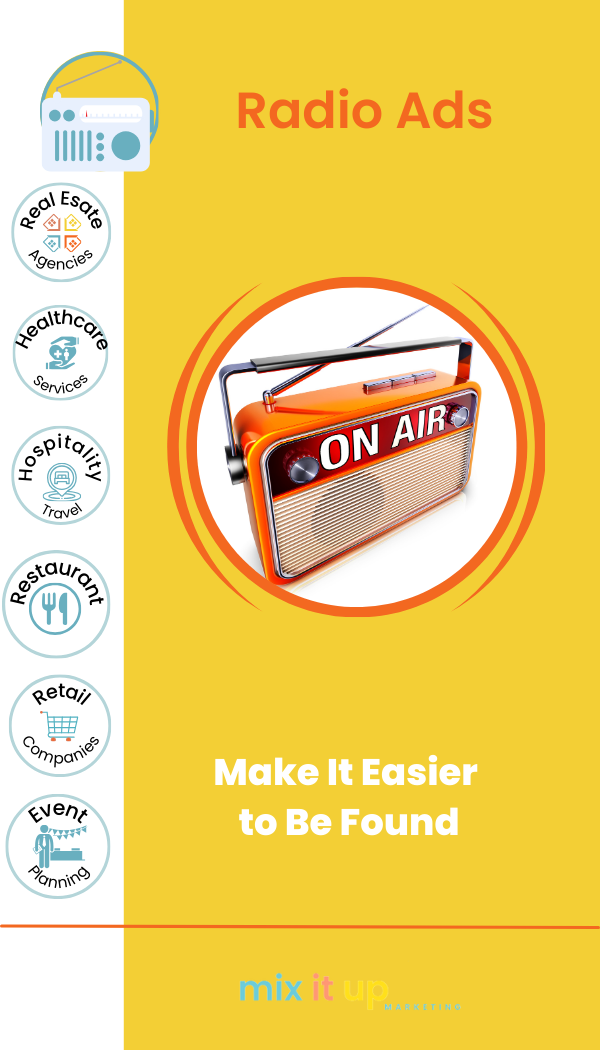
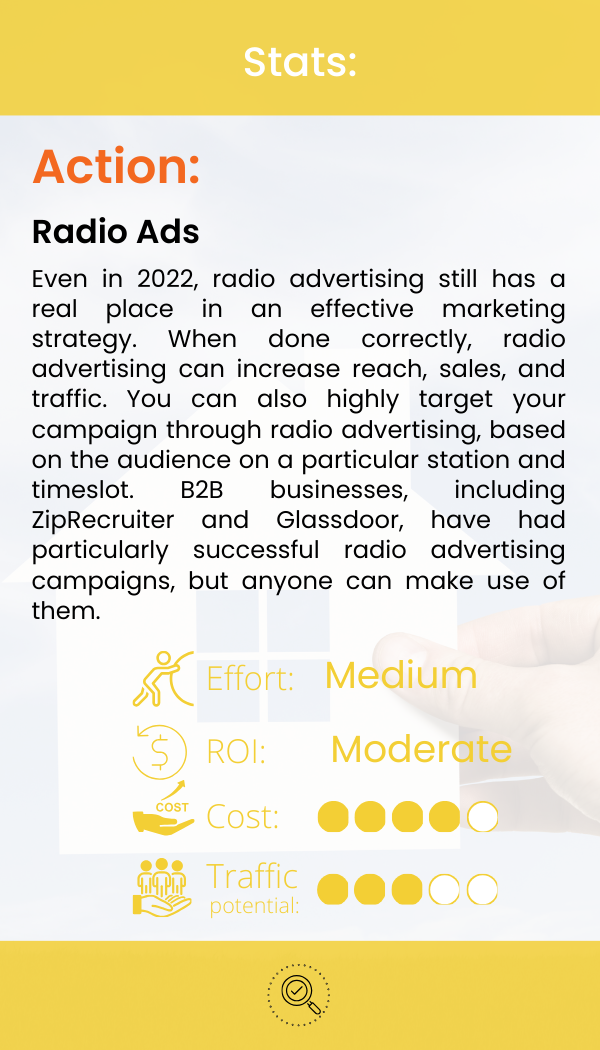
Even in 2023, radio advertising still has a real place in an effective marketing strategy. Radio advertising can increase reach, sales, and traffic when done correctly. You can also highly target your campaign through radio advertising based on the audience on a particular station and timeslot. B2B businesses, including ZipRecruiter and Glassdoor, have had particularly successful radio advertising campaigns, but anyone can use them.
Ratings for Radio Ads Tactic:
Effort: Medium Effort – Creating and running radio ads involves a moderate level of effort, including planning the campaign, producing the ad, and coordinating with radio stations.
Return on Investment: Moderate ROI – Radio ads can offer a good return over a few months, especially in local markets or specific demographic groups.
Cost: High Cost – Producing quality radio ads and buying airtime can be costly, often requiring a significant budget, especially on popular stations or prime time slots.
Website Traffic and Lead Generation: Medium Traffic – While not directly driving website traffic, radio ads can effectively increase brand awareness and indirectly lead to increased website visits and leads.
Industries That Would Benefit
- Real Estate: Local radio ads can target potential home buyers or sellers in specific areas, highlighting unique property listings or services.
- Healthcare Services: Ads can promote new medical facilities, specialized services, or health awareness campaigns in the local community.
- Hospitality: Hotels and resorts can use radio ads to announce special deals, events, or unique features to attract local tourists.
- Travel: Travel agencies can advertise exclusive vacation packages or last-minute deals.
- Restaurants: Local restaurants can use radio ads to promote new menu items, special discounts, or upcoming events.
- Retail Companies: Highlighting sales, new product arrivals, or unique store features can attract local shoppers.
- Fitness and Wellness: Gyms and wellness centers can advertise membership deals, new classes, or health events.
- Event Planning and Management: Promote services for weddings, corporate events, or special occasions.
- Health and Beauty: Spas, salons, and clinics can advertise new treatments, products, or opening hours.
- Entertainment and Event Services: Promotion of local concerts, shows, or entertainment services.
Businesses should consider their specific goals and target demographics when deciding whether radio ads are a suitable marketing tactic for their industry.
Writing for a Magazine or Newspaper
- Association journals, Costco, Medium, New York Times, Local newspaper,
- Substack or Patreon

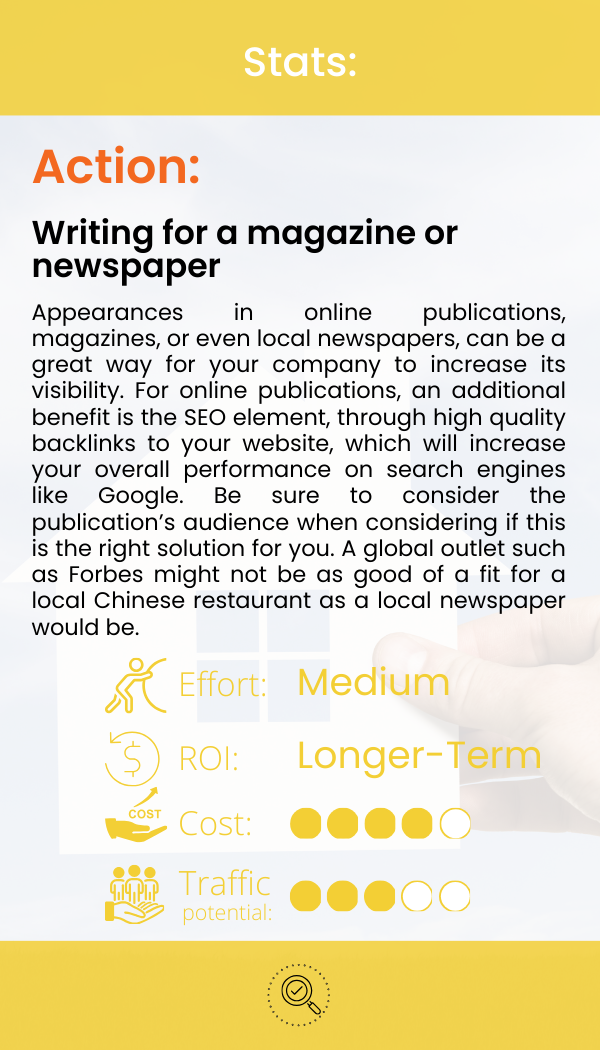
Appearances in online publications, magazines, or even local newspapers can be an excellent way for your company to increase its visibility. For online publications, an additional benefit is the SEO element, through high-quality backlinks to your website, which will improve your overall performance on search engines like Google. Be sure to consider the publication’s audience if this is the right solution for you. A global outlet such as Forbes might not be as good of a fit for a local Chinese restaurant as a local newspaper would be.
Ratings for Writing for a Newspaper or Magazine Marketing Tactic:
Effort: Medium Effort – It involves research, content creation, and liaising with publications, requiring a moderate level of time and resources.
Return on Investment: Longer-term ROI – Establishes authority and builds brand awareness over time, with results becoming more apparent in the long run.
Cost: Medium Cost – This may involve costs related to content creation, possibly hiring writers or researchers, and sometimes fees for publication in prominent magazines or newspapers.
Website Traffic and Lead Generation: Low Traffic – This tactic is more focused on brand building and credibility than driving high volumes of website traffic or immediate leads.
Industries That Would benefit
- Real Estate: Showcase market insights and property trends, positioning the business as a knowledgeable industry leader.
- Healthcare Services: Share advancements in healthcare, patient success stories, or health tips, enhancing credibility.
- Travel: Write about unique travel destinations or tips, attracting travel enthusiasts and positioning the company as a travel expert.
- Education: Share educational trends, success stories, or innovative teaching methods, appealing to students and parents.
- Finance/Insurance: Provide financial advice or insights into insurance products, building trust in the brand.
- Technology and IT Services: Write about tech trends, cybersecurity, or innovative IT solutions, showcasing expertise.
- Event Planning and Management: Share successful event stories or tips for memorable events, attracting potential clients.
- Legal Services: Offer legal insights or case studies, establishing authority in the field.
- Health and Beauty: Share wellness tips or beauty trends, engaging potential customers.
- Fitness and Wellness: Write about fitness trends, health tips, or success stories, attracting health-conscious readers.
Advertising billboards, buses, cars, etc.
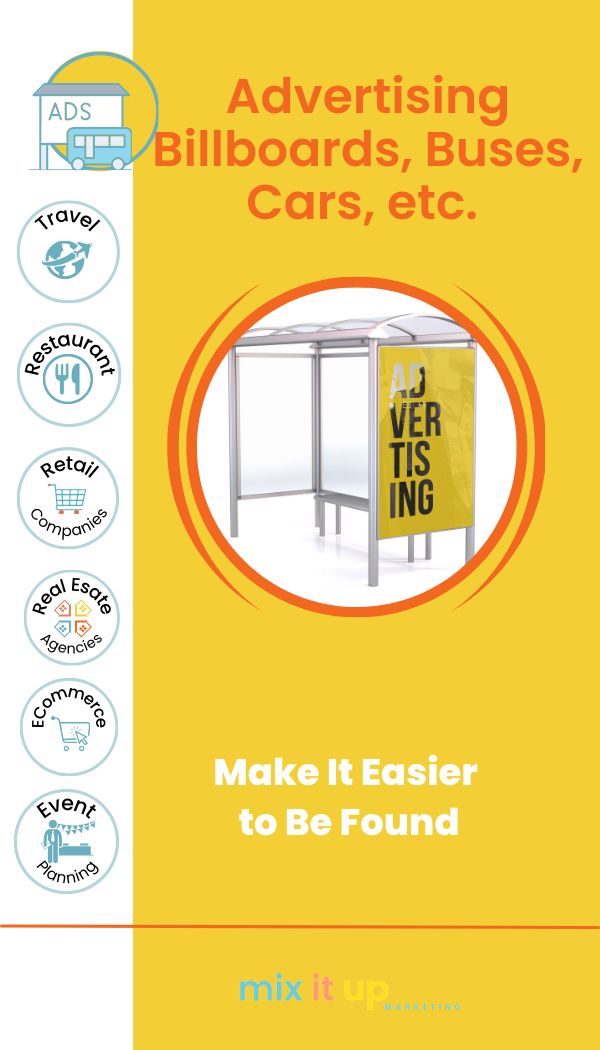
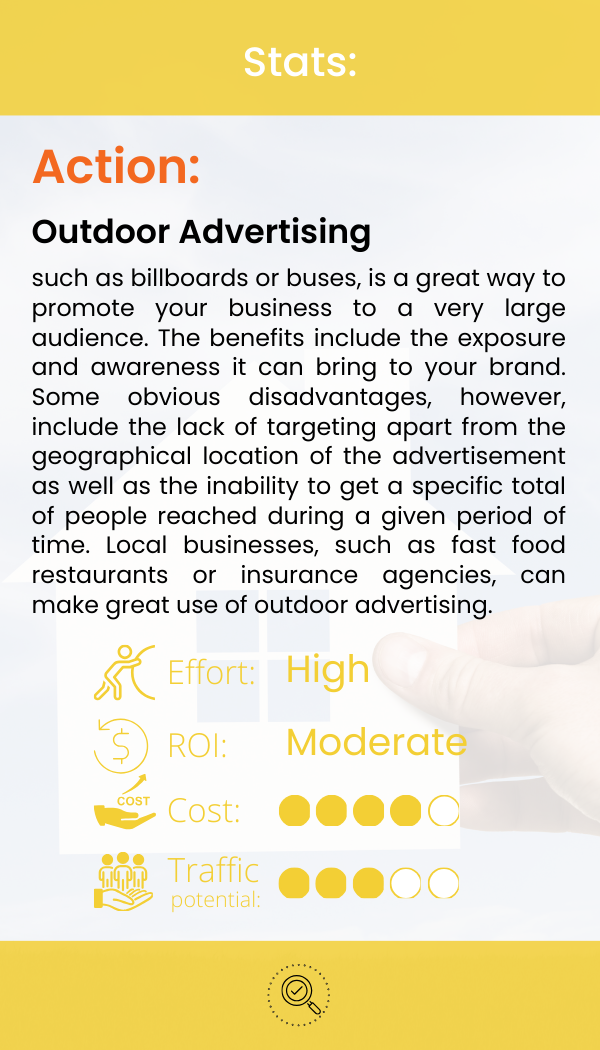
Outdoor advertising, such as billboards or buses, is a great way to promote your business to a vast audience. The benefits include the exposure and awareness it can bring to your brand. Some apparent disadvantages, however, are the lack of targeting apart from the geographical location of the advertisement as well as the inability to get a specific total of people reached during a given time. Local businesses, such as fast food restaurants or insurance agencies, can significantly use outdoor advertising.
Ratings for Outdoor Advertising Marketing Tactic:
Effort: Medium Effort – Designing and implementing these ads requires planning, design work, and coordination with advertising services.
Return on Investment: Moderate ROI – These ads can enhance brand visibility and recognition over a few months, especially in high-traffic areas.
Cost: High Cost – This form of advertising typically involves significant investment for space rental and production of the ads.
Website Traffic and Lead Generation: Medium Traffic – While not directly driving traffic to websites, they can effectively raise brand awareness and indirectly boost web traffic.
Industries That Would Benefit
- Real Estate: Eye-catching billboards in high-traffic areas to showcase premier properties or real estate services.
- Healthcare Services: Bus ads to promote local clinics, health awareness campaigns, or new services.
- Travel: Creative car wraps or bus ads showcasing exotic destinations or travel deals.
- Restaurants: Billboards with appetizing visuals to attract local and commuting customers.
- Retail Companies: Bus ads for shopping centers or special retail events, targeting local shoppers.
- E-commerce: Creative and bold car ads to promote online exclusive deals or popular products.
- Fitness and Wellness: Inspirational fitness ads on buses, encouraging viewers to join wellness programs.
- Technology and IT Services: Billboards near business districts promoting tech solutions or IT services.
- Event Planning and Management: Eye-catching vehicle ads showcasing event highlights or services.
- Legal Services: Professional and reassuring billboards or bus ads promoting legal expertise.
Advertising on billboards, buses, cars, and other out-of-home advertising methods can create brand awareness and reach a broad audience.
Remember that the effectiveness of this tactic may vary based on location and the specific advertising campaign’s objectives.
Signage- Sandwich Board & Banners
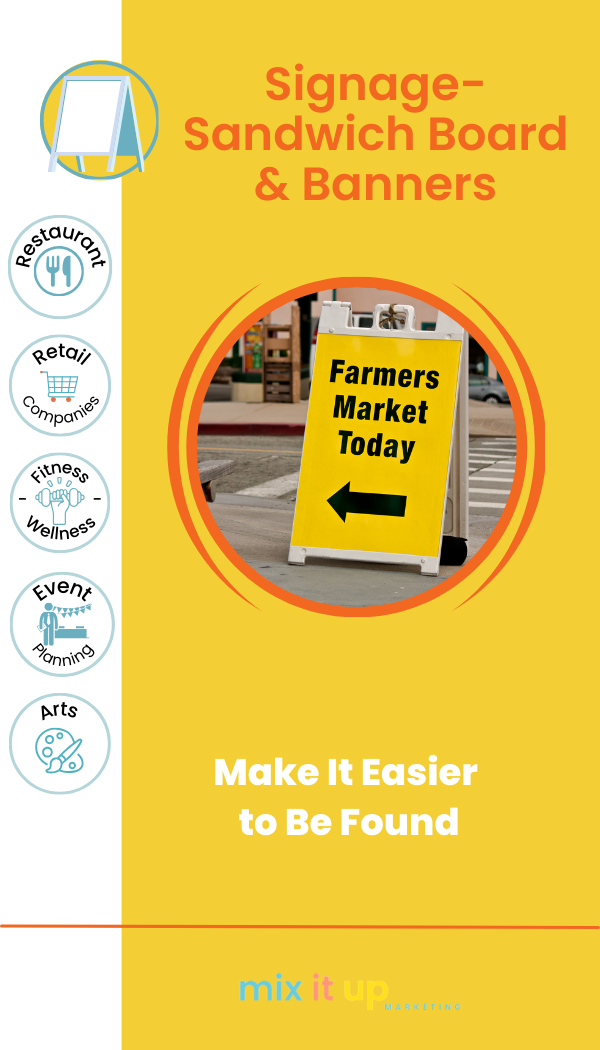
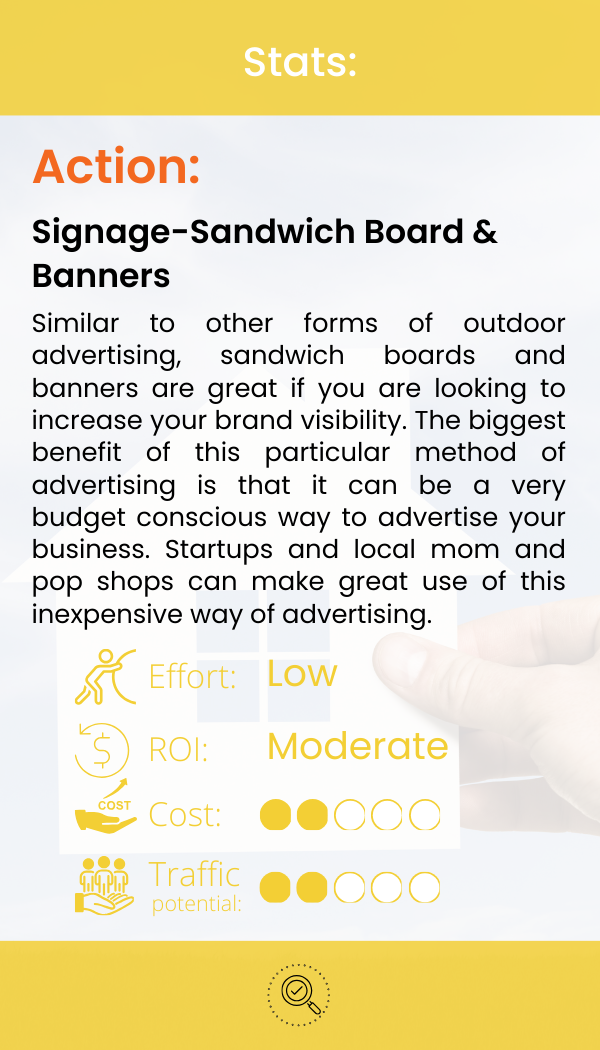
Like other forms of outdoor advertising, sandwich boards and banners are great if you want to increase your brand visibility. The most significant benefit of this particular advertising method is that it can be a very budget-conscious way to advertise your business. Startups and local mom-and-pop shops can make great use of this inexpensive way of advertising.
Ratings for Signage Sandwich Board & Banners Marketing Tactic:
Effort: Low Effort – Designing and setting up signage like sandwich boards and banners is relatively straightforward and doesn’t require extensive ongoing management.
Return on Investment: Moderate ROI – These forms of signage can effectively attract local traffic over time, especially in high-footfall areas.
Cost: Low Cost – The cost of producing sandwich boards and banners is typically low, making them accessible for most small businesses.
Website Traffic and Lead Generation: Low Traffic – While effective for local visibility, they don’t directly contribute much to website traffic or online lead generation.
Industries That Would Benefit
- Restaurants: Eye-catching signage can attract walk-in customers, especially for daily specials or happy hours.
- Retail Companies: Retail stores can use banners to promote sales, new arrivals, or seasonal offers.
- Fitness and Wellness: Gyms and wellness centers can use signage to showcase membership deals or class schedules.
- Event Planning and Management: To direct attendees to event locations or promote upcoming events.
- Art and Creative Services: Artists can use banners to advertise exhibitions or workshops.
- Home Improvement and Renovation: Signage can promote services or special offers to local neighborhoods.
- Pet Services: For advertising grooming, boarding, or training services.
- Craft Food Products: Attract attention at markets or fairs, highlighting unique products or offers.
- Hospitality: Hotels and B&Bs can use signage for directional purposes or promoting amenities.
- Childcare and Early Education: To inform parents about enrollment openings or facility tours.
These industries often rely on physical signage to capture the attention of potential customers or event attendees.
Online Marketplaces
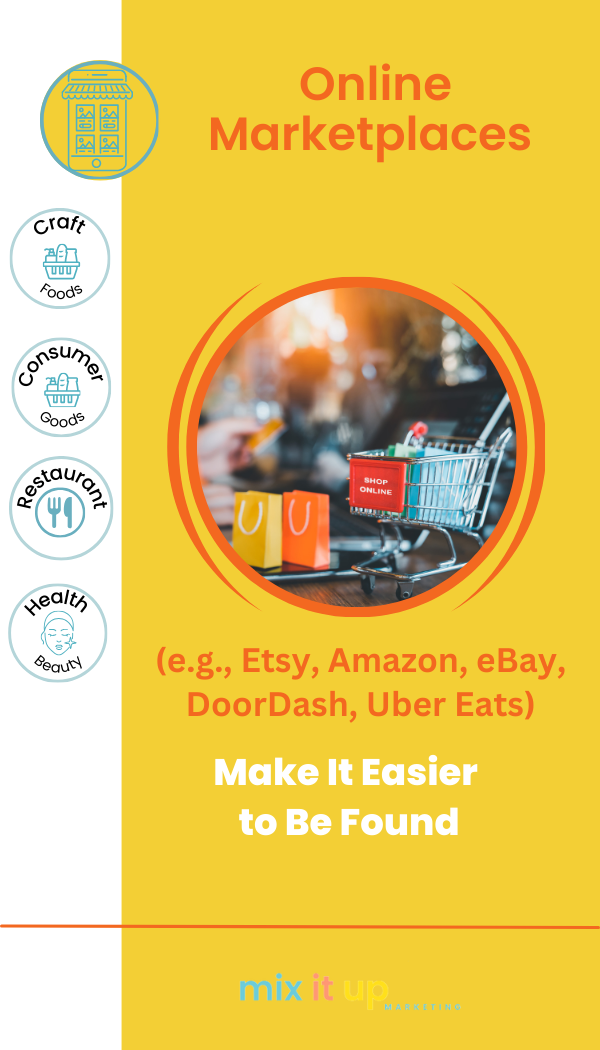
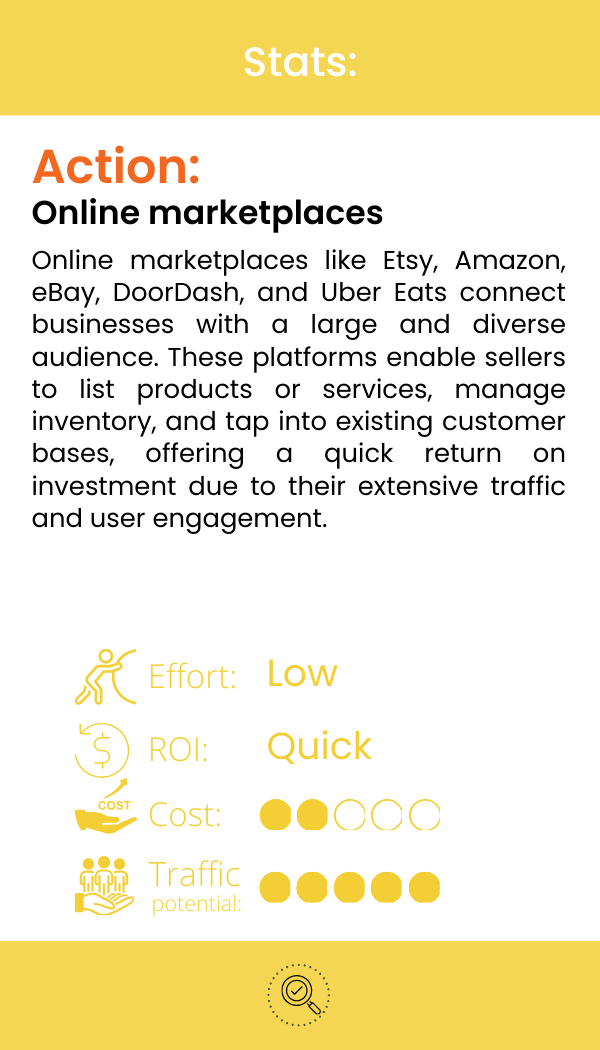
Online marketplaces like Etsy, Amazon, eBay, DoorDash, and Uber Eats are e-commerce platforms that connect sellers or service providers with customers. These platforms offer a wide range of products, services, and delivery options, making them powerful tools for businesses to reach a large and diverse audience. Businesses can create product listings, manage inventory, and leverage the marketplace’s existing customer base to generate sales and revenue. The ease of use and access to a substantial user base make online marketplaces an attractive option for businesses looking to quickly expand their reach and see a return on investment.
Ratings for Online Marketplaces Marketing Tactic:
Effort Level: Low to Medium – Online marketplaces offer a relatively straightforward way to list and sell products or services. While the initial setup and product listings may require some effort, the ongoing management can be relatively low effort, especially if utilizing existing platforms like Amazon or Etsy.
ROI: Quick ROI (Short-term tactics) – Online marketplaces can provide a quick return on investment as they often have a large user base and established traffic. Sellers can generate sales shortly after listing their products or services on these platforms.
Cost: Low to Medium – The cost of utilizing online marketplaces varies. It includes fees for listing, transaction fees, and potential advertising or promotion costs. While these costs are generally reasonable, they can increase if you opt for additional features or paid advertising within the marketplace.
Traffic and Lead Generation: High – Online marketplaces are known for high traffic and user engagement. They provide access to a vast audience of potential customers actively searching for products or services. Therefore, the potential for lead generation and sales is significant when using these platforms.
Industries That Would Benefit
Artisanal Crafts and Handmade Goods (Etsy): Independent artisans and crafters can showcase and sell their unique creations to a global audience.
Electronics and Gadgets (Amazon, eBay): Sellers of electronics and gadgets can leverage these platforms to reach a wide customer base.
Restaurant and Food Delivery (DoorDash, Uber Eats): Restaurants and food establishments can expand their delivery services and tap into a growing customer demand for online ordering.
Clothing and Apparel (Amazon, eBay): Retailers and fashion brands can list their products on popular marketplaces for increased exposure.
Books and Media (Amazon, eBay): Authors, publishers, and media producers can reach a broad readership and audience through these platforms.
Antiques and Collectibles (eBay): Sellers of antiques and collectible items can find a dedicated and interested customer base on eBay.
Home Decor and Furnishings (Amazon, eBay): Businesses in the home decor industry can showcase their products to a wide audience of potential buyers.
Local Artisan Food and Beverages (Etsy, DoorDash, Uber Eats): Small food producers and local artisans can use these platforms to sell their products locally and online.
Automotive Parts and Accessories (Amazon, eBay): Sellers of automotive parts can target a niche market of vehicle enthusiasts.
Health and Wellness Products (Amazon, eBay): Businesses offering health and wellness products can expand their reach and sales potential.
Flyers

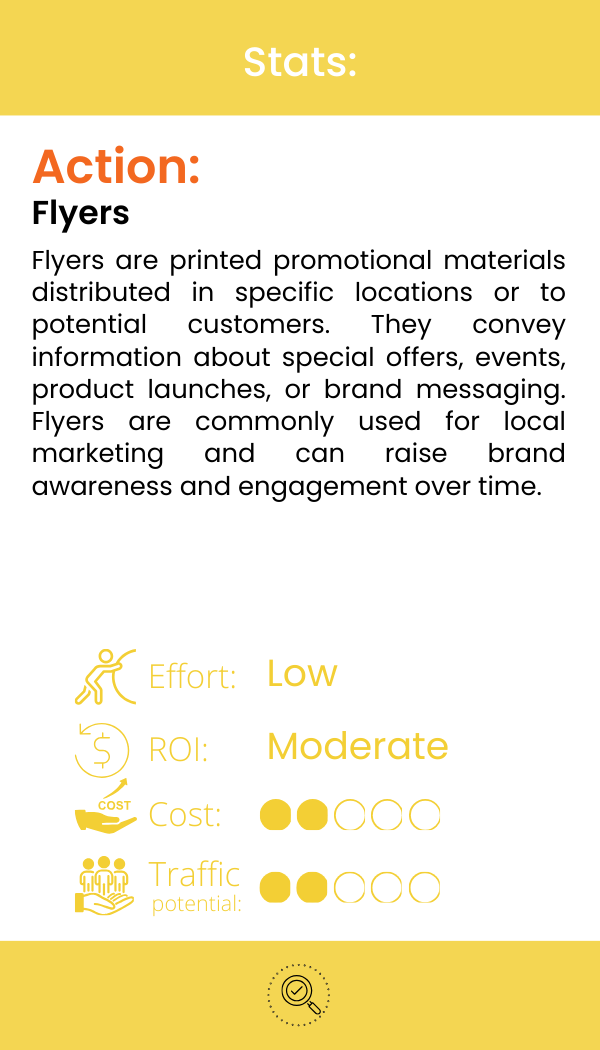
Flyers are printed promotional materials that are typically distributed in specific locations or handed out to potential customers. They can contain information about special offers, upcoming events, product launches, or general brand messaging. Flyers are commonly used for local marketing efforts and can be an effective way to reach a targeted audience in a specific geographic area or at events. While they may not lead to immediate conversions, they can contribute to brand recognition and engagement over time.
Ratings for Flyers Marketing Tactic:
Effort Level: Low – Creating flyers typically involves designing a simple promotional document or graphic and printing copies for distribution. It’s a relatively straightforward process that doesn’t require extensive planning or resource allocation.
ROI: Moderate ROI (Medium-term tactics) – Flyers can provide a moderate return on investment over a medium-term period. They can effectively raise awareness and promote events or special offers to a local or targeted audience. While they may not yield immediate results, they can increase brand recognition and customer engagement over time.
Cost: Low – The cost of producing flyers is generally low. It includes expenses for designing and printing the flyers and the cost of distribution (e.g., hiring a flyer distributor or placing them in strategic locations). Compared to many other marketing tactics, flyers are cost-effective.
Traffic and Lead Generation: Low to Moderate – Flyers can generate low to moderate website traffic or leads, depending on their content and distribution strategy. They are more suitable for providing information, raising awareness, and promoting local events or offers rather than direct lead generation. Their effectiveness in generating traffic or leads depends on how well they capture the audience’s attention and encourage them to take further action.
Industries That Would Benefit
Restaurants: A local restaurant can distribute flyers featuring their menu, daily specials, and a discount coupon to nearby households to attract diners.
Retail Companies: A retail store can create flyers highlighting clearance sale events and distribute them in shopping centers or local neighborhoods.
Craft Food Products: A craft bakery can design flyers showcasing artisanal bread and pastries and then distribute them at farmers’ markets or food festivals.
Hospitality: A hotel can use flyers to inform guests about on-site amenities, spa services, or upcoming events and activities.
Local Businesses: A local fitness studio can create flyers advertising special introductory fitness classes and distribute them to nearby residences and businesses.
Home Services: A home renovation company can use flyers to display before-and-after project photos, contact information, and a limited-time discount offer for home improvement services.
E-commerce: An online fashion retailer can include flyers in shipped orders, promoting a loyalty program, upcoming sales, or new arrivals for future online purchases.
Entertainment and Event Services: An event planning company can design flyers for distribution at bridal expos, showcasing their event planning services and expertise.
Personal Services: A local spa or wellness center can distribute flyers featuring their range of services, client testimonials, and a special promotion for new clients.
Nonprofit and Charity Organizations: A charitable organization can create flyers to raise awareness of a fundraising event, including event details, the cause, and how individuals can contribute or attend.
The key is to design compelling and visually appealing flyers with a clear call to action and then distribute them strategically to reach potential customers or supporters.
Local SEO
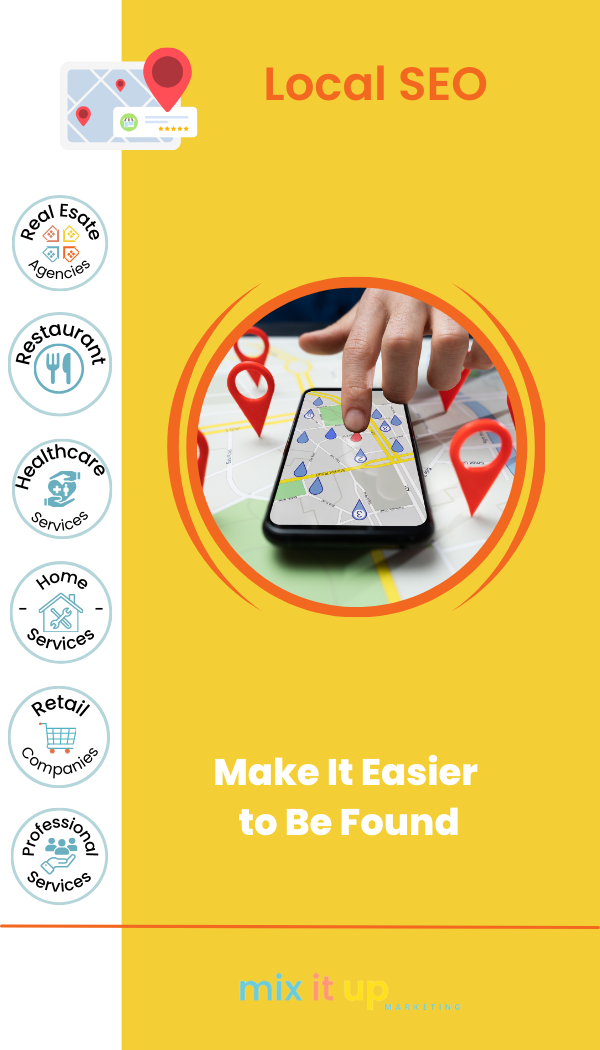
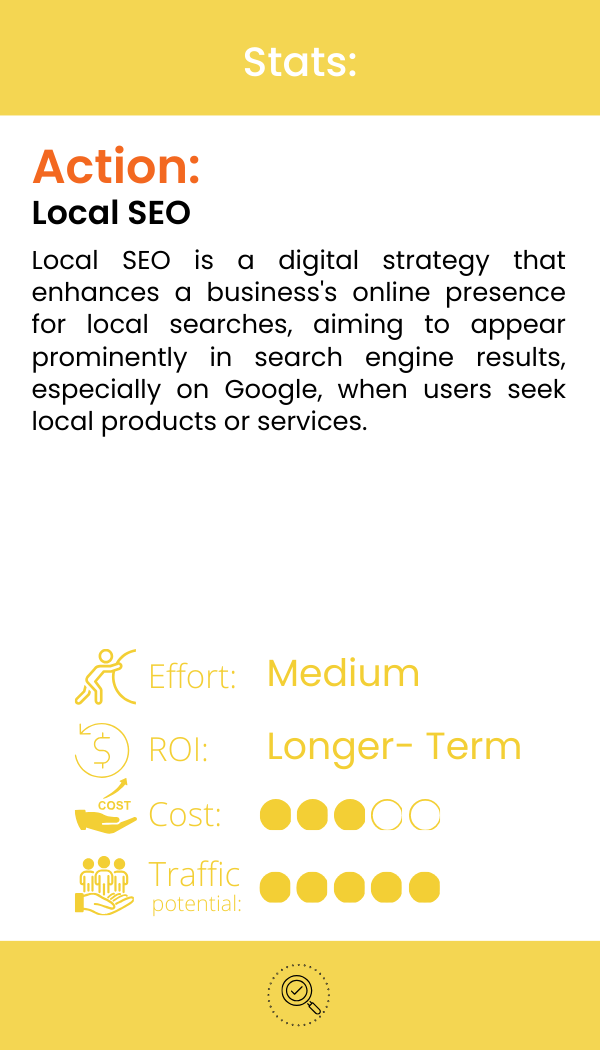
Local SEO is a digital marketing strategy focused on improving a business’s visibility in local search engine results, particularly on Google. It involves optimizing the business’s website, Google Business profile, and other online assets to ensure they appear prominently when users search for products or services in their local area. This tactic is essential for brick-and-mortar businesses, professional services, and any organization targeting a local customer base. It aims to connect businesses with nearby consumers who are actively searching for products or services.
Ratings for Local SEO Marketing Tactic:
Effort Level: Medium – Implementing local SEO involves optimizing a business’s online presence for local search. While it may require moderate effort, such as keyword research, on-page optimization, and local directory listings, it’s manageable for businesses with the proper knowledge or the assistance of SEO professionals.
ROI: Longer-term ROI (Requires patience and consistency) – Local SEO is a long-term strategy that requires consistent efforts to improve search engine rankings and increase local visibility. It may take several months or more to see significant results, making it a longer-term investment.
Cost: Low to Medium – The cost of local SEO can vary depending on factors such as the level of competition, the size of the target market, and the complexity of the strategy. Generally, it falls within a low to medium-cost range, making it accessible to small businesses with limited budgets.
Traffic and Lead Generation: High – Local SEO is highly effective in driving targeted traffic and generating leads for businesses operating in specific geographic areas. Optimizing for local search can lead to increased website traffic, phone calls, inquiries, and foot traffic to physical locations.
Industries That Would Benefit
Real Estate: Local real estate agencies can optimize their online presence to attract potential buyers and renters in specific neighborhoods or cities.
Restaurants: Local eateries can use local SEO to ensure that their menus, location, and reviews appear in search results when hungry customers look for dining options nearby.
Healthcare Services: Medical clinics, dental offices, and healthcare professionals can use local SEO to help patients find their practices when seeking local medical services.
Home Services: Businesses offering plumbing, electrical work, landscaping, and home renovation can use local SEO to connect with homeowners in their service areas.
Retail Companies: Local retailers can optimize their websites to draw in local shoppers searching for products they offer in physical stores.
Professional Services: Law firms, accounting firms, and other professional services can use local SEO to establish their expertise within specific regions and attract local clients.
Education: Local schools, colleges, and tutoring centers can use local SEO to reach students and parents searching for nearby educational institutions or services.
Consumer Goods: Businesses selling consumer goods can optimize their listings for local shoppers seeking products within their vicinity.
Hospitality: Hotels, resorts, and vacation rentals can enhance their visibility in local searches to attract travelers looking for accommodations in a particular area.
Finance/Insurance: Local financial advisors, insurance agents, and credit unions can use local SEO to increase their visibility and trust among potential clients within their communities.
Local SEO is invaluable for any business aiming to capture the attention of local customers actively searching for products or services in their geographic area.
Content Syndication or Sharing
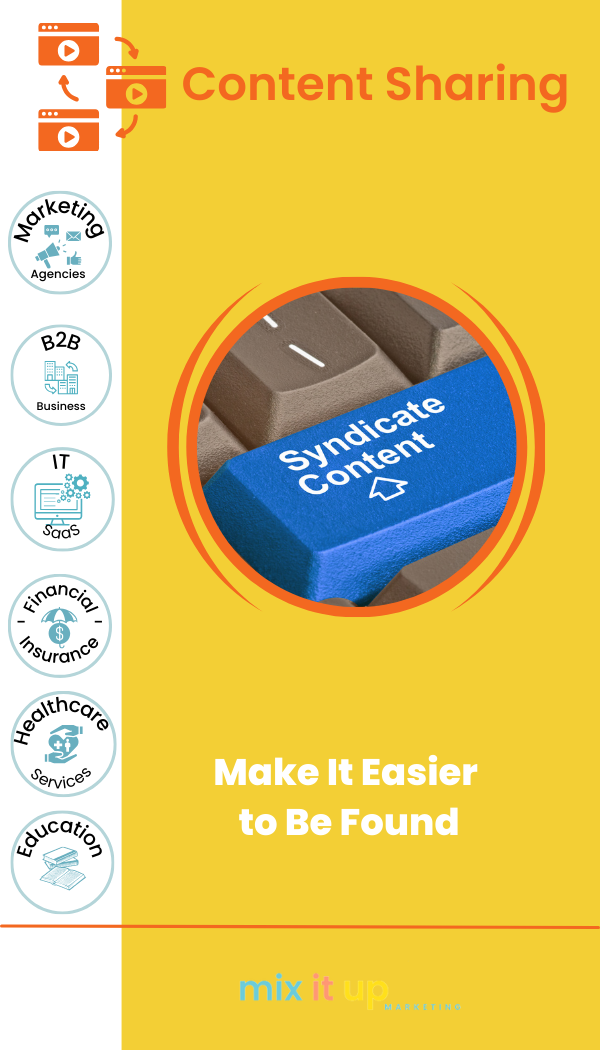
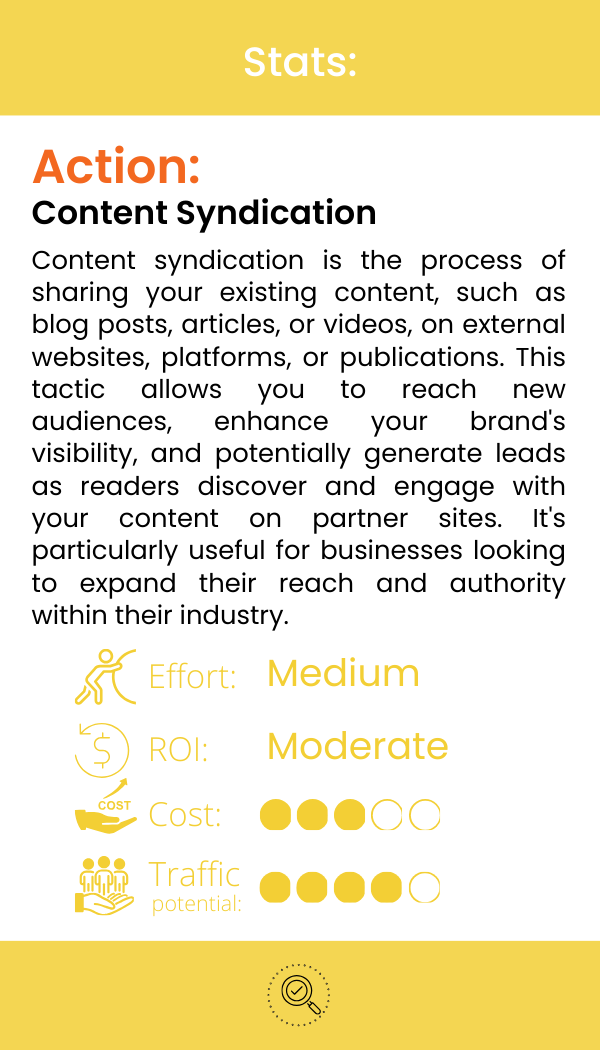
Content syndication is the process of sharing your existing content, such as blog posts, articles, or videos, on external websites, platforms, or publications. This tactic allows you to reach new audiences, enhance your brand’s visibility, and potentially generate leads as readers discover and engage with your content on partner sites. It’s particularly useful for businesses looking to expand their reach and authority within their industry.
Ratings for Content Syndication Marketing Tactic:
Effort Level: Medium – Content syndication involves republishing your existing content on third-party websites or platforms. While it doesn’t require the same effort as creating entirely new content, it involves planning, coordinating, and maintaining relationships with content syndication partners.
ROI: Moderate ROI (Medium-term tactics) – Content syndication can generate leads and traffic by exposing your content to new audiences on external platforms. However, these efforts may take some time to yield significant results, as they rely on building an audience and authority on external sites.
Cost: Low to Medium – The cost of content syndication can vary depending on whether you choose free or paid syndication platforms. Some partnerships may involve fees or revenue-sharing agreements. It’s a relatively cost-effective tactic compared to creating entirely new content.
Traffic and Lead Generation: Moderate – Content syndication can lead to moderate traffic and lead generation as it exposes your content to new audiences. The results can be seen over the medium term as your content gains visibility on partner websites. It may not provide an immediate, high-volume influx of traffic and leads, but it can be valuable for long-term growth.
Industries That Would Benefit
Lorem ipsum dolor sit amet, consectetur adipiscing elit. Ut elit tellus, luctus nec ullamcorper mattis, pulvinar dapibus leo.
Sweeten the Deal
Discounts & Coupons

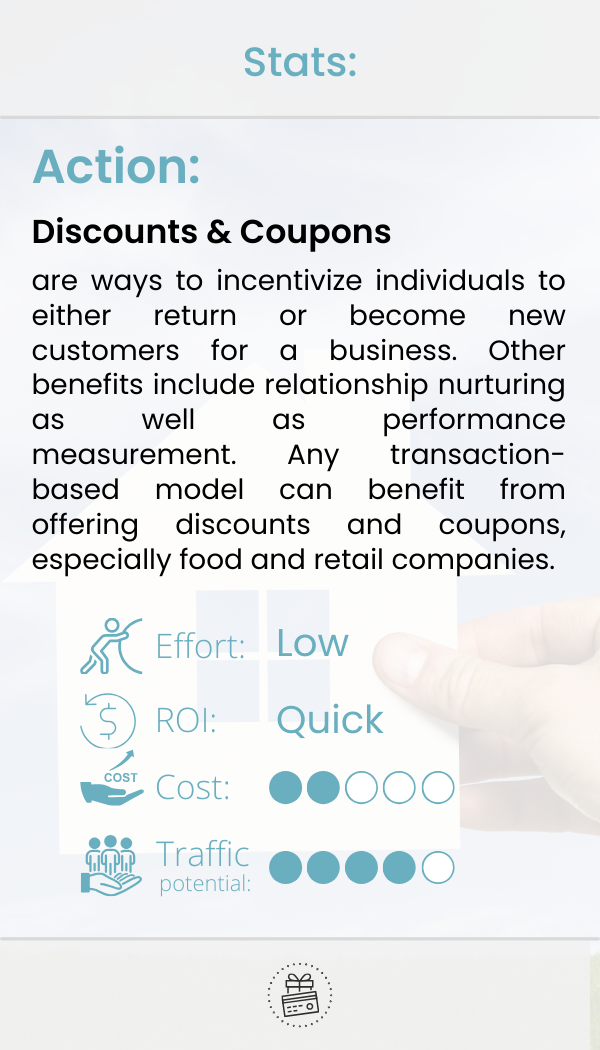
Discounts and coupons incentivize individuals to either return or become new customers for a business. Other benefits include relationship nurturing as well as performance measurement. Any transaction-based model can benefit from discounts and coupons, especially for food and retail companies.
Ratings for Discounts & Coupons Marketing Tactic:
Effort: Low Effort – Creating and distributing discounts and coupons is relatively straightforward and can be managed with minimal resources.
Return on Investment: Quick ROI – Discounts and coupons are designed to stimulate immediate sales, often resulting in a quick return on investment.
Cost: Low Cost – Generally, creating and distributing discounts or coupons is minimal, primarily digitally.
Website Traffic/Lead Generation: Moderate Traffic – While not the highest traffic driver, discounts can attract a fair amount of website visitors and lead generation, especially if promoted effectively.
Industries That Would Benefit
- Retail Companies: Seasonal discounts to clear inventory, attract new customers.
- E-commerce: Exclusive online coupons to incentivize first-time purchases and repeat business.
- Restaurants: Special meal deals to attract diners during off-peak hours or days.
- Health and Beauty: Discounted service packages to introduce new treatments or products.
- Fitness and Wellness: Membership discounts to encourage sign-ups at the beginning of the year.
- Travel: Promotional codes for off-season travel to boost bookings.
- Hospitality: Special rates for weekend stays or holiday packages.
- Consumer Goods: Coupons for new products to drive trial and adoption.
- Event Planning and Management: Early bird discounts for event tickets to generate initial interest.
- Home Improvement and Renovation: Discount vouchers for large projects or referrals.
Survey

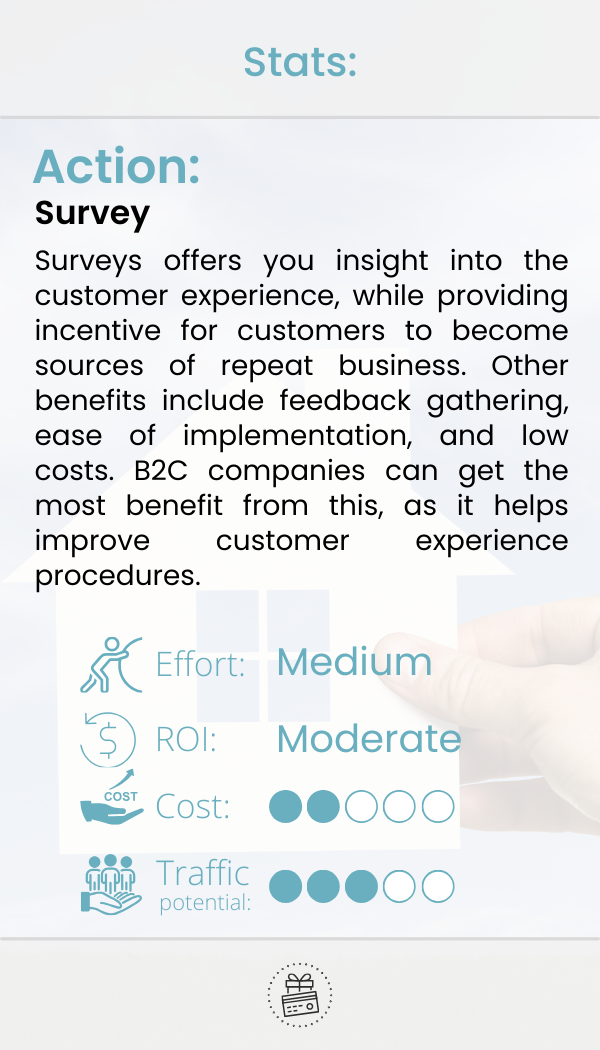
Surveys offer you insight into the customer experience while providing incentives for customers to become sources of repeat business. Other benefits include feedback gathering, ease of implementation, and low costs. B2C companies can benefit most from this, as it helps improve customer experience procedures.
Ratings for Survey Marketing Tactic:
Effort: Medium Effort – Surveys require moderate effort, including planning questions, setting up the survey, and analyzing responses.
Return on Investment: Moderate ROI (Medium-term tactics) – Surveys can yield insights over a few months, aiding in product/service improvement and customer engagement.
Cost: Low Cost – Typically, surveys have minimal costs associated with software tools and time invested in analysis.
Website Traffic/Lead Generation: Medium Traffic -Surveys can drive moderate traffic, especially when promoted through social media or email campaigns, and can help understand customer preferences for better lead targeting.
Industries That Would Benefit
- Healthcare Services: Gain patient feedback on services, improve care quality.
- Hospitality: Understand guest preferences, enhance experience.
- Travel Agencies: Collect data on travel trends, tailor packages.
- Education Institutions: Feedback on courses, improve educational offerings.
- Finance/Insurance: Customer satisfaction insights, tailor financial products.
- Retail Companies: Understand shopping preferences, improve stock selection.
- E-commerce Platforms: Customer feedback for website usability improvements.
- Fitness and Wellness Centers: Feedback on classes, personalize training programs.
- Technology and IT Services: User feedback on software, guide product development.
- Event Planning and Management: Feedback on events, improve planning services.
Surveys are a versatile tool for gathering valuable insights and feedback from customers, clients, and stakeholders.
Quiz

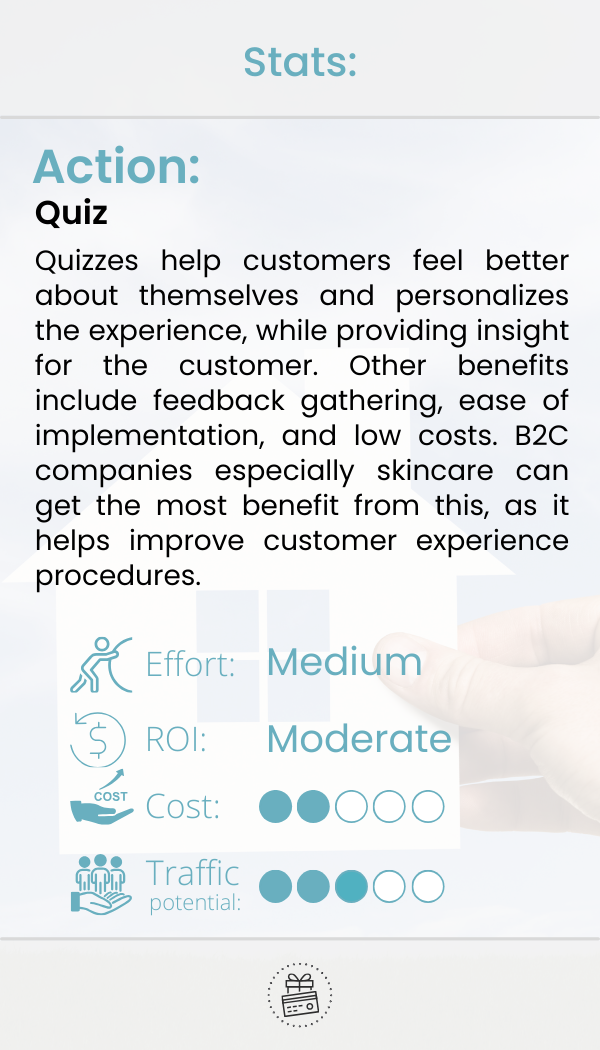
Quizzes help customers feel better about themselves and personalize the experience while providing insight for the customer. Other benefits include feedback gathering, ease of implementation, and low costs. B2C companies, especially skincare, can benefit most from this, as it helps improve customer experience procedures.
Ratings for Quiz Marketing Tactic:
Effort: Medium Effort – Creating a quiz requires moderate planning and content creation, including designing the questions and integrating the quiz into your marketing channels.
Return on Investment: Moderate ROI – Quizzes can engage customers and collect valuable data over a few months, aiding in medium-term marketing strategies.
Cost: Low Cost – Generally, quizzes can be created with minimal financial resources, especially if using existing online tools or platforms.
Website Traffic and Lead Generation: Medium Traffic – Quizzes can drive a moderate amount of traffic and generate leads, especially if they are well-targeted and engaging.
Industries That Can Benefit
- Education: Quizzes can be an engaging way to test knowledge or preferences, useful for educational content marketing.
- Health and Beauty: For product recommendations or health assessments.
- Fitness and Wellness: To assess fitness levels or recommend workout plans.
- Real Estate: For potential buyers to find their ideal property type or location.
- Travel: To suggest travel destinations or activities based on preferences.
- Consumer Goods: For product selection guidance based on lifestyle or needs.
- Healthcare Services: To guide patients to appropriate services or health information.
- Pet Services: To recommend products or services based on pet breed or behavior.
- Finance/Insurance: For assessing financial knowledge or insurance needs.
- Technology and IT Services: To determine the right tech solutions for businesses or individuals.
However, quizzes can be a fun and engaging way to interact with customers and prospects across various sectors.
Ebook

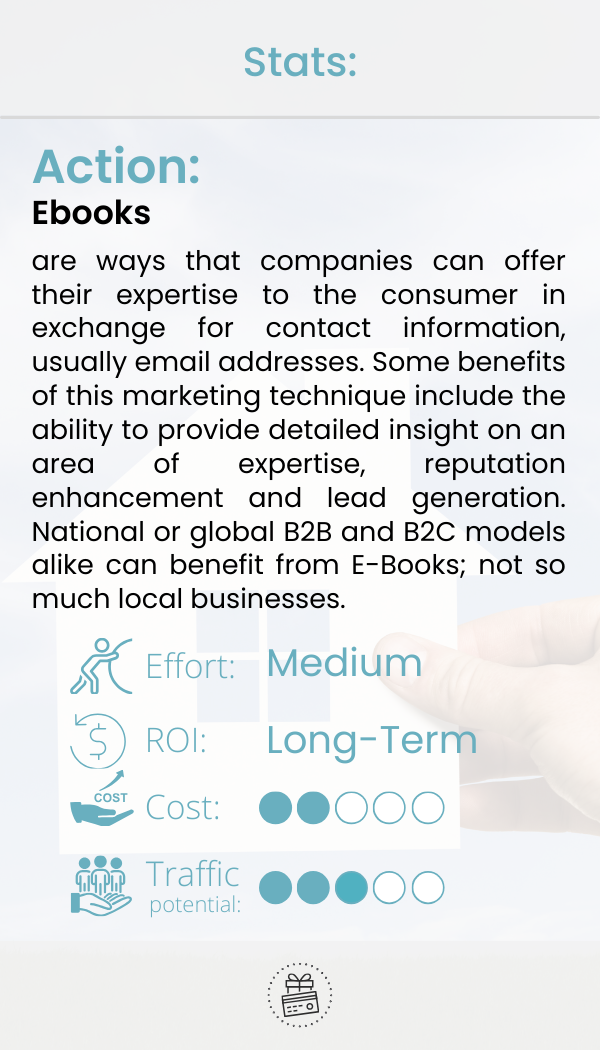
E-books are ways companies can offer their expertise to the consumer in exchange for contact information, usually email addresses. Some benefits of this marketing technique include providing detailed insight into an area of expertise, reputation enhancement, and lead generation. National or global B2B and B2C models alike can benefit from E-Books, but not so much from local businesses.
Ratings for Ebook Marketing Tactic:
Effort: Medium Effort – Creating an eBook involves a moderate level of time and resources, including content creation, design, and distribution strategies.
Return on Investment: Longer-term ROI – Ebooks are a long-term strategy, building authority and trust over time, often taking months to see substantial results in terms of lead generation and customer engagement.
Cost: Low Cost – The primary investment is time and expertise in content creation. Depending on the design and distribution method, the financial costs can be kept relatively low.
Website Traffic and Lead Generation: Medium Traffic – Ebooks can generate a moderate amount of traffic and leads, particularly when used as part of a content marketing or lead magnet strategy.
Industries That Would Benefit
- Real Estate: An eBook on home buying tips or market trends to establish expertise and attract potential homebuyers.
- Healthcare Services: A guide on wellness and preventive care to engage patients and showcase their expertise.
- Education: Ebooks on educational strategies or curriculum ideas to engage educators and parents.
- Finance/Insurance: Guides on financial planning or insurance options to educate and attract potential clients.
- Technology and IT Services: Ebooks on the latest tech trends or cybersecurity tips to attract businesses needing IT services.
- Event Planning and Management: A comprehensive guide on planning successful events to showcase expertise and attract clients.
- Legal Services: An eBook on navigating legal challenges in specific areas like business law or estate planning.
- Fitness and Wellness: Guides on exercise routines, wellness tips, or nutrition plans to engage and attract health-conscious individuals.
- Environmental Services: An eBook on sustainable practices or environmental awareness to engage potential clients and communities.
- Nonprofit and Social Services: Guides on volunteering, community engagement, or the impact of non-profit work to attract donors and volunteers.
Ebooks are versatile and can be customized to provide valuable information and engage potential customers or clients across various sectors.
Contests
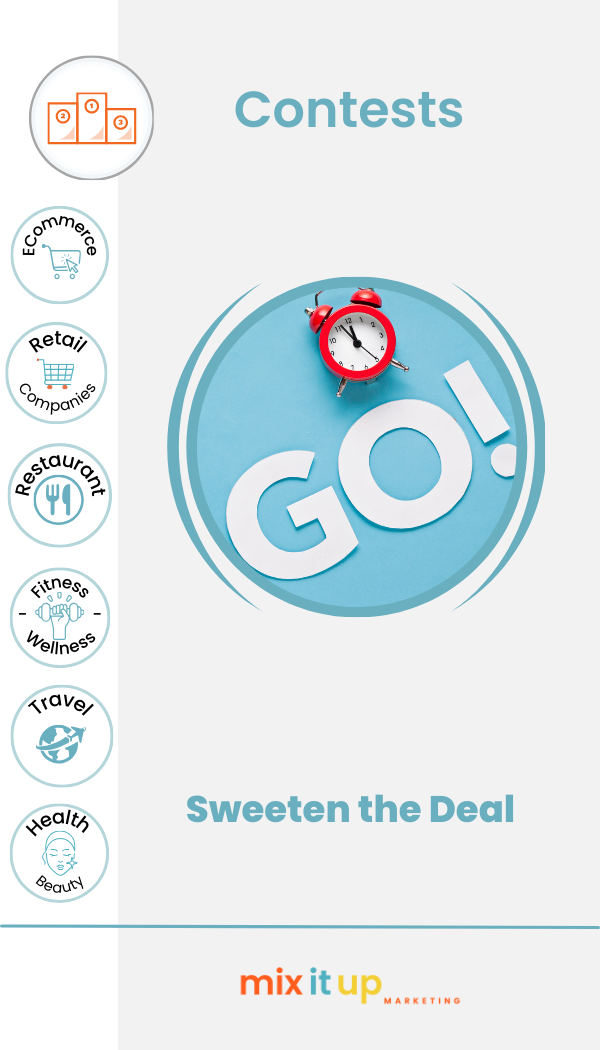
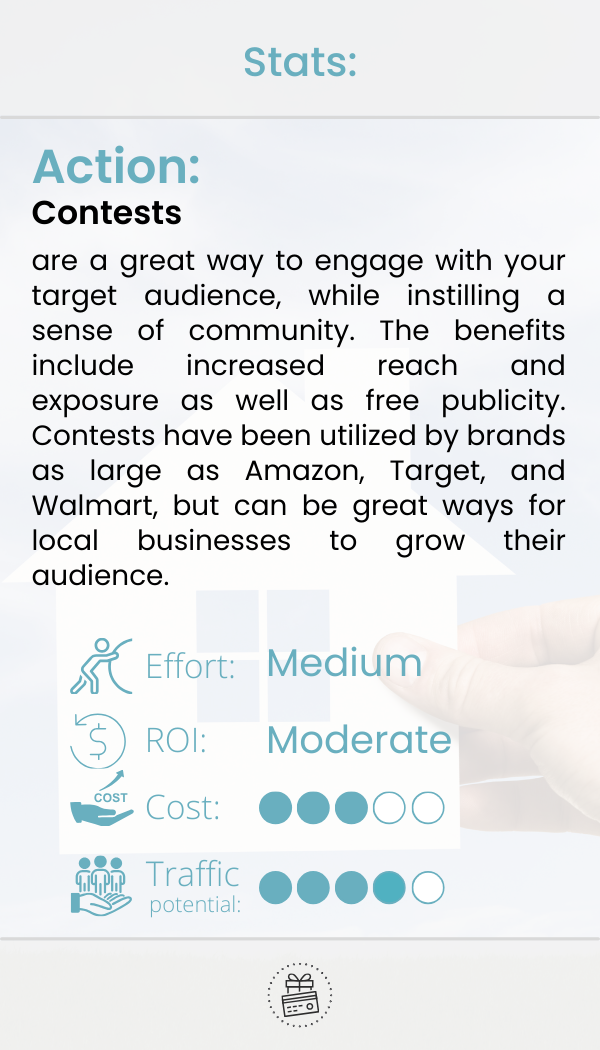
Contests are a great way to engage with your target audience while instilling a sense of community. The benefits include increased reach and exposure as well as free publicity. Contests have been utilized by brands as large as Amazon, Target, and Walmart, but can be great ways for local businesses to grow their audience.
Ratings for Contests Marketing Tactic:
Effort: Medium Effort – Requires planning, promotion, and management of entries and outcomes.
Return on Investment: Moderate ROI (Medium-term tactics) – Contests can enhance engagement and brand awareness, often yielding results in a few months.
Cost: Low to Medium Cost – Costs can vary depending on the scale and promotion of the contest.
Traffic Potential: Moderate Traffic – Effective at driving engagement and some traffic to websites or social media platforms.
Industries That Would Benefit
- Retail Companies: Can use contests to increase customer engagement, especially on social media, by encouraging user-generated content.
- E-commerce: Ideal for creating buzz around new products or services, leading to increased website traffic.
- Fitness and Wellness: Contests can motivate customer participation in wellness challenges, fostering community.
- Restaurants: Can host contests for the best recipe ideas or food photography, engaging with local food enthusiasts.
- Travel: Competitions for the best travel stories or photo submissions can create buzz and increase engagement.
- Craft Food Products: Contests for creative recipes using their products can boost brand recognition.
- Health and Beauty: Can run beauty challenges or makeovers, generating interest and social media content.
- Technology and IT Services: Coding or innovation contests can highlight their services and engage the tech community.
- Event Planning and Management: Hosting event-themed contests can showcase their creativity and reach potential clients.
- Art and Creative Services: Art contests can be a great way to showcase talent and engage with the art community.
Contests can be a versatile marketing tactic, applicable to various industries, especially where customer engagement and community building are vital.
Webinar

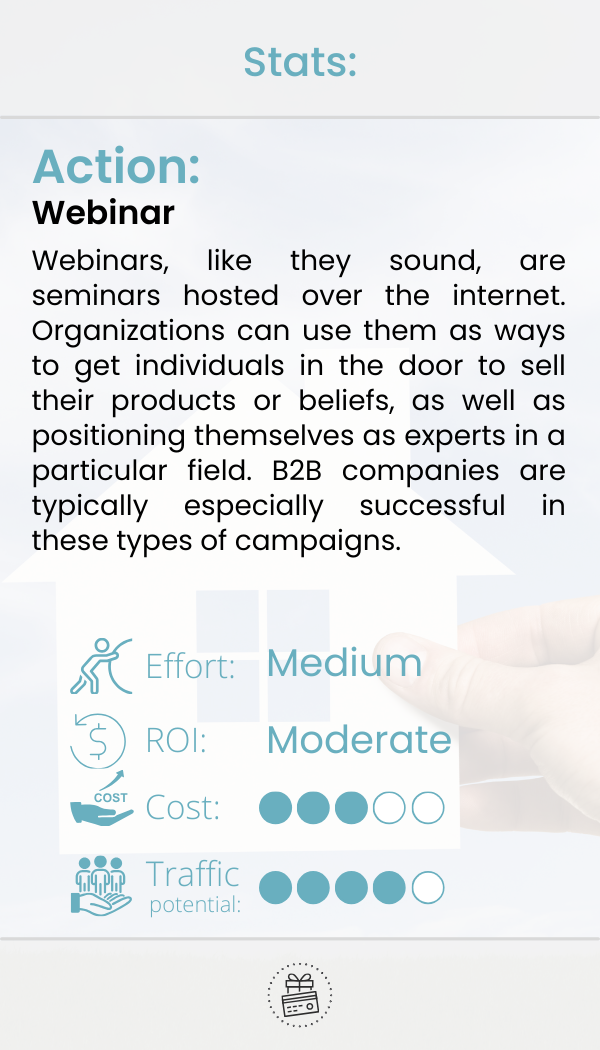
Webinars, as they sound, are seminars hosted over the internet. Organizations can use them to get individuals in the door to sell their products or beliefs and position themselves as experts in a particular field. B2B companies are typically incredibly successful in these types of campaigns.
Ratings for Webinar Marketing Tactic:
Effort: Medium Effort – Webinars are generally manageable and require planning, content creation, and technical setup.
Return on Investment: Moderate ROI – Webinars can offer a good ROI within a few months, enhancing brand authority and lead generation.
Cost: Low to Medium Cost – Webinars can range from low to moderate cost, depending on the platform and promotional efforts.
Traffic Potential: Moderate Traffic – Webinars can generate moderate website traffic and leads, mainly when promoted through social media and email marketing.
Industries That Would Benefit
- Education: Offering informational webinars on relevant topics can attract students or parents, providing value and boosting enrollment.
- Healthcare Services: Hosting webinars on health topics can position the business as a knowledgeable authority in the healthcare sector.
- Legal Services: Law firms can conduct webinars on legal issues, attracting potential clients seeking expertise.
- Financial/Insurance Services: Webinars on financial planning or insurance products can educate and attract potential clients.
- Technology and IT Services: Demonstrating software or discussing tech trends in webinars can engage potential clients.
- Marketing Agencies: Sharing marketing insights or case studies in webinars can showcase expertise to potential clients.
- Real Estate: Hosting webinars on market trends or home buying tips can attract potential buyers or sellers.
- Environmental Services: Webinars about environmental sustainability can raise awareness and attract eco-conscious clients.
- Fitness and Wellness: Offering webinars on health, fitness, or wellness topics can engage and grow the client base.
- Event Planning and Management: Sharing event planning tips or industry insights in webinars can attract potential clients.
While webinars can benefit a wide range of industries, their success often depends on the quality of content and the ability to engage and educate the target audience effectively. The suitability of webinars may also vary based on each industry’s specific goals and audience.
Refer a Friend or Bring a Friend
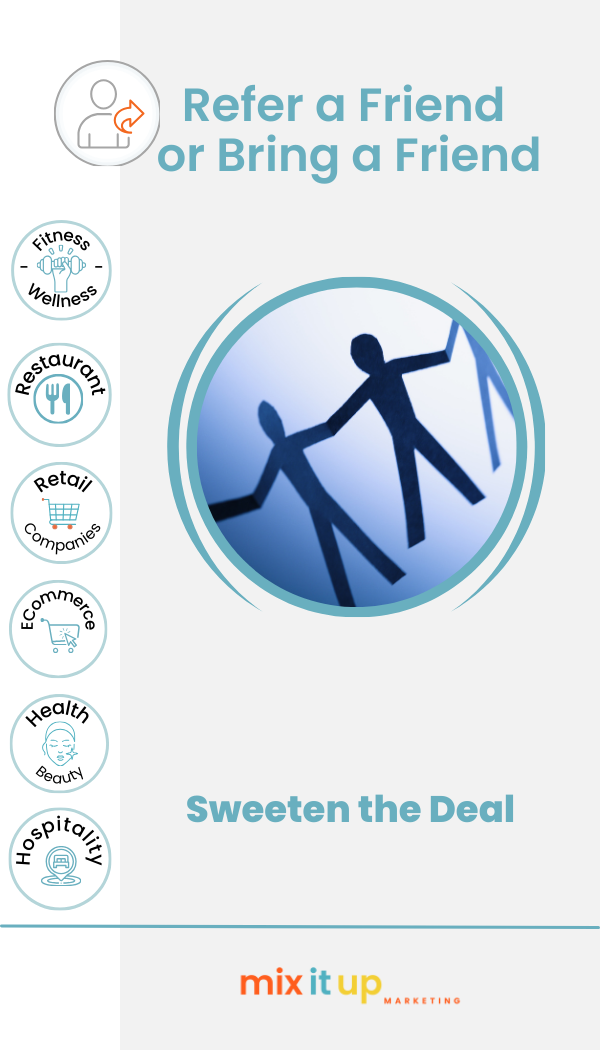
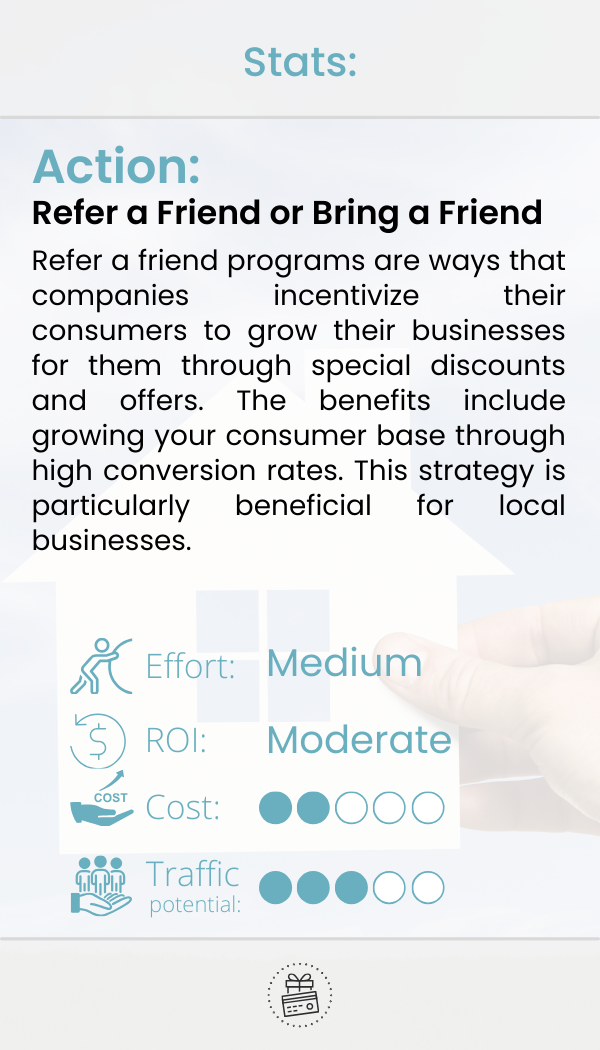
Refer-a-friend programs are ways that companies incentivize their consumers to grow their businesses through special discounts and offers. The benefits include developing your consumer base through high conversion rates. This strategy is particularly beneficial for local businesses.
Ratings for Refer a Friend Marketing Tactic:
Effort: Medium Effort – This tactic requires some planning and implementation but is generally manageable. It involves creating referral programs and incentives for existing customers to bring in new ones.
Return on Investment: Moderate ROI – Referral programs can yield sustainable results over a medium time frame, enhancing customer base and brand loyalty.
Cost: Low Cost – This tactic usually requires minimal financial investment. Costs might include rewards or referral incentives but are relatively low compared to other marketing strategies.
Traffic Potential: Medium Traffic – Referral programs can generate a moderate level of traffic and new leads as existing customers encourage friends and family to check out the business.
Industries That Would Benefit
Fitness and Wellness: Offering a free class or a discount on membership for every new member referred can encourage existing clients to bring friends.
Restaurants: “Bring a friend” deals, like “buy one, get one free” offers, can attract groups and build a loyal customer base.
Retail Companies: Referral programs can offer discounts or special offers for both the referrer and the new customer, driving repeat and new business.
E-commerce: Implement referral codes that offer discounts or rewards for both the referrer and the new customer, enhancing repeat purchases.
Health and Beauty: Offering a discount on services or a free product for every new client referred can be a strong incentive.
Hospitality: Hotels and resorts can offer room upgrades or special amenities for guests who refer new customers.
Travel: Travel agencies can provide discounts or additional services for clients who refer new travelers.
Education: Language schools or tutoring services can offer free sessions or discounts for each new student referred.
Pet Services: Offering a free service or a discount for every new pet owner referred can help expand the customer base.
Event Planning and Management: Referral incentives can help gain new clients through word-of-mouth recommendations.
Remember that the success of this tactic can also depend on the quality of the rewards or incentives offered to those who refer friends. Additionally, ensuring that the referral process is straightforward and user-friendly for customers to participate effectively is essential.
Free Trial

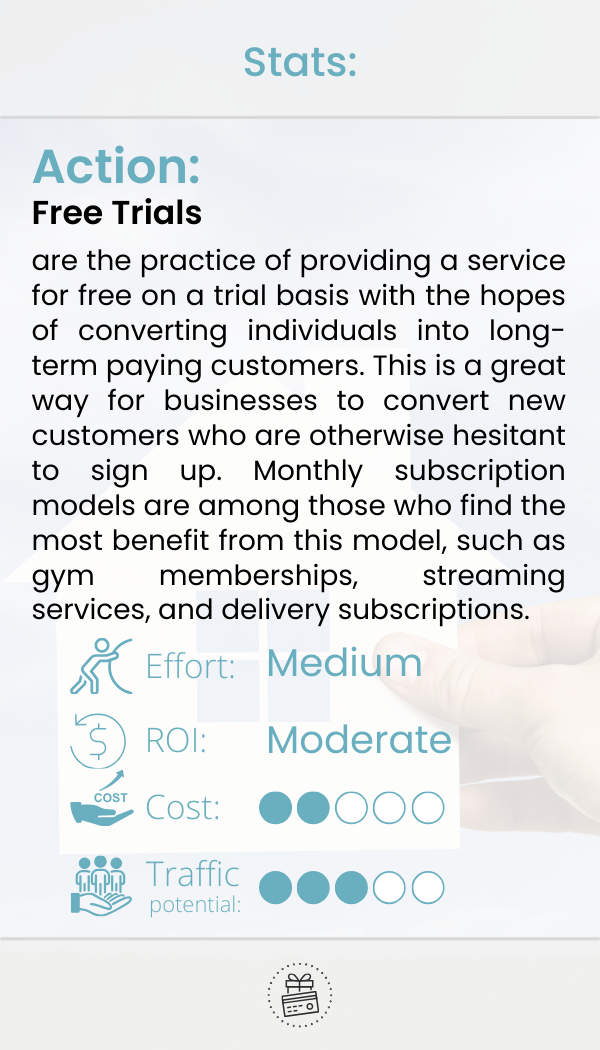
Free trials are the practice of providing a service for free on a trial basis to convert individuals into long-term paying customers. This is an excellent way for businesses to convert new customers who are otherwise hesitant to sign up. Monthly subscription models, such as gym memberships, streaming services, and delivery subscriptions, are among those who benefit most from this model.
Ratings for Free Trial Marketing Tactic:
Effort: Medium Effort – Setting up free trials involves planning, developing a system to manage the trial period, and possibly adjusting the product or service for trial use.
Return on Investment: Moderate ROI – Free trials can lead to conversions and customer loyalty over a medium-term period, as customers get a hands-on experience with the product or service.
Cost: Low Cost – Generally, offering a free trial is minimal as it mainly involves forgoing immediate revenue in exchange for potential future sales.
Traffic Potential: Medium Traffic – While free trials can attract interest, they may not drive high volumes of traffic immediately but contribute to steady lead generation over time.
Industries That Would Benefit
Software and IT Services: Offering a free trial of software or IT services allows potential customers to experience the functionality and user-friendliness of the product.
Fitness and Wellness: Gyms and wellness apps can offer free trials to showcase their facilities or online classes, encouraging long-term sign-ups.
E-commerce: E-commerce platforms can provide a free trial of premium membership benefits like expedited shipping or exclusive deals.
Education: Online learning platforms and educational apps can offer free trials to demonstrate the quality of their courses or content.
Healthcare Services: Telehealth services or health apps could provide a free trial period, allowing users to experience their ease of use and effectiveness.
Technology and IT Services: Tech companies can offer free trials of their new products or services, encouraging user feedback and adoption.
Marketing Agencies: Offering a free trial of certain services, like social media management or SEO, can showcase their expertise to potential clients.
Finance/Insurance: Fintech apps or platforms can provide a free trial period for premium financial tracking or advisory services.
Consumer Goods: A free trial period for new products can help gain consumer trust and feedback.
Legal Services: Offering a brief complimentary consultation or trial of online legal services can attract clients unsure about committing.
Bundles or packages
Offering package bundles provides the consumer an incentive, usually a discounted price point, in exchange for their business in more than one area. The biggest benefit of this is that package bundles usually lead to bigger total transactions, even if it is at a discounted rate. Two discounted services is always better than one full-price one. This is practiced across the majority of consumer-facing companies.
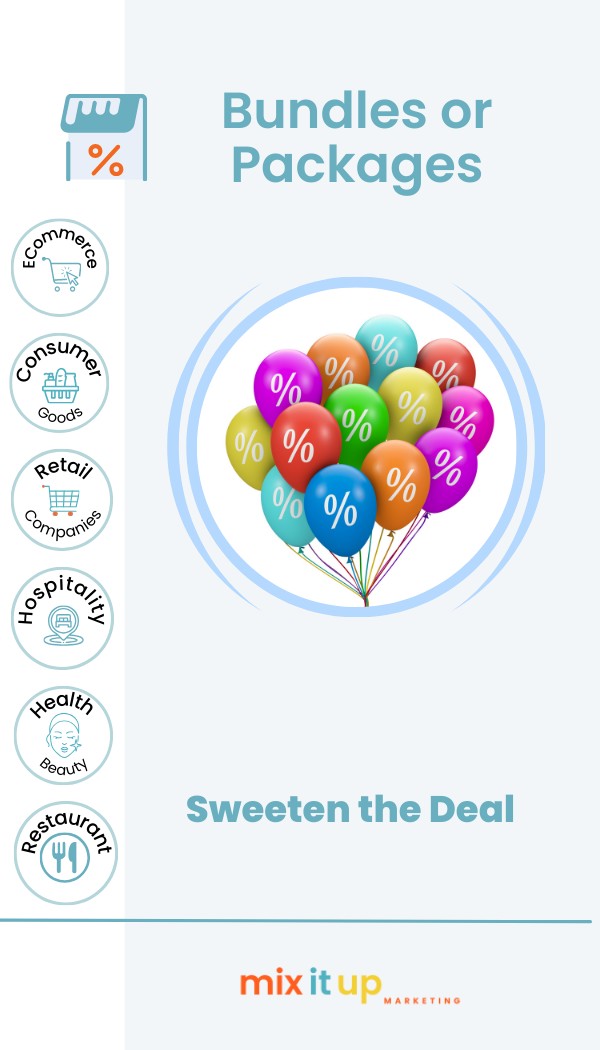
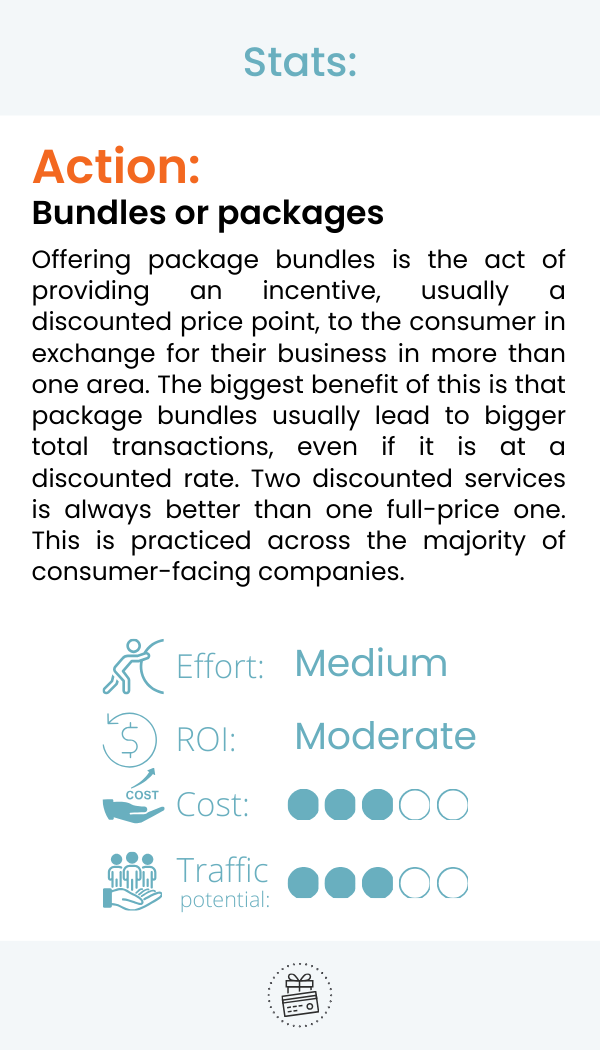
Ratings for Bundles or Packages Marketing Tactic:
Effort: Medium Effort – Creating bundles or packages involves a moderate level of effort, including product selection, pricing strategies, and promotional material creation.
Return on Investment: Moderate ROI – Bundles often encourage higher purchase values and can improve customer retention, providing a moderate ROI over a few months.
Cost: Medium Cost – The cost is primarily in the form of discounts offered on the bundle, along with marketing expenses. Monthly costs could range from $500 to $2,000.
Website Traffic and Lead Generation: Medium Traffic – Bundles can attract attention and drive moderate website traffic, especially when promoted effectively through various channels.
Industries That Would Benefit
Retail Companies: Offering product bundles can encourage customers to buy more items at once, increasing sales volume.
E-commerce: E-commerce platforms can create themed bundles, like holiday packages, which can drive sales during specific seasons.
Health and Beauty: Bundling complementary products, like skincare routines or wellness sets, can appeal to customers seeking holistic solutions.
Fitness and Wellness: Creating bundles of classes or services, such as yoga sessions with wellness workshops, can attract customers looking for comprehensive health solutions.
Consumer Goods: Bundling related products, such as kitchen gadgets or tech accessories, can increase perceived value for customers.
Hospitality: Offering package deals that include room stays with additional services like spa treatments or dining can enhance guest experiences.
Restaurants: Creating meal deals or combo offers can entice customers to try more menu items.
Technology and IT Services: Bundling software solutions or tech support packages can appeal to businesses seeking comprehensive IT solutions.
Event Planning and Management: Offering complete event packages, from venue to decoration and catering, simplifies the process for clients.
Education: Educational institutions can bundle courses or resources, providing value-added packages for learners.
Memberships
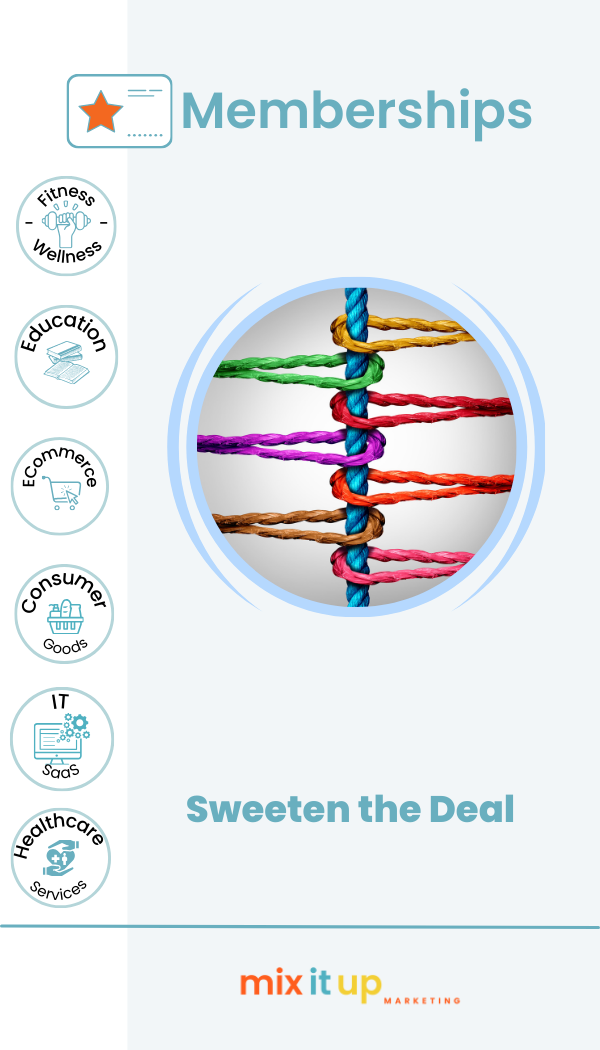
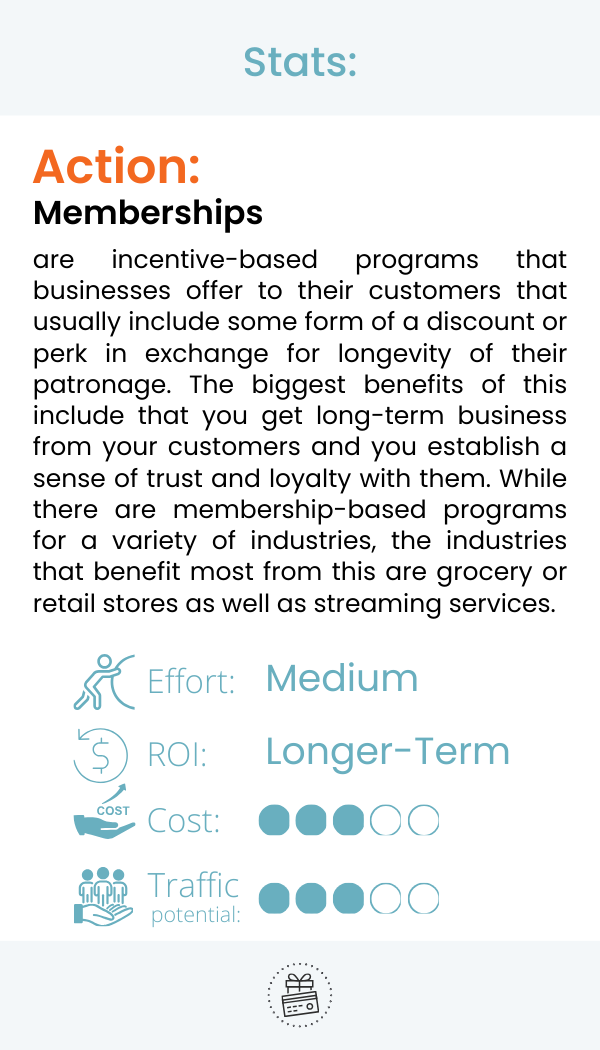
Memberships are incentive-based programs that businesses offer to their customers that usually include some form of a discount or perk in exchange for the longevity of their patronage. The biggest benefits of this include that you get long-term business from your customers and you establish a sense of trust and loyalty with them. While there are membership-based programs for a variety of industries, the industries that benefit most from this are grocery or retail stores as well as streaming services.
Ratings for Membership Marketing Tactic:
Effort: Medium Effort – Creating and managing memberships requires moderate effort, including planning, content creation, and regular engagement with members.
Return on Investment: Longer-term ROI – Memberships focus on building long-term customer relationships and loyalty, typically yielding substantial results over time.
Cost: Medium Cost – Setting up and maintaining a membership program involves moderate costs for managing the platform, content, and possibly offering member benefits.
Traffic Potential: Medium Traffic – Memberships can generate a steady stream of engagement and traffic, especially from repeat visitors and loyal customers.
Industries That Would Benefit
- Fitness and Wellness: Gyms and wellness centers can offer exclusive classes, discounts, and health tips to members.
- Education: Online educational platforms can provide members with access to specialized courses and learning materials.
- Healthcare Services: Regular health check-ups, wellness tips, and personalized healthcare plans for members.
- Consumer Goods: Exclusive member discounts and early access to new products.
- E-commerce: Membership benefits could include free shipping, early access to sales, or exclusive products.
- Technology and IT Services: Access to premium tech support, software updates, and exclusive webinars.
- Event Planning and Management: Membership benefits might include discounts on event planning services or early access to event tickets.
- Art and Creative Services: Members could receive early access to new artworks, invitations to exclusive events, or online art classes.
- Legal and Financial Services: Providing members with regular legal updates, webinars, and exclusive consultancy slots.
- Environmental Services: Membership programs focusing on sustainability education, eco-friendly product discounts, and community events.
Remember that the success of a membership program depends on offering compelling benefits and maintaining strong customer relationships. The suitability of a membership tactic can vary within each industry, so it’s essential to tailor the program to your target audience’s specific needs and preferences.
Loyalty Program

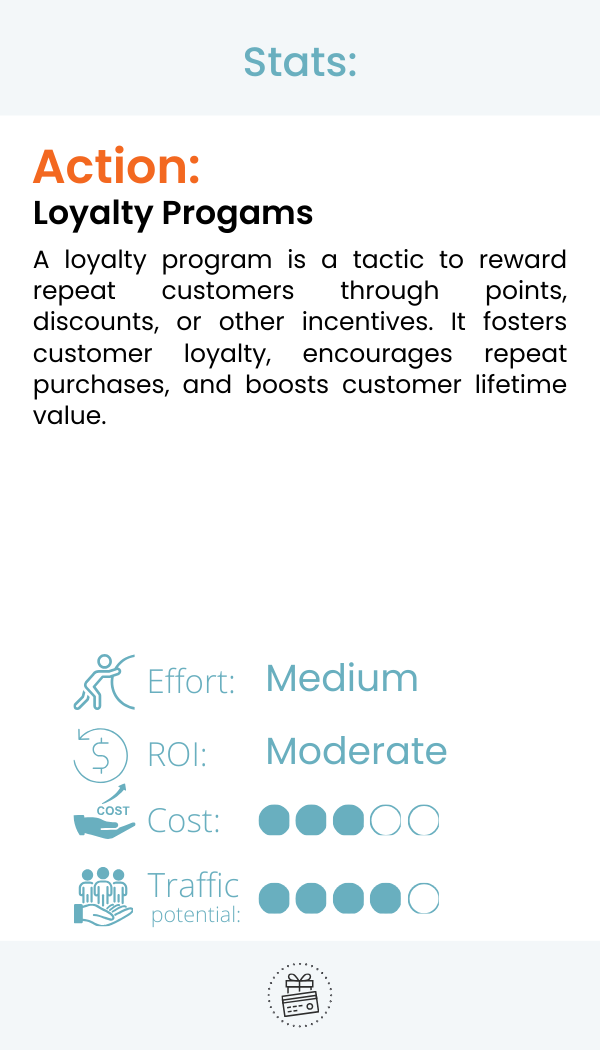
A loyalty program is a marketing tactic designed to incentivize repeat purchases and foster customer loyalty. Businesses create these programs to reward customers for their ongoing support, typically through points, discounts, free products, or exclusive access to events or content. By offering incentives for continued engagement, businesses aim to build stronger relationships with their existing customer base, encourage repeat purchases, and ultimately increase customer lifetime value. While loyalty programs may not yield quick or immediate returns, they can be effective in building brand loyalty and long-term customer relationships.
Ratings for Loyalty Program Marketing Tactic:
Effort Level: Medium – Implementing a loyalty program involves planning and setting up the program, designing reward structures, and managing customer engagement. While it’s not as resource-intensive as some high-effort tactics, it does require ongoing effort to maintain and improve the program’s effectiveness.
ROI: Moderate ROI (Medium-term tactics) – Loyalty programs are typically designed for the medium to long term. They aim to build customer loyalty and repeat business over time, which may take a few months to a year or more to show substantial returns. While they may not provide immediate results like quick ROI tactics, they can yield moderate returns as customers continue to engage with the program.
Cost: Medium – The cost of implementing and running a loyalty program can vary depending on factors such as the type of rewards offered, program management software, and promotional expenses. It falls into the medium-cost category, requiring an ongoing budget to maintain customer engagement and deliver rewards.
Traffic and Lead Generation: Moderate-loyalty programs primarily focus on retaining existing customers rather than generating new leads. However, they can indirectly contribute to moderate traffic by encouraging repeat business and word-of-mouth referrals from loyal customers. The main goal is to increase customer retention and boost revenue from existing clientele.
Industries That Would Benefit Most
Retail Companies: Loyalty programs can significantly benefit retail businesses by encouraging repeat purchases, building customer loyalty, and increasing customer lifetime value.
Restaurants: Restaurants can use loyalty programs to reward frequent diners, enhance customer retention, and promote repeat visits.
Hospitality: Hotels and resorts can implement loyalty programs to incentivize repeat bookings and create a loyal customer base, which can be particularly effective in the travel industry.
Consumer Goods: Companies in the consumer goods sector, including manufacturers of products like cosmetics, electronics, or clothing, can utilize loyalty programs to retain customers and drive brand loyalty.
Finance/Insurance: Financial institutions and insurance companies can benefit from loyalty programs to reward customer loyalty and encourage the use of multiple services or products.
Healthcare Services: Loyalty programs can be applied in healthcare to improve patient retention, encourage regular check-ups, and foster ongoing patient-doctor relationships.
These industries are well-suited to leverage loyalty programs to enhance customer engagement, repeat business, and long-term brand loyalty.
Remarketing or Retargeting
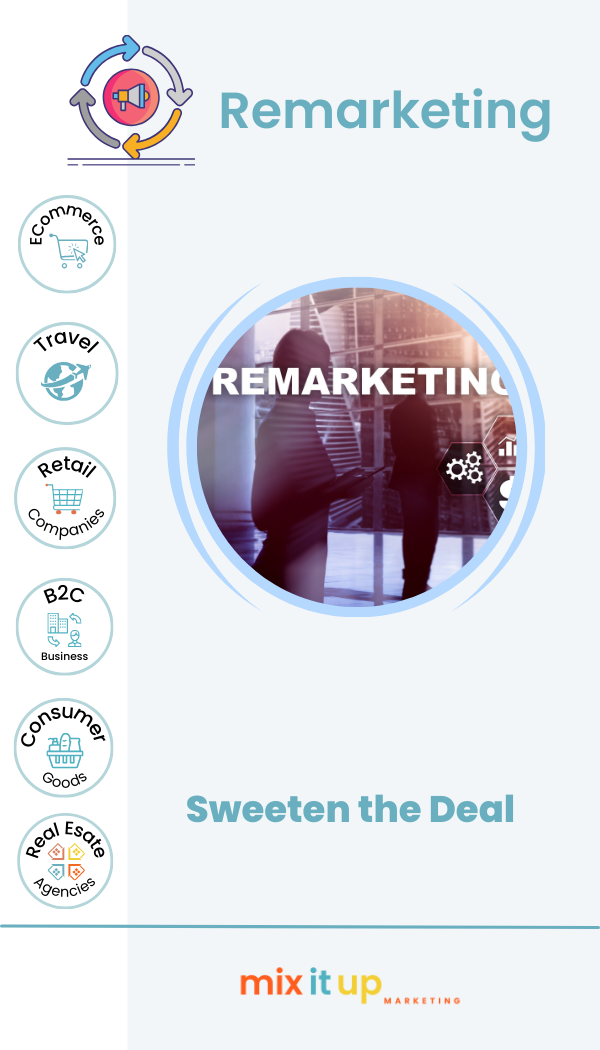
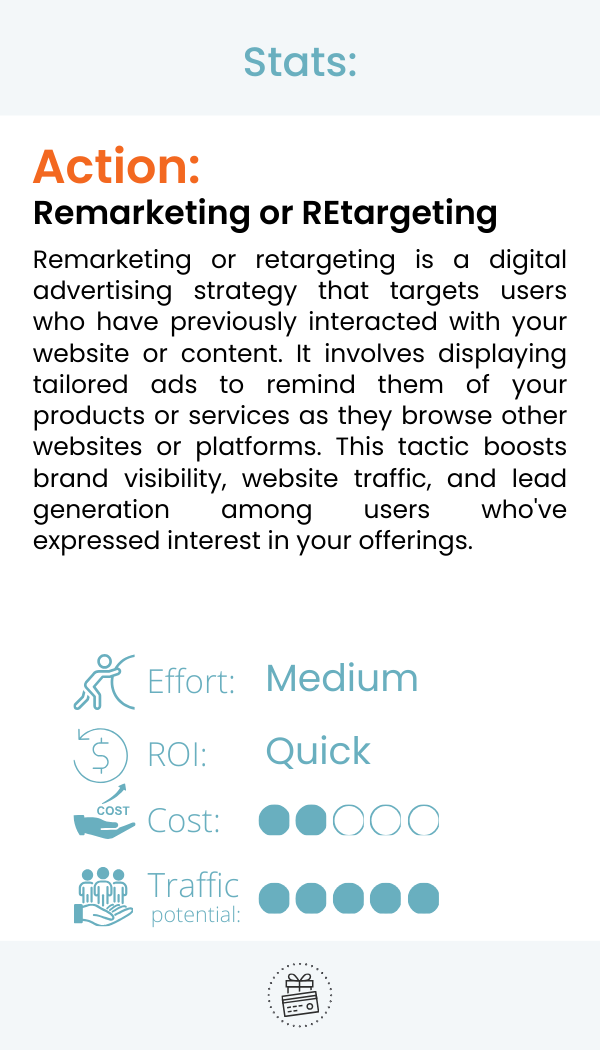
Remarketing or retargeting is a digital advertising strategy that targets users who have previously interacted with your website or content. It works by displaying tailored ads to these users as they browse other websites or social media platforms, reminding them of your products or services. This tactic is particularly effective for bringing back visitors who didn’t complete a desired action, such as making a purchase or filling out a contact form. It’s a valuable tool for increasing brand visibility, website traffic, and lead generation among users who have already shown an interest in your offerings.
Ratings for Remarketing or Retargeting Marketing Tactic:
Effort Level: Medium – Remarketing or retargeting involves setting up and managing online advertising campaigns to target users who have previously visited your website or interacted with your content. While it may require some initial setup and ongoing campaign management, it doesn’t involve creating new content or strategies. Medium effort is assigned due to the need for careful audience segmentation, ad creation, and monitoring.
ROI: Quick ROI (Short-term tactics) –Remarketing can deliver relatively quick results because it focuses on re-engaging with visitors who have already shown interest in your products or services. By reminding them of your offerings, you can prompt quicker conversions and realize a faster return on investment.
Cost: Low to Medium – The cost of remarketing can vary depending on the advertising platform, your audience size, and your industry’s competitiveness. Generally, it falls into the low to medium-cost range. You control your budget, making it accessible for businesses with varying financial resources.
Traffic and Lead Generation: High – Remarketing is a potent tactic for driving website traffic and generating leads. It helps re-engage users already familiar with your brand, increasing the likelihood of conversions. By strategically targeting those who have shown interest, you can see higher website traffic and lead generation than broader advertising approaches.
Industries That Would Benefit
E-commerce: Remind online shoppers of products they viewed but didn’t purchase, encouraging them to return and complete the transaction.
Travel: Target travelers who have explored your vacation packages or hotel deals but haven’t booked yet.
Retail Companies: Re-engage previous customers with personalized offers, driving them back to your online or brick-and-mortar store.
B2C (Business-to-Consumer): Reconnect with consumers interested in your products or services, especially those who abandoned their shopping carts.
Consumer Goods: Encourage brand loyalty and repeat purchases by reminding customers of your products and promotions.
Real Estate: Retarget potential homebuyers who have visited your property listings or property valuation pages.
Healthcare Services: Re-engage website visitors who explored your medical services or appointment booking but didn’t take action.
Education: Target prospective students who have shown interest in your courses or programs, motivating them to enroll.
Professional Services: Remind clients of your legal, financial, or consulting services, encouraging them to contact you for assistance.
Finance/Insurance: Retarget users who have researched insurance plans or financial products on your website, driving them to request quotes or more information.
Let Others Speak For You
Influencer Marketing
- Brand Ambassadors
- Affiliate Programs

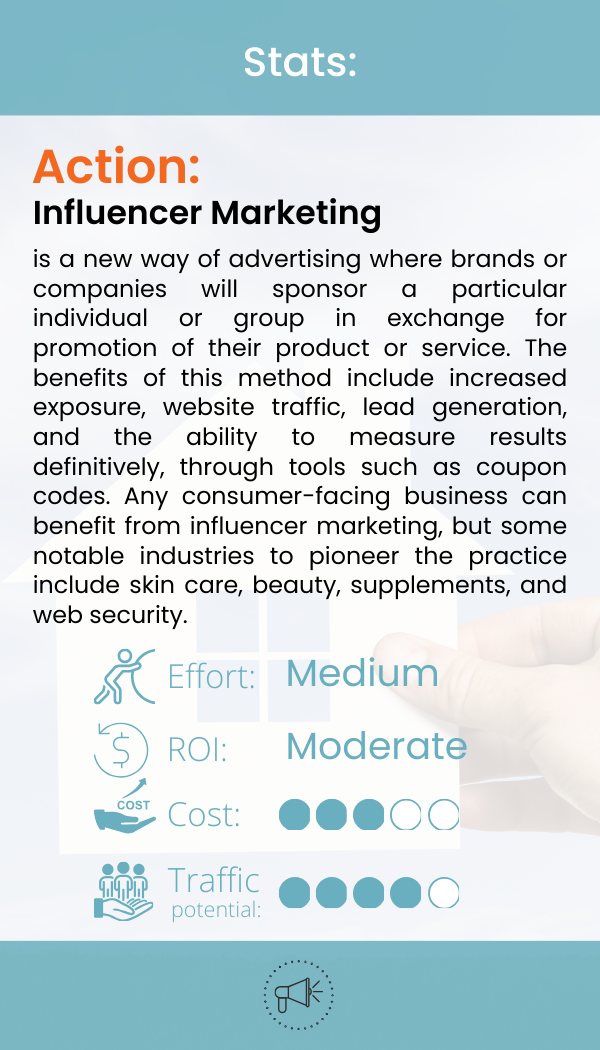
Influencer Marketing is a new way of advertising where brands or companies will sponsor a particular individual or group in exchange for the promotion of their product or service. The benefits of this method include increased exposure, website traffic, lead generation, and the ability to measure results definitively through tools such as coupon codes. Any consumer-facing business can benefit from influencer marketing, but some notable industries to pioneer the practice include skin care, beauty, supplements, and web security.
- Ratings for Influencer Marketing Tactic:
Effort: Medium Effort – Setting up and managing influencer marketing campaigns, selecting the right brand ambassadors, and running affiliate programs require a moderate level of effort. It involves careful planning, coordination, and ongoing relationship management.
Return on Investment: Moderate ROI – Influencer marketing can generate a good return on investment within a few months. It leverages the influencers’ existing audience and trust, helping in brand promotion and lead generation.
Cost: Medium Cost – Costs vary depending on the influencers’ reach and reputation. There’s often a balance between paying for more prominent influencers or opting for several smaller, niche influencers. Monthly costs can range from $500 to $2,000.
Website Traffic and Lead Generation: Moderate Traffic – Influencer marketing can drive a moderate amount of traffic and leads. The effectiveness depends on the influencer’s audience size and engagement rates.
Industries That Would Benefit
- Health and Beauty: Collaborating with influencers for product demonstrations and reviews.
- Fitness and Wellness: Partnering with fitness influencers for product endorsements or program promotions.
- E-commerce: Utilizing influencers to showcase products, driving traffic to online stores.
- Consumer Goods: Influencers can help in unboxing and reviewing consumer goods, enhancing brand visibility.
- Fashion and Apparel: Fashion influencers can significantly boost brand awareness through outfit showcases.
- Travel: Travel influencers can promote destinations, accommodations, and travel services.
- Technology and IT Services: Tech influencers can provide in-depth reviews and tutorials on tech products or services.
- Food and Beverage: Food influencers can create recipes or showcase products, ideal for craft food products or restaurants.
- Healthcare Services: Influencers can share personal stories or informational content related to healthcare services.
- Event Planning and Management: Influencers can showcase event highlights, enhancing brand exposure and client acquisition.
Reviews
- Google Business Profile (formally Google My Business)
- Yelp
- AirBnB
- Trip Advisor

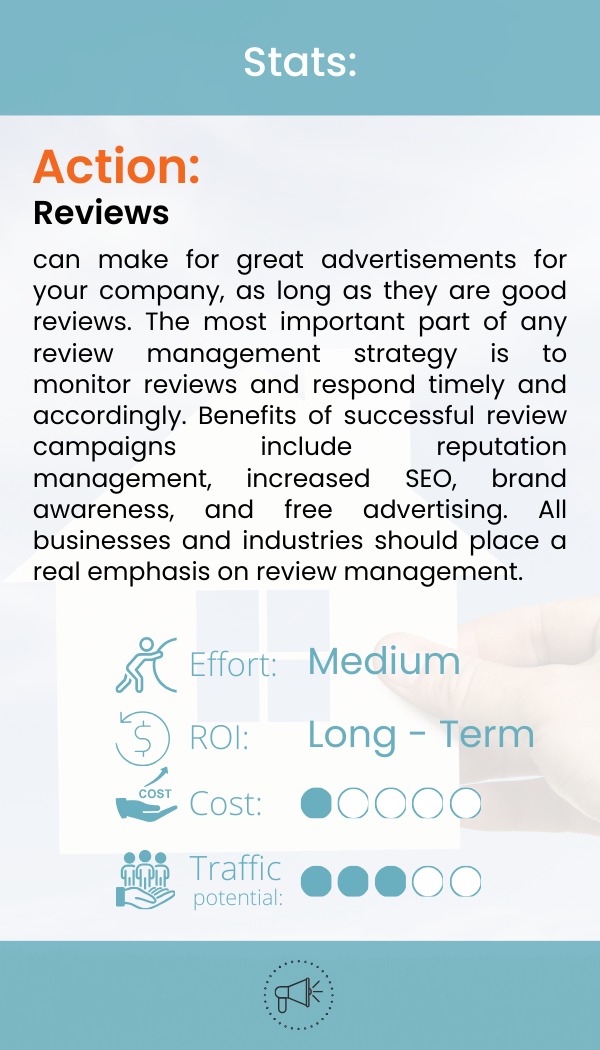
Reviews can make for great advertisements for your company, as long as they are good reviews. The most crucial part of any review management strategy is monitoring reviews and responding promptly and accordingly. The benefits of successful review campaigns include reputation management, increased SEO, brand awareness, and free advertising. All businesses and industries should place a real emphasis on review management.
Ratings for Reviews Marketing Tactic:
Effort: Medium Effort – It involves moderate work in encouraging customers to leave reviews and managing the responses.
Return on Investment: Longer-term ROI – Reviews build trust and reputation over time, contributing to long-term growth and customer acquisition.
Cost: Lowest Cost – Primarily requires time and effort to encourage reviews; no direct financial cost unless incentivizing reviews.
Traffic Potential: Medium Traffic – Positive reviews can enhance online visibility and credibility, leading to moderate increases in website traffic and lead generation.
Industries That Would Benefit
Hospitality and Travel Businesses (e.g., hotels, travel agencies): Positive reviews on these platforms can significantly enhance visibility and trust among travelers.
Restaurants and Craft Food Products: Reviews can influence customer choices, showcasing the quality of food and service.
Real Estate: Positive experiences shared by clients can bolster an agent’s or agency’s reputation, aiding in attracting new clients.
Healthcare Services: Patient reviews can build trust and showcase the quality of care provided.
Personal Services (e.g., beauty salons, therapists): Reviews act as personal recommendations, crucial for service-oriented businesses.
Fitness and Wellness Centers: Testimonials about positive health outcomes can attract new clients.
Retail Companies and E-commerce: Reviews help in validating product quality and customer service, influencing purchase decisions.
Home Improvement and Renovation Services: Positive feedback can significantly influence homeowners’ hiring decisions.
Pet Services: Trust is a key factor; reviews can provide reassurance to pet owners.
Legal and Financial Services: Reviews can enhance credibility and trustworthiness in these sensitive sectors.
Positive reviews can enhance a company’s reputation, attract new customers, and build trust in various business domains.
Referral/ Word of Mouth
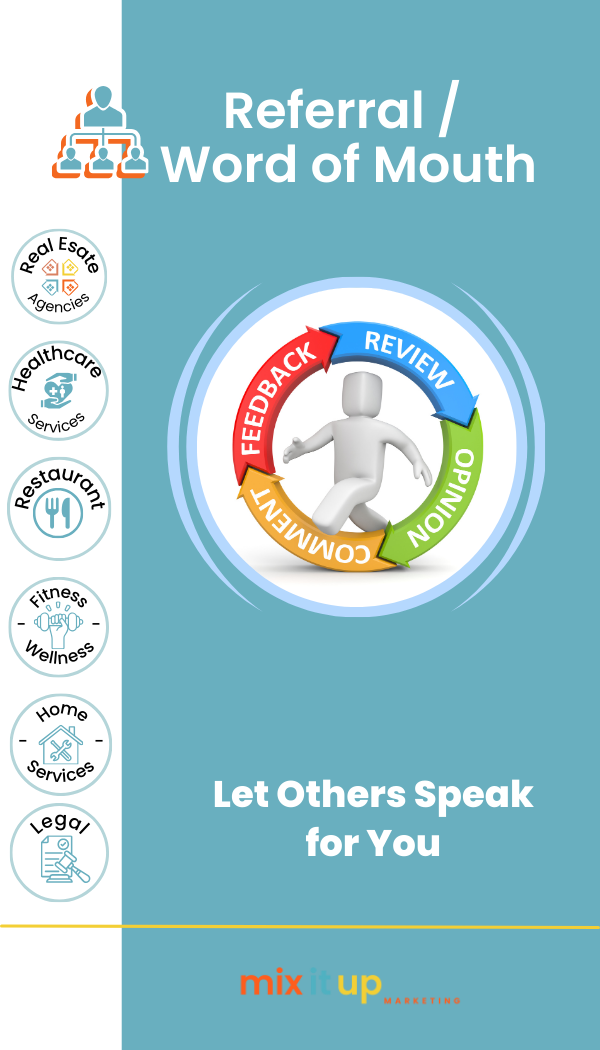
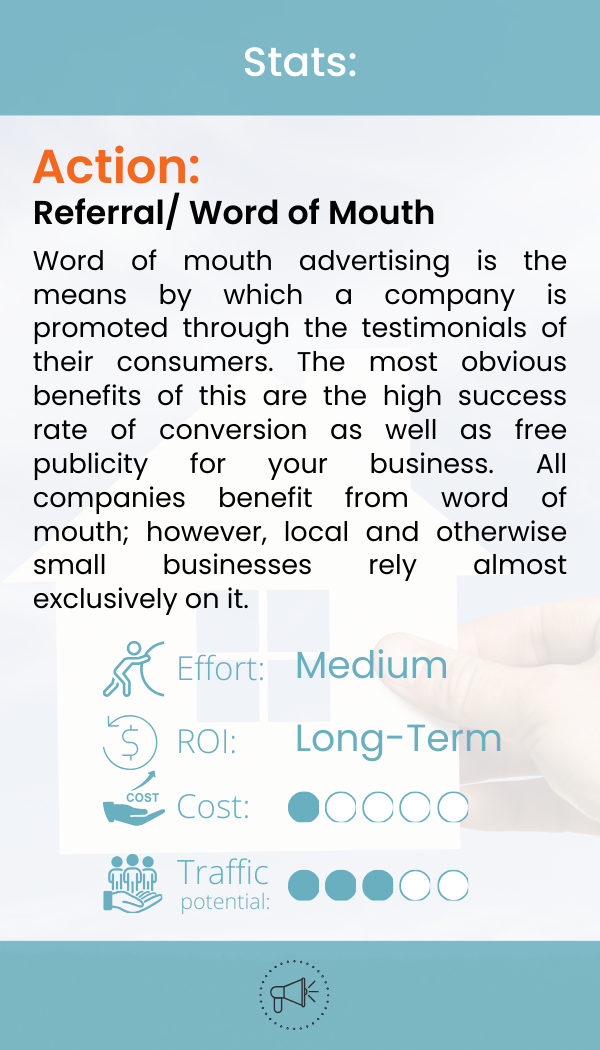
Word-of-mouth advertising is how a company is promoted through the testimonials of its consumers. The most obvious benefits of this are the high success rate of conversion as well as free publicity for your business. All companies benefit from word of mouth; however, local and otherwise small businesses rely almost exclusively on it.
Ratings for Word or Mouth Marketing Tactic:
Effort: Medium Effort – Establishing a successful referral or word-of-mouth program involves moderate effort. It requires strategic planning to incentivize and encourage customers to refer others and some level of management to track referrals and maintain engagement.
Return on Investment: Longer-term ROI – Referral and word-of-mouth marketing often takes time to build momentum but can result in sustained high-quality customer engagement and loyalty.
Cost: Lowest Cost – This tactic often incurs minimal financial expenses as it leverages existing customer relationships and networks, relying more on organic, person-to-person interactions.
Website Traffic/Lead Generation: Medium Traffic – Referral and word-of-mouth can drive moderate traffic and leads. The leads generated are often of high quality, though the volume may not be as high as in tactics like PPC advertising.
Industries That Would Benefit
Real Estate: Clients often trust recommendations from friends or family when choosing real estate agents. A referral program can significantly increase credibility and client base.
Healthcare Services: Patients are likely to trust recommendations from people they know when choosing healthcare providers.
Restaurants: Positive word-of-mouth is crucial for restaurants, as personal recommendations can drive more diners.
Fitness and Wellness: Personal referrals are a significant source of new clients for gyms, personal trainers, and wellness centers.
Legal Services: Trust plays a vital role in selecting legal services, and referrals can be a primary driver of new clients.
Home Improvement and Renovation: Satisfied customers recommending services to friends and family can be a primary source of new business.
Pet Services: Pet owners often rely on recommendations from other pet owners when choosing services like grooming or boarding.
Personal Services: Services like hairdressing, massage therapy, and beauty services often grow their client base through word-of-mouth.
Event Planning and Management: A strong referral network is crucial for event planners, as clients often rely on trusted recommendations.
Technology and IT Services: Referrals can help in building trust and credibility, especially for services that require technical expertise.
It’s important to note that virtually any industry can benefit from word-of-mouth marketing, as it reflects the trust and confidence of existing customers. Encouraging and actively managing referrals and positive testimonials can be a valuable strategy for small businesses across various sectors.
Partner with other relevant businesses

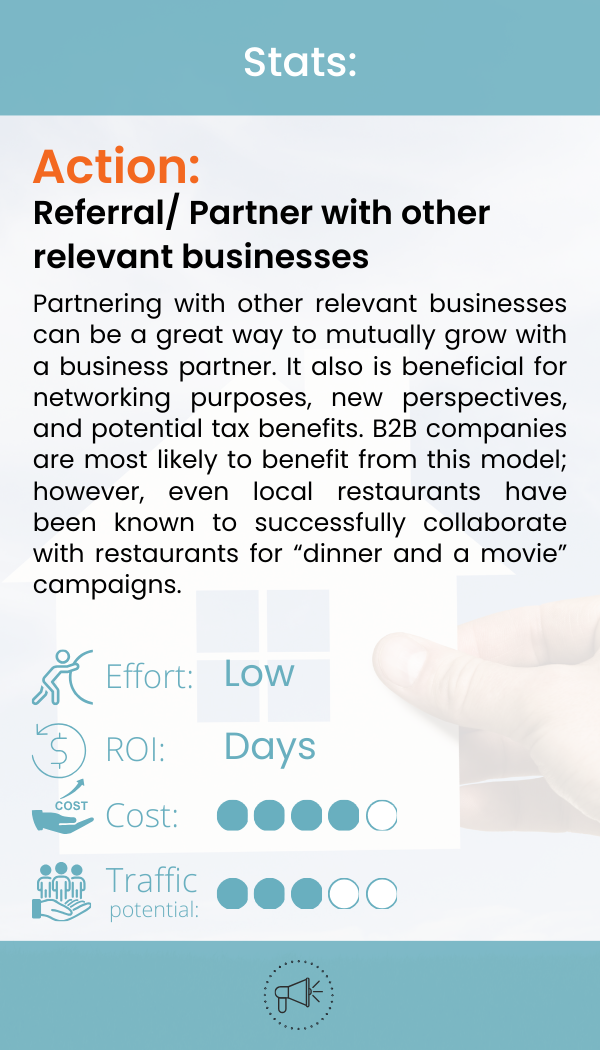
Partnering with other relevant businesses can be a great way to grow mutually with a business partner. It is also beneficial for networking purposes, new perspectives, and potential tax benefits. B2B companies are most likely to benefit from this model; however, even local restaurants have been known to successfully collaborate with restaurants for “dinner and a movie” campaigns.
Ratings for Partnerships Marketing Tactic:
Effort: Medium Effort – Establishing partnerships with other businesses involves moderate planning, negotiation, and alignment of goals.
Return on Investment: Longer-term ROI – These partnerships often require time to build and yield results, focusing on long-term growth and mutual benefits.
Cost: Low Cost – Generally, the cost is minimal as it’s more about mutual benefit and resource sharing than financial expenditure.
Website Traffic and Lead Generation: Medium Traffic – Partnering with other businesses can provide a moderate boost in traffic and leads through cross-promotion and shared audiences.
Industries That Would Benefit
- Real Estate: Partnerships with home improvement services or furniture stores could offer clients special deals, enhancing service value.
- Healthcare Services: Collaborating with fitness and wellness centers can provide holistic health solutions to clients.
- Hospitality and Travel: Partnering with travel agencies or event planners can create comprehensive travel packages.
- Education: Educational institutions could partner with technology providers for advanced learning tools.
- Finance/Insurance: Partnerships with legal services can offer comprehensive financial planning packages.
- Consumer Goods: Collaborating with e-commerce platforms can broaden market reach.
- Restaurants and Craft Food Products: Partnering with local farmers markets or food festivals for ingredient sourcing and promotion.
- Fitness and Wellness: Collaborations with health food stores or wellness apps can offer clients a more rounded health solution.
- Technology and IT Services: Partnering with educational institutions or businesses for technology solutions.
- Event Planning and Management: Collaborating with entertainment services or hospitality venues for comprehensive event packages.
Collaboration with other businesses can lead to mutual benefits, including increased exposure, expanded customer bases, and cost-effective marketing efforts.
User-Generated Content (UGC)

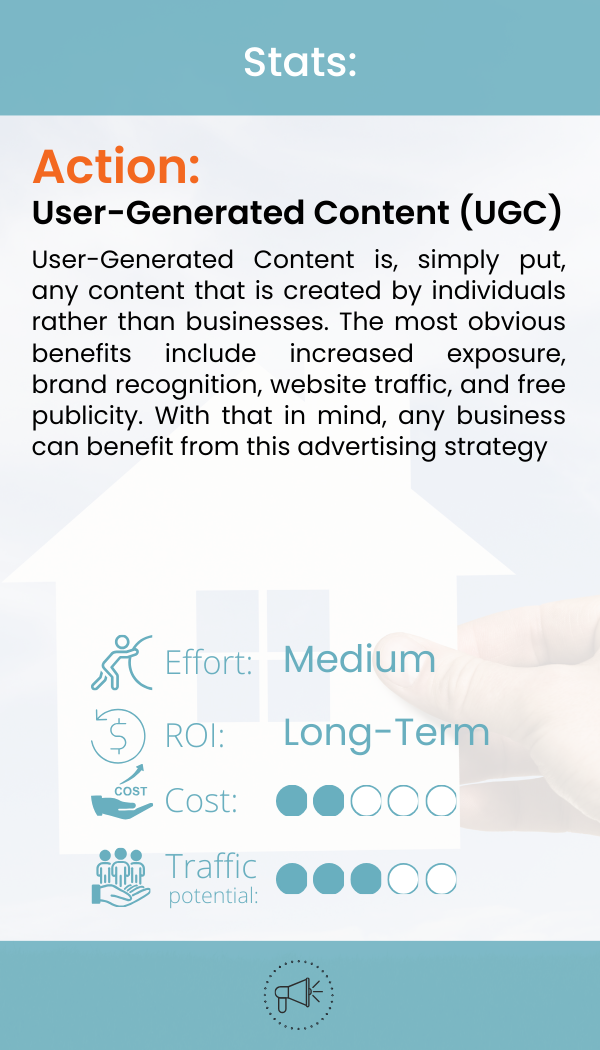
User-generated content is any content created by individuals rather than businesses. The most obvious benefits include increased exposure, brand recognition, website traffic, and free publicity. With that in mind, any business can benefit from this advertising strategy.
Ratings for User-Generated Content Marketing Tactic:
Effort: Medium Effort – Implementing UGC requires a moderate level of effort. It involves strategizing to encourage content creation by users, monitoring submissions, and managing how this content is shared and integrated into your marketing.
Return on Investment: Longer-term ROI – UGC can significantly enhance trust and engagement over time, helping build a community around the brand. It’s not an instant ROI strategy but pays off by fostering authentic connections and brand loyalty.
Cost: Lowest Cost – UGC primarily relies on content created by customers or fans, thus incurring minimal financial expenses. The primary investment is time and effort to manage and curate this content.
Traffic Potential: Medium Traffic – UGC can moderately drive website traffic and lead generation. It boosts engagement and can lead to increased traffic through social shares and enhanced search engine optimization (SEO) due to original and diverse content.
Industries That Would Benefit
- E-commerce: Customers sharing their purchases or experiences can significantly boost trust and engagement.
- Fitness and Wellness: Users sharing their fitness journeys or wellness tips can create a community feel.
- Health and Beauty: Customers posting before-and-after photos or product reviews.
- Restaurants: Patrons sharing their dining experiences or favorite dishes.
- Travel: Travellers sharing their experiences, photos, and reviews of destinations.
- Hospitality: Guests posting about their stays or experiences at hotels or resorts.
- Retail Companies: Customers showcasing how they use or style products.
- Art and Creative Services: Sharing creations or results of art services.
- Technology and IT Services: Users sharing their experiences with tech products or IT solutions.
- Pet Services: Pet owners share photos or stories about their pets’ experiences with services.
Remember that the effectiveness of UGC can vary depending on how well it aligns with a brand’s image and the level of customer engagement. Properly curated and managed UGC can boost trust and engagement across various industries.
Conversion Rate Optimization (CRO)
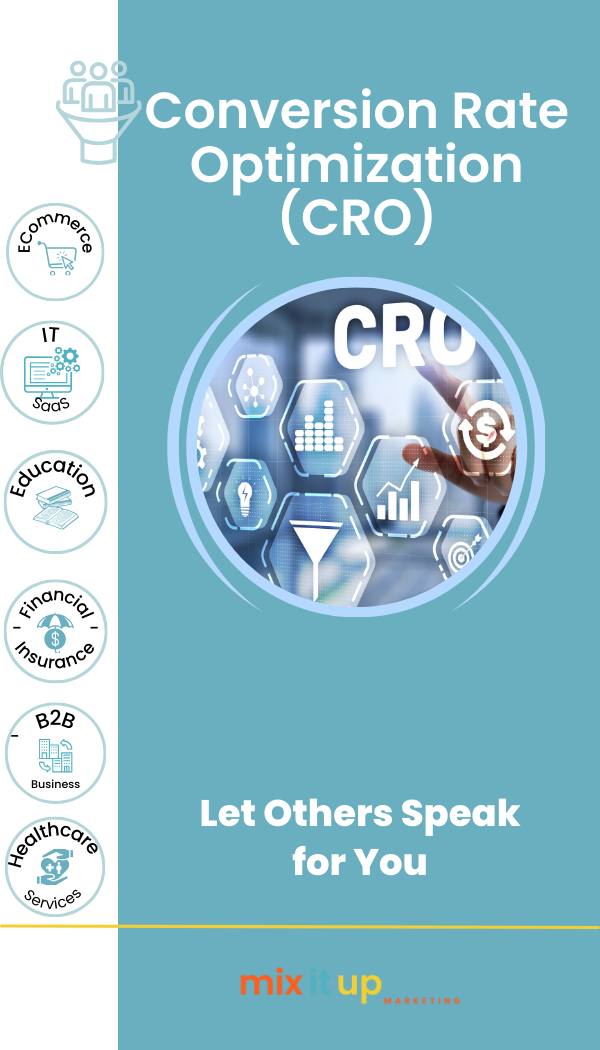
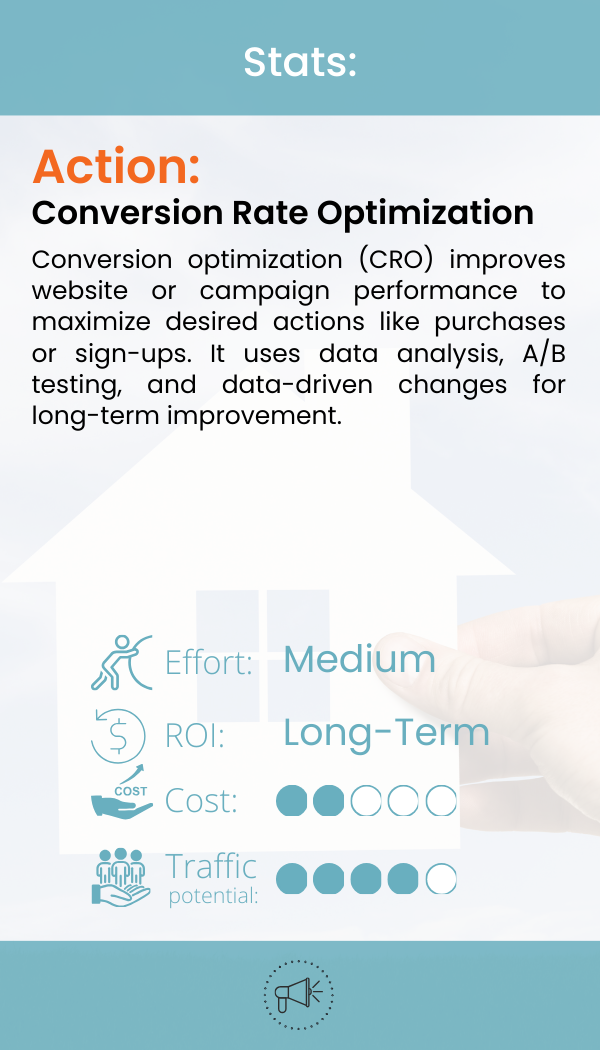
Conversion optimization, often referred to as CRO (Conversion Rate Optimization), is the process of improving the performance of a website or marketing campaign to maximize the number of visitors who take desired actions, such as making a purchase, signing up, or requesting more information. It involves analyzing user behavior, conducting A/B testing, and making data-driven changes to optimize the user experience and increase conversions. While it may not provide immediate results, it is a crucial strategy for businesses looking to improve their online performance over time.
Ratings for Conversion Rate Optimization (CRO) Marketing Tactic:
Effort Level: Medium – Conversion optimization involves analyzing website or marketing data, conducting A/B testing, and making adjustments based on findings, making it a moderate-effort task.
ROI: Longer-term ROI –Conversion optimization requires ongoing effort and time to see substantial results.
Cost: Low to Medium – Costs vary from minor adjustments to hiring specialists or advanced tools, ranging from low to medium.
Traffic and Lead Generation: Moderate – Focuses on improving existing traffic’s conversion efficiency rather than direct generation.
Industries That Would Benefit
1. E-commerce: Optimizing product pages and checkout processes to increase online sales.
2. Software as a Service (SaaS): Improving trial-to-paid conversions for subscription-based software.
3. Online Education: Enhancing enrollment and course completion rates on e-learning platforms.
4. Financial Services: Increasing lead conversions for financial product inquiries.
5. Healthcare Services: Optimizing appointment booking and patient registration processes.
6. B2B Technology: Improving lead generation and sales conversions for tech companies.
7. Real Estate: Enhancing lead-to-client conversions for real estate agencies.
8. Travel and Hospitality: Increasing booking conversions for hotels and travel agencies.
9. Nonprofit Organizations: Optimizing donation and volunteer sign-up processes.
10. Automotive Sales and Services: Improving lead conversions for car dealerships and service centers.
Building Community
Start Groups (FB & LinkedIn)
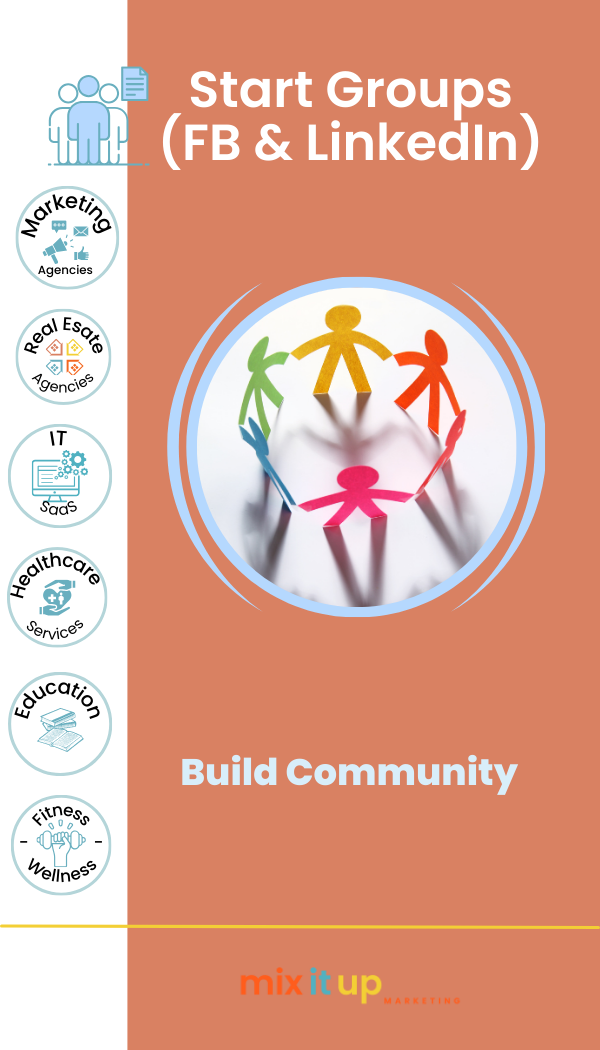
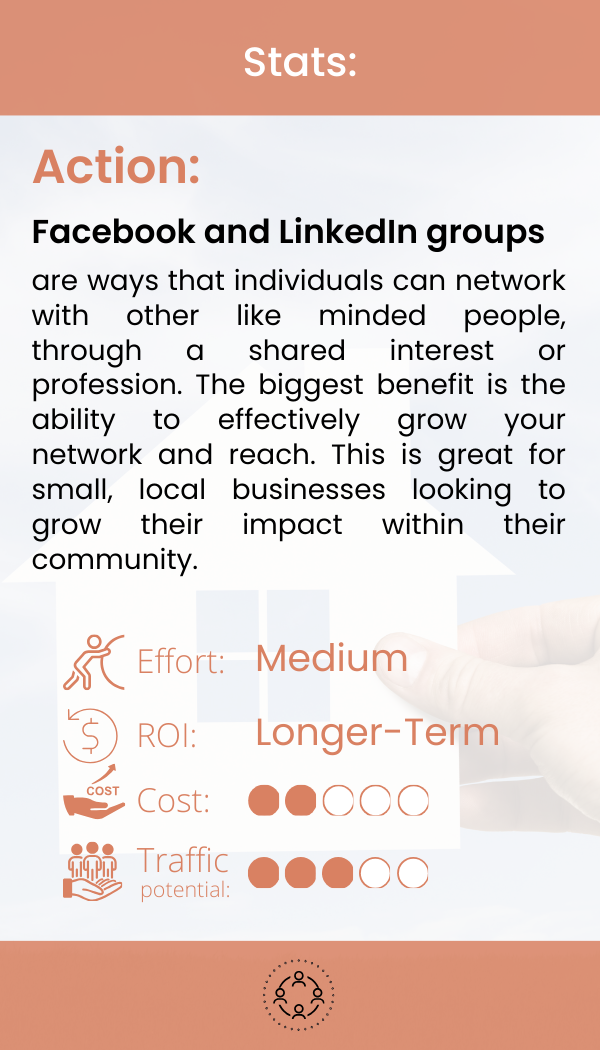
Facebook and LinkedIn groups are ways that individuals can network with other like-minded people through a shared interest or profession. The most significant benefit is the ability to grow your network and reach effectively. This is great for small, local businesses looking to expand their impact within their community.
Ratings for Hosting Events Marketing Tactic:
Effort: Medium Effort – Starting and managing groups on platforms like LinkedIn or Facebook requires a moderate level of time and resources, including content creation, community engagement, and consistent monitoring.
Return on Investment: Longer-term ROI – Building a community and establishing a group’s presence takes time, but it can yield substantial benefits in terms of engagement and brand loyalty over the long term.
Cost: Lowest Cost – This tactic primarily demands time and creativity rather than financial resources, making it accessible for businesses with limited budgets.
Traffic Potential: Medium Traffic – While groups may not drive high volumes of website traffic immediately, they foster community engagement and can lead to steady traffic growth and lead generation over time.
Industries That Would Benefit
- Real Estate: Real estate professionals can use groups to share market insights, property listings, and homeowner tips, fostering a community of potential clients and industry peers.
- Charity Organizations: These groups can serve as platforms for charity organizations to engage supporters, organize events, and discuss initiatives.
- Marketing Agencies: Agencies can create groups to share marketing tips, industry news, and case studies, positioning themselves as thought leaders.
- Healthcare Services: Healthcare providers can use groups to share health tips, news, and community health initiatives.
- Education: Educational institutions and professionals can utilize groups for discussions on educational resources, methodologies, and professional development.
- Finance/Insurance: These businesses can create groups focused on financial advice, insurance tips, and industry trends.
- Consumer Goods: Brands can engage with their customers, gather feedback, and share product updates.
- Fitness and Wellness: Groups can be used for sharing fitness tips, wellness advice, and organizing community challenges.
- Technology and IT Services: Tech companies can engage in discussions about tech trends, product developments, and industry news.
- Art and Creative Services: Artists and creatives can share their work, collaborate on projects, and discuss industry trends.
Industries can benefit from these groups by building relationships, fostering engagement, and providing value to their target audiences.
Host Events

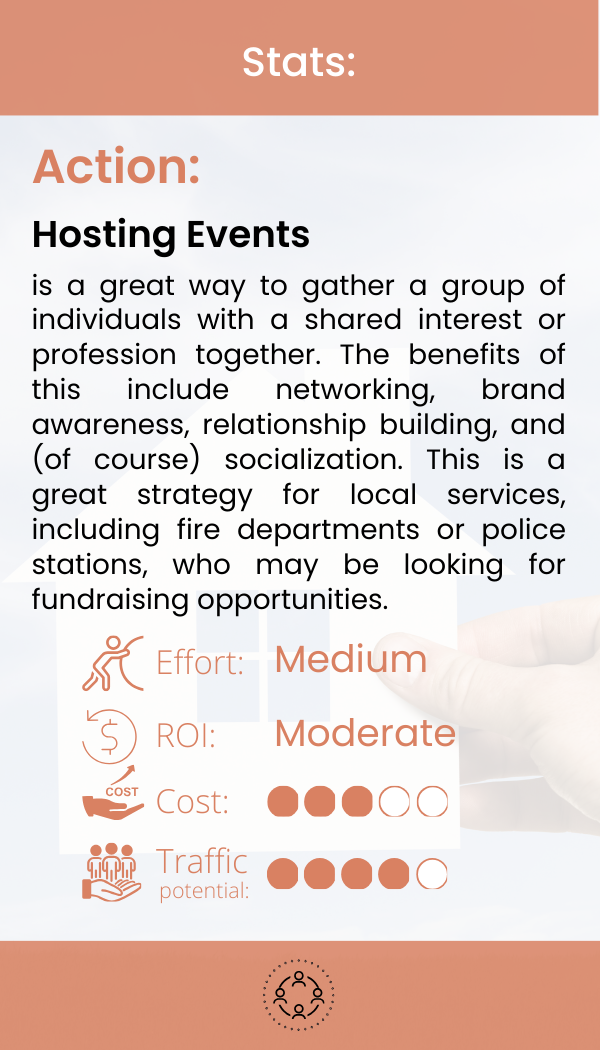
Hosting events is a great way to gather a group of individuals with a shared interest or profession together. The benefits of this include networking, brand awareness, relationship building, and (of course) socialization. This is a great strategy for local services, including fire departments or police stations, who may be looking for fundraising opportunities.
Ratings for Hosting Events Marketing Tactic:
Effort: Medium Effort – Hosting events requires planning, coordination, and resources, but it’s manageable with a dedicated approach.
Return on Investment: Moderate ROI – Events can foster community engagement and brand awareness, yielding sustainable results over a few months.
Cost: Medium Cost – Involves expenses for venue, logistics, and promotions, with a monthly cost range of $500 to $2,000.
Website Traffic and Lead Generation: Moderate Traffic – While not the highest in driving traffic, events can effectively generate leads and increase brand visibility.
Industries That Would Benefit
- Real Estate: Hosting homebuyer seminars or networking events can establish authority and generate leads.
- Charity Organizations: Benefit galas or community events can raise awareness and funds.
- Marketing Agencies: Industry conferences or workshops showcase expertise and attract potential clients.
- Healthcare Services: Health fairs or informational seminars can educate the public and promote services.
- Hospitality: Hosting themed events or experiences can attract guests and enhance brand image.
- Travel: Travel expos or destination showcases can attract travelers and partners.
- Education: Educational workshops or open days can attract students and showcase programs.
- Finance/Insurance: Financial literacy workshops or networking events can build trust and acquire clients.
- Consumer Goods: Product launch events or pop-up shops can create buzz and drive sales.
- Event Planning and Management: Showcasing services through well-executed events can lead to client acquisition.
The key is to align the event with the industry’s objectives and provide value to attendees.
Podcasting
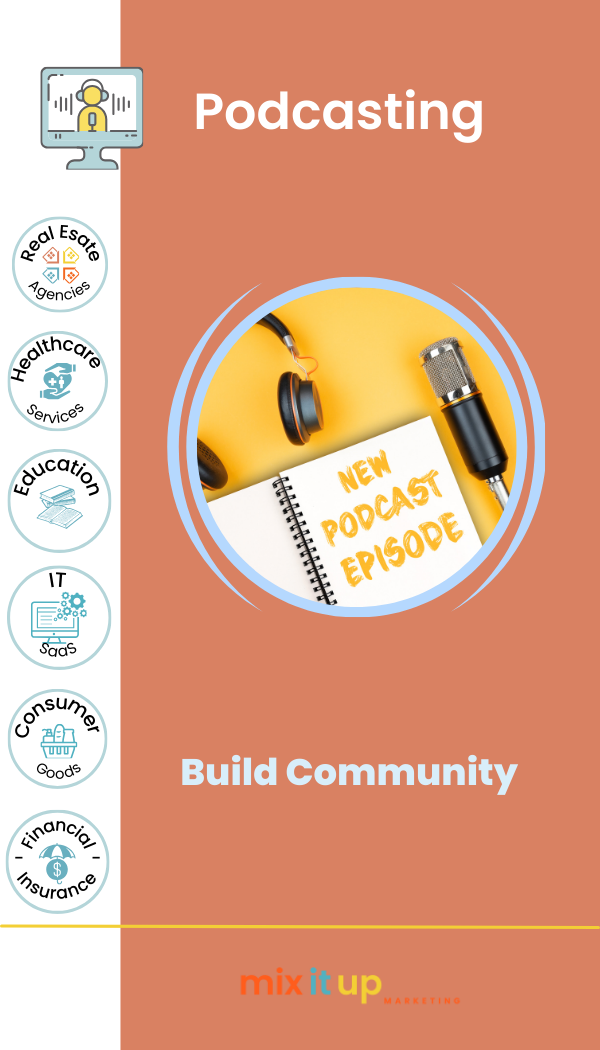
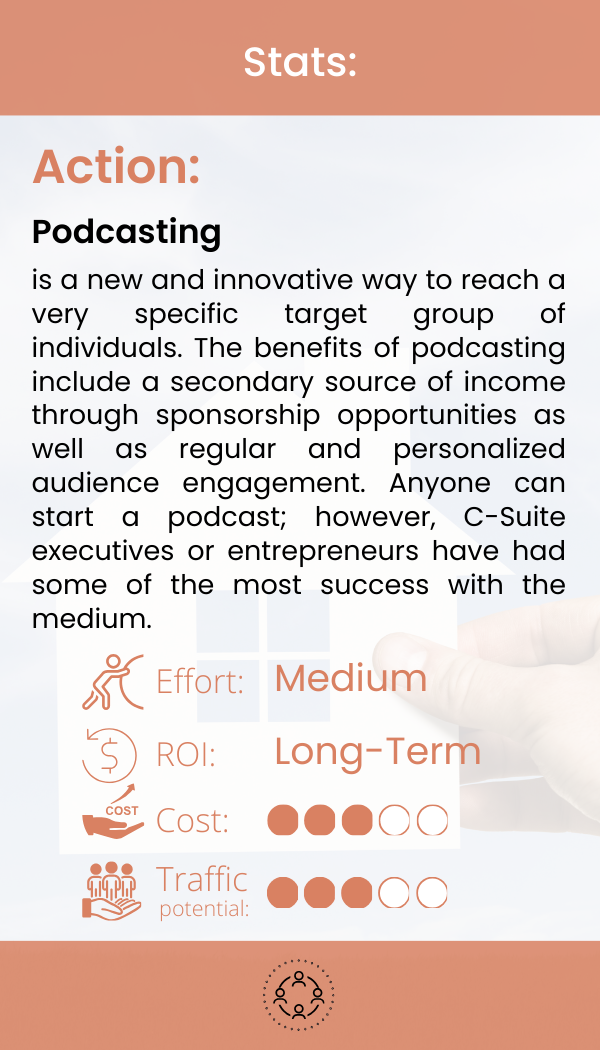
Podcasting is a new and innovative way to reach a very specific target group of individuals. The benefits of podcasting include a secondary source of income through sponsorship opportunities and regular and personalized audience engagement. Anyone can start a podcast; however, C-Suite executives or entrepreneurs have had some of the most success with the medium.
Ratings for Podcasting Marketing Tactic:
Effort: Medium Effort – Podcasting requires planning, recording, editing, and promoting episodes. It’s manageable but involves a consistent time commitment.
Return on Investment: Longer-term ROI –Podcasting is a long-term strategy that builds audience trust and brand authority over time.
Cost: Medium Cost – Initial setup costs (microphone, recording software) and ongoing production expenses are involved, but they’re generally moderate.
Traffic Potential: Medium Traffic – Podcasting can drive moderate traffic and leads, especially if the content aligns well with the target audience’s interests.
Industries That Would Benefit
- Real Estate: Sharing market insights, home buying tips, and interviews with industry experts.
- Healthcare Services: Discussing health tips, patient stories, and latest medical advancements.
- Hospitality: Featuring travel destinations, guest experiences, and insider tips.
- Education: Educational content, expert interviews, and learning strategies.
- Finance/Insurance: Financial advice, market trends, and customer success stories.
- Consumer Goods: Product stories, customer reviews, and behind-the-scenes insights.
- Fitness and Wellness: Health tips, fitness routines, and motivational stories.
- Technology and IT Services: Tech trends, product reviews, and industry insights.
- Legal Services: Legal advice, case studies, and industry updates.
- Agriculture and Farming: Farming techniques, sustainability practices, and market trends.
Cross Promotion
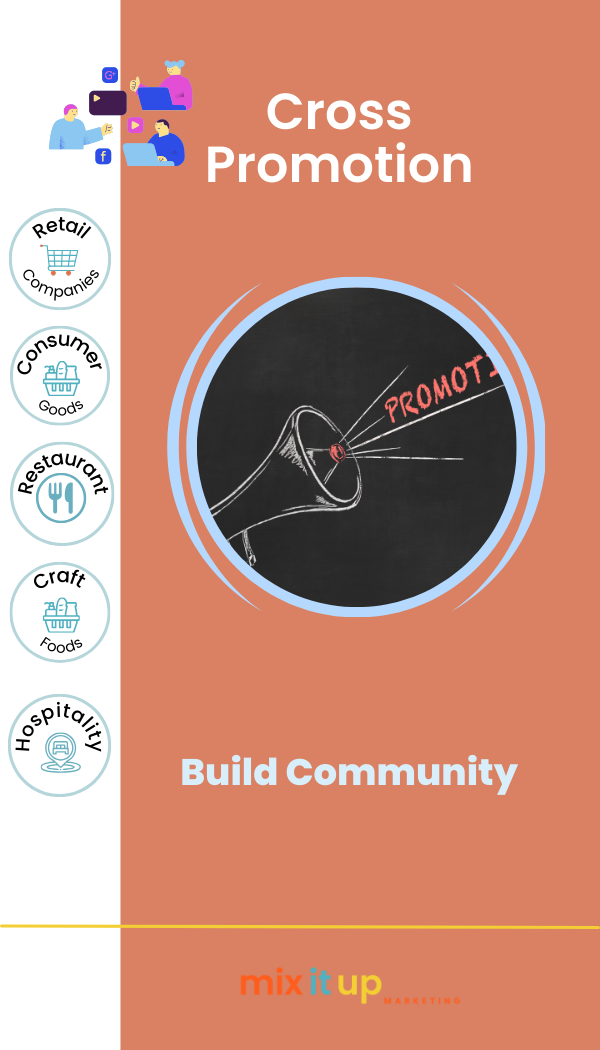
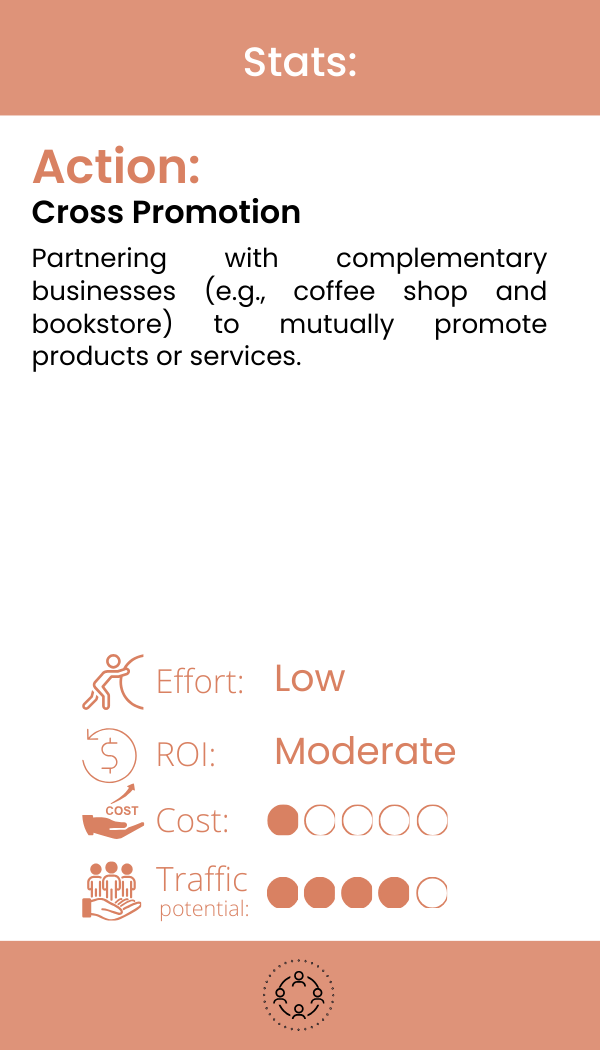
Partnering with complementary businesses (e.g., coffee shop and bookstore) to mutually promote products or services.
Ratings for Cross Promotion Marketing Tactic:
Effort Level: Low to Medium Cross promotion can vary in complexity. It may require identifying suitable partners, negotiating terms, and creating joint marketing materials. The effort level can be low when collaborating with a simple, local partner and increase with more complex partnerships.
ROI: Moderate ROI (Medium-term tactics) The ROI for cross promotion may not be immediate but can provide a moderate return over time. It relies on building relationships with partner businesses and gradually attracting new customers through joint promotions.
Cost: Low to Medium The cost of cross promotion depends on the scale of the partnership and the marketing materials involved. It can range from low (simple collaborations) to medium (more extensive joint marketing efforts).
Traffic and Lead Generation: Moderate Cross promotion can generate moderate traffic and leads by exposing your brand to the partner’s audience. While it may not result in an immediate high volume of leads, it can lead to steady customer acquisition when done strategically.
Industries That Would Benefit
Retail Companies: Cross promotion can work well for retail businesses that can partner with complementary brands or products to offer bundled promotions or discounts. For example, a clothing store can cross-promote with a shoe brand.
Consumer Goods: Similar to retail, consumer goods companies can benefit from cross-promotion by partnering with related products or brands. For instance, a coffee company can collaborate with a bakery for joint promotions.
Restaurants: Restaurants can cross-promote with nearby businesses, such as offering special deals in collaboration with a local theater or offering discounts with nearby food delivery services.
Craft Food Products: Businesses in this category can cross-promote with other food or beverage producers, creating unique pairings or promotions that appeal to food enthusiasts.
Hospitality: Hotels and resorts can partner with local attractions or tour operators to offer packages that include both accommodation and experiences, utilizing cross-promotion to enhance guest experiences.
Analytics

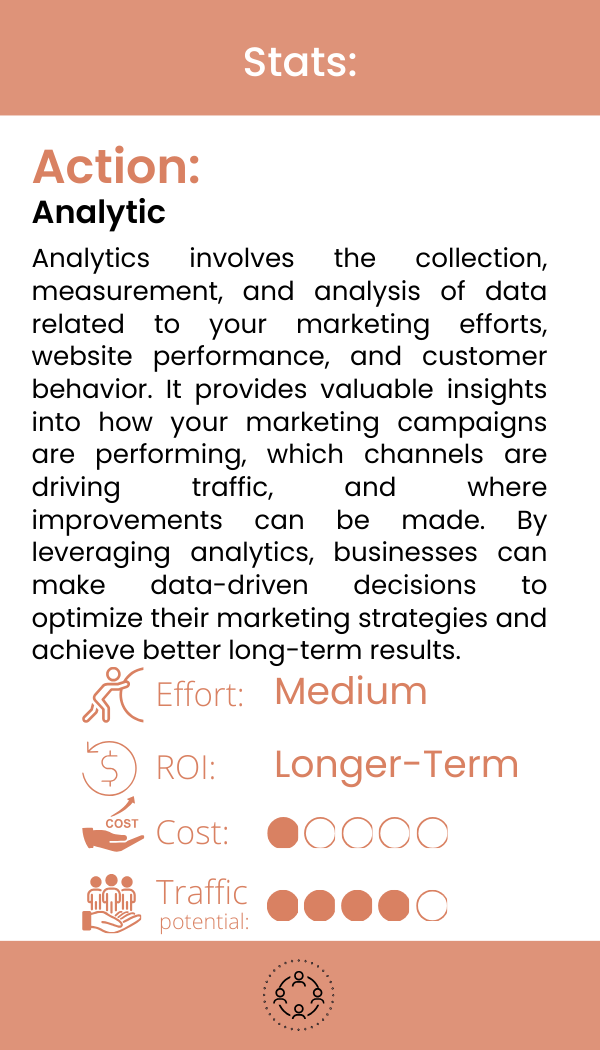
Analytics involves the collection, measurement, and analysis of data related to your marketing efforts, website performance, and customer behavior. It provides valuable insights into how your marketing campaigns are performing, which channels are driving traffic, and where improvements can be made. By leveraging analytics, businesses can make data-driven decisions to optimize their marketing strategies and achieve better long-term results.
Ratings for Analytics Marketing Tactic:
Effort Level: Medium – Implementing analytics tools and practices requires moderate effort. It involves setting up tracking mechanisms, defining key performance indicators (KPIs), and regularly analyzing data. While it’s not as resource-intensive as some tactics, it does demand consistent attention and ongoing optimization.
ROI: Longer-term ROI (Requires patience and consistency) – Analytics provides valuable insights into your marketing efforts and customer behavior, but the full benefits may not be immediately apparent. Over time, as you collect and analyze data, you can make more informed decisions and continuously improve your marketing strategy, leading to long-term returns.
Cost: Low to Medium – The cost of analytics can vary depending on the tools and resources used. There are free analytics platforms like Google Analytics, which are cost-effective for collecting primary data. However, for more advanced analytics and data integration, businesses may need to invest in paid analytics tools or hire analytics professionals, which can increase the cost.
Traffic and Lead Generation: Moderate – While analytics may not directly generate website traffic or leads, optimizing other marketing tactics to improve their effectiveness is crucial. Businesses can fine-tune their strategies using data-driven insights, resulting in better traffic generation and lead conversion across various industries.
Industries That Would Benefit
- E-commerce: Analytics helps e-commerce businesses track user behavior, optimize product listings, and enhance the customer shopping experience, leading to increased sales.
- Digital Marketing Agencies: Analytics tools enable agencies to measure the success of marketing campaigns, adjust strategies, and demonstrate ROI to clients.
- Finance/Insurance: Analyzing customer data can help financial and insurance companies better understand customer needs and tailor their services accordingly.
- Healthcare Services: Healthcare providers can use analytics to improve patient care, manage resources efficiently, and identify health trends.
- Retail Companies: Analytics assists retailers in inventory management, sales forecasting, and creating personalized shopping experiences for customers.
- B2B: Analytics helps B2B businesses track lead generation, conversion rates, and customer engagement to refine their marketing efforts.
- Real Estate: Real estate agencies can use analytics to track property performance, market trends, and customer preferences.
- Education: Educational institutions benefit from analytics by assessing student performance, optimizing course offerings, and improving learning outcomes.
- Travel: Analytics helps travel companies analyze booking patterns, customer reviews, and pricing strategies to enhance their services.
- Consumer Goods: Consumer goods manufacturers can optimize production, distribution, and marketing strategies using analytics-driven insights.
Mistakes to Avoid
Picking the right marketing tactics for your business is crucial for success, but it’s equally important to avoid common mistakes that can hinder your efforts. One of the most significant errors is attempting to do too much at once. While the list of available marketing tactics is extensive, remember that you can’t effectively implement them all. Here are some key pitfalls to avoid:
1. Spreading Yourself Too Thin
Trying to execute numerous marketing tactics simultaneously can lead to a lack of focus and dilution of resources. Prioritizing a select few that align with your goals, target audience, and resources is essential. Quality over quantity should be your mantra.
2. Loss of Focus and Momentum
When you spread your efforts across too many tactics, it’s challenging to maintain consistent messaging and branding. This loss of focus can confuse your audience and weaken your brand identity. It’s crucial to keep a clear and cohesive marketing strategy to build and sustain momentum.
3. Overwhelming Learning Curve
Each marketing tactic comes with its tools, techniques, and best practices. Attempting to master too many tactics simultaneously can overwhelm your team and lead to frustration. A steep learning curve can also slow down your marketing efforts.
4. Burnout and Inefficiency
Trying to do it all can lead to burnout among your marketing team or yourself as a business owner. It’s not sustainable to constantly juggle numerous tactics, leading to decreased efficiency and creativity.
The Key to Success:
Selecting Your Top 3
The most successful businesses understand that it’s not about doing everything—it’s about doing the right things exceptionally well. By selecting your top 3 marketing tactics, you can focus your energy, resources, and creativity where they matter most. This strategic approach allows you to:
Deepen Expertise: By concentrating on a few tactics, you can become an expert in those areas, maximizing their impact.
Consistency: Maintain a consistent and compelling brand image, messaging, and customer experience across your chosen tactics.
Efficiency: Allocate resources more efficiently and minimize wasted efforts.
Measurable Results: With focused efforts, you can better track and analyze the performance of your selected tactics, enabling data-driven decisions.
Remember that your choice of tactics should align with your business goals, target audience preferences, and available resources. Instead of trying to do it all, choose tactics to help you achieve your objectives effectively and sustainably.
Conclusion
Navigating the vast landscape of marketing can be both exciting and challenging for business owners. It’s tempting to explore every avenue, but it’s crucial to remember that you can’t excel at everything simultaneously. In this blog, we’ve emphasized the importance of avoiding common mistakes when selecting your top 3 marketing tactics.
As you embark on your marketing journey, here’s a piece of encouraging advice: pay close attention to what feels natural and manageable for you as a business owner. While it’s essential to align your tactics with your goals and resources, it’s equally vital to find joy and ease in your marketing efforts.
Success in marketing isn’t solely about following trends or adhering to rigid strategies. It’s about selecting tactics that resonate with your unique strengths and preferences. By doing so, you can not only achieve greater impact but also find fulfillment in the process.
Remember, marketing is a journey, and it’s okay to start small and gradually expand your efforts. Focus on the tactics that come more naturally to you, where your passion shines through, and where you feel confident. Over time, you can build upon this foundation and explore new tactics as your business grows.
In this dynamic field, adaptability and continuous improvement are key. So, embrace the tactics that align with your strengths, learn from your experiences, and stay open to new opportunities. With dedication, a clear focus, and an eye on what feels right for you, your marketing strategy will not only drive results but also bring a sense of fulfillment to your entrepreneurial journey.
Thank you!
Your point of view caught my eye and was very interesting. Thanks.
Cheers